lordroel
Administrator
Posts: 68,007 
Likes: 49,410
|
Post by lordroel on Apr 10, 2024 2:43:41 GMT
Day 2039 of World War II, April 10th 1945Western Front (1945) - Western Allied invasion of GermanyMap: HQ Twelfth Army Group situation map, April 10th 1945 British 2nd Army is advancing toward Bremen. Hanover falls to the US 13th Corps (part of US 9th Army). US 3rd Army advances toward Erfurt and US 7th Army advances toward Nuremberg. Photo: Soldiers of 5th Armored Division, 9th U.S. Army, inspect pile of German knives and firearms turned in by German civilians, when town of Peine, Germany, surrendered. 10 April, 1945 Photo: Men of 6th Airborne Division advancing near Brelingen, 10 April 1945. Note the handcarts and bicycles Photo: Men of 6th Airborne Division advancing near Brelingen, 10 April 1945. Note the handcarts and bicycles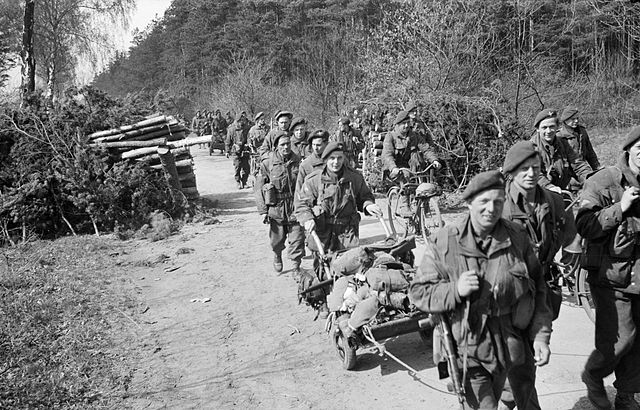 Western Front (1945) - Liberation of the Netherlands Western Front (1945) - Liberation of the NetherlandsForces of Canadian 1st Army pressure German positions in Holland and begin operations to cross the Ijssel River. Air War over Europe The US 8th Air Force launches its heaviest raid to date (1,232 bombers) against Berlin. Mission 938: 1,315 bombers and 905 fighters are dispatched to attack airfields known or suspected to be used by jet aircraft; about 60 jets and a few conventional fighters attack the formations; 19 bombers and 8 fighters are lost; the AAF claims 328-4-249 Luftwaffe aircraft. They are attacked by surface to air missiles. 278 B-17s bomb the Army HQ munitions depot and another 139 bomb the airfield at Oranienburg; 11 hit Rechlin Airfield, the secondary; they claim 7-1-8 aircraft; 9 B-17s are lost. Escorting are 273 P-51s; they claim 11.5-0-8 aircraft in the air and 56-0-32 on the ground; 4 P-51s are lost. 132 B-17s hit Neuruppin Airfield; 9 others hit the marshalling yard at Stendal, the secondary; 1 B-17 is lost . The escort of 112 P-51s claims 128-0-94 Luftwaffe aircraft on the ground; 1 P-51 is lost. 138 B-17s bomb the Briest Airfield at Brandenburg, 75 hit Zerbst Airfield and 147 attack Burg-Bei-Magdeburg Airfield; they claim 10-3-4 aircraft; 8 B-17s are lost. 172 P-51s escort; they claim 6-0-2 aircraft in the air and 84-0-43 on the ground; 2 P-51s are lost. 159 B-24s hit Rechlin Airfield, 103 bomb Larz Airfield at Rechlin (103) and 32 hit Parchim Airfield; 9 others hit the marshalling yard at Wittenberge, a target of opportunity; 1 B-24 is lost. The escort is 207 P-51s; they claim 1-0-1 aircraft in the air and 20-0-21 on the ground. At the JV 44 airfield at Riem, USAAF P-51s strafe the runway and damage three more Me 262s. Another raid at Burg destroys three more Me 262s of 10./NJG 11, formerly known as Kommando Welter. 423 Ninth Air Force A-20s, A-26 Invaders, and B-26s strike oil storage and ordnance depots, rail bridge and viaduct (all primary targets) and several other targets including a marshalling yard and an industrial area; fighters escort the bombers, fly patrols, rail cutting operations, and armed reconnaissance, and support the US 13th Armored Division crossing the Sieg River near Siegburg, the 3d Armored Division approaching Nordhausen, the 9th Armored Division in the Hain area, the XII Corps near Coburg, the XX Corps west of Weimar and the Saale River, the 2d and 5th Armored Divisions crossing the Oker River in the Ahnsen and Schladen areas, and the XVI Corps along the Ruhr River in the Essen area. 152 Fifteenth Air Force P-38s dive-bomb bridges, a tunnel and marshalling yards at Seefeld and Worgl. 230 RAF aircraft - 134 Lancasters, 90 Halifaxes, 6 Mosquitos - attacked the Engelsdorf and Mockau railway yards at Leipzig. The weather was clear and the bombing was accurate. 1 Halifax and 1 Lancaster lost. Plauen: 307 RAF Lancasters and 8 Mosquitos of Nos 1 and 8 Groups. No aircraft lost. The bombing fell around the railway yards in the northern half of the town. The railways were hit and 365 acres, 51 per cent, of the town's built-up area were also destroyed. 76 RAF Lancasters and 19 Mosquitos of 5 and 8 Groups attacked the Wahren railway yards, Leipzig. The eastern half of the yards was destroyed. 7 Lancasters lost. 77 RAF Mosquitos to Berlin, 21 to Chemnitz and 7 to Bayreuth, 53 RCM sorties, 26 Mosquito patrols. 1 Mosquito from the Berlin raid and 1 RCM Halifax were lost. Italian campaign New Zealand troops reached Santerno River in northern Italy. After sundown, British V Corps launched Operation Impact Plain toward Argenta, Italy. First came 234 US medium bombers, which dropped 24,000 20-pound incendiary bombs. Next, 740 fighter-bombers of the US Tactical Air Force swooped down on enemy gun and mortar sites. And then 825 heavies dropped 1,692 tons around Lugo. No sooner had the dazed German defenders pulled themselves together than the artillery - 1,500 guns - opened up for 42 minutes. The Germans braced themselves for the infantry assault. But it did not come. Four more "false-alarm" barrages were to follow before the infantry, advancing behind flame-throwing tanks, crossed the river Senio. Four months of intensive training are paying a rich dividend. By dawn this morning the Allies were crossing the river in strength over three Bailey bridges erected during the night by the Royal Engineers. As bombers and artillery began a new barrage, Punjabis of the 8th Indian Division were preparing to cross the Santerno river. On the right flank, Fantails - tracked amphibious vehicles - of the 9th Armoured Brigade and 56th Infantry Division have been struggling through the shallow waters of Lake Comacchio to land behind the German lines and threaten Argenta and the Reno river. The Allies are enjoying almost total domination of the air. Their navigators have a new card index of reconnaissance photographs to help identify individual targets, and observers on the ground can call up fighter-bombers from a "cab-rank" above. Photo: A Churchill tank of the North Irish Horse crossing the River Senio in Italy over two Churchill Ark bridging tanks, 10 April 1945 Photo: A convoy of jeeps during operations to cross the River Senio, 10 April 1945 Photo: A convoy of jeeps during operations to cross the River Senio, 10 April 1945 During the night of 9/10 April, Twelfth Air Force A-20s and A-26s hit guns and other close support targets along the British Eighth Army front (which stretches from west of Imola to Comacchio Lagoon and the coast) and also hit several Po River crossings and attack the Brenner line bridges at Lavis, Rovereto, and San Michele all'Adige; during the day B-25s and XXII Tactical Air Command fighter-bombers continue pounding support targets along the battlefront; fighter-bombers also attack bridges on the Brenner line and communications and other targets in the Po Valley. 648 Fifteenth Air Force B-24s and B-17s, in support of British Eighth Army forces, blast artillery positions, machine gun nests, and infantry defenses along the Santerno River; this effort represents the largest number of Fifteenth Air Force heavy bombers attacking targets in a single day as of this date; 88 P-51s fly target cover. Germany Adolf Hitler sent his servants ahead of him to Berchtesgaden, Germany to prepare for his arrival scheduled for 20 Apr 1945. United KingdomA reconnaissance flight over Scotland, United Kingdom by an Arado jet was the last operational sortie over Britain by a Luftwaffe aircraft. Prime Minister Churchill announced that, to date, Britain suffered 1,126,802 total casualties. Of the 306,984 killed, 34,161 were from the merchant navy and 59,793 were civilian. United StatesPhoto: The U.S. Navy destroyer USS Wadleigh (DD-689) at the Mare Island Naval Shipyard, California (USA), on 10 April 1945 Pacific War Pacific WarCHINA (Fourteenth Air Force): In China, 7 B-25s bomb Hsihhsiassuchi, 5 pound the Pinglo barracks and storage area, and a few others hit the Yanglowtung railroad yards and targets of opportunity E of Paoching; 150+ fighter-bombers attack troops, river, road and rail traffic, and a variety of targets of opportunity scattered throughout S and E China and N French Indochina. INDIA-BURMA (Tenth Air Force): In Burma, 54 fighter-bombers hit troop and supply concentrations near Mong Kung and Mong Nim, attack trucks and targets of opportunity in other areas behind the battleline, and sweep several roads S of bomb line; transports fly 424 sorties carrying men and supplies to forward areas. PALAU (Seventh Air Force): 24 B-24s from Angaur Airfield hit Cotabato supply and personnel areas on Mindanao Island. 18 Guam based B-24s pound positions on Eten. SOUTHWEST PACIFIC AREA On Formosa, B-24s bomb Okayama while B-25s hit several targets including the Ts'eng Wen sugar refinery, Seiko, Sunbon-sha, and Shasekiryo. P-38s attack gun positions at Tarakan. BURMA Thazi, east of Meiktila, is captured by the British 4th Corps. JAPANESE OCCUPIED NETHERLANDS EAST INDIES Dutch submarine O-19 sinks Japanese merchant tanker Hosei Maru as the enemy ship proceeds from Balikpapan to Batavia, 05°30'S, 106°40'E. PHILIPPINE CAMPAIGN (1945) On Luzon, the advance of US 14th Corps reaches Lamon Bay and the coastal town of Mauban is captured. B-24s bomb Cotabato on Mindanao. On Negros Island, B-24s hit Japanese defenses NW of Guadalupe and A-20s hit a bivouac E of Negritos. On Luzon Island B-24s, B-25s, A-20s, and fighter-bombers bomb numerous targets including Fuga Island, the Cagayan Valley areas, Santa Fe, bridges and other communications in Iligan, Naguilian, Manga, and Tuguegarao, and troops and supply concentration N of Imugan; troop support strikes are flown in the Solvec Cove area and E of Manila; Baguio and a troop concentration in the Batangas area and on the Bicol peninsula are bombed; at Iriga, defenses are hit with napalm. VOLCANO AND RYUKYU ISLANDS CAMPAIGN On Okinawa, after a massive preparatory barrage, the US 96th Infantry Division seizes part of Kakazu Ridge. US 27th Division, supported by Eastern Island Attack and Fire Support Group and carrier aircraft, land on Tsuken Shima off east coast of Okinawa, to begin the search for isolated pockets of Japanese troops. Off Okinawa, destroyer Porterfield (DD-682) is damaged by own gunfire; submarine chaser SC-667 is damaged by grounding, 26°11'N, 127°57'E; motor minesweeper YMS-96 is damaged in collision with high speed minesweeper Hambleton, 26°03'N, 127°48'E. ALASKA (Eleventh Air Force): P-38s together with USN aircraft pick up bombfilled paper balloons over Attu and E of Adak Islands in the Aleutian Islands; one balloon over Attu is shot down and portions of the gondola are recovered in Massacre Bay. UNITED STATES NAVY DEPARTMENT COMMUNIQUES, CINCPOA COMMUNIQUÉ NO. 328, APRIL 10, 1945 After beating off two small counterattacks on Motobu Peninsula on the evening of April 9 (East Longitude Date), Marines of the Third Amphibious Corps on Okinawa continued their advance on April 10, moving their lines generally about 2500 yards westward to the Manna river on the south and Unten Bay on the north. Enemy submarine pens at Unten Bay and other installations were captured. On Ishikawa Isthmus, Marines moved northward to the vicinity of Tsuwa Village. The Twenty‑Fourth Army Corps in the southern sector of the Okinawa battle continued to meet stubborn enemy resistance along its entire front. At 1800 on April 10 there were no substantial changes in the lines. Backed by heavy artillery fire, the enemy made several unsuccessful counterattacks against our positions. Army troops were supported by intense Marine and Army artillery fire by carrier aircraft and by Naval gunfire from major units of the Pacific Fleet. Elements of the Twenty‑Fourth Army Corps landed on Tsugen Island about ten miles off the east coast of Okinawa on the morning of April 10 en. countering some enemy resistance.. At the end of April 8 our forces on Okinawa had killed 5,009 of the enemy and had taken 222 prisoners of war. At that time 43,378 civilians were under care of the U. S. Military Government. Search aircraft of Fleet Air Wing One bombed hangars and barracks on Tanega Island in the northern Ryukyus on April 10. Army Black Widow night fighters strafed and bombed installations in the Bonins on the night of April 9‑10. Seventh Fighter Command Mustangs bombed docks and shipping at Chichi Jima on April 10 scoring a hit on a small cargo ship. Targets in the Palaus were struck by Hellcat and Corsair fighters of the Fourth Marine Aircraft Wing on April 10. PACIFIC Submarine Crevalle (SS-291) damages Japanese escort destroyer Ikuna southwest of Iki Island 33°38'N, 129°13'E. Japanese merchant cargo vessel Maruko Maru is sunk by mine (laid by USAAF B-29s on 4 and 28 March) in Yangtze, 31°15'N, 121°29'E. Mines also damage Japanese destroyer Tsubaki, 58 miles off Woosung, China; gunboat Uji and transport Kotobuki Maru (ex-Italian liner Conte Verde); Coast Defense Vessel No.124 near Futaoi-Jima; Coast Defense Vessel No.156 off Mutsure Light; and minesweeper W.21 east of the mouth of the Yangtze.
|
|
lordroel
Administrator
Posts: 68,007 
Likes: 49,410
|
Post by lordroel on Apr 11, 2024 2:46:05 GMT
Day 2040 of World War II, April 11th 1945Eastern FrontThe Soviet 4th Guards Army attacked the canals over the Danube River in Vienna, Ostmark, Germany. Nearby, Soviet 20th Guards Rifle Corps and 1st Mechanized Corps attacked the Reichsbrücke Bridge but failing to take it. After observing the fighting on the front lines in the district of Florisdorf, Otto Skorzeny concluded that Vienna was to fall within a day. Western Front (1945) - Western Allied invasion of GermanyMap: HQ Twelfth Army Group situation map, April 11th 1945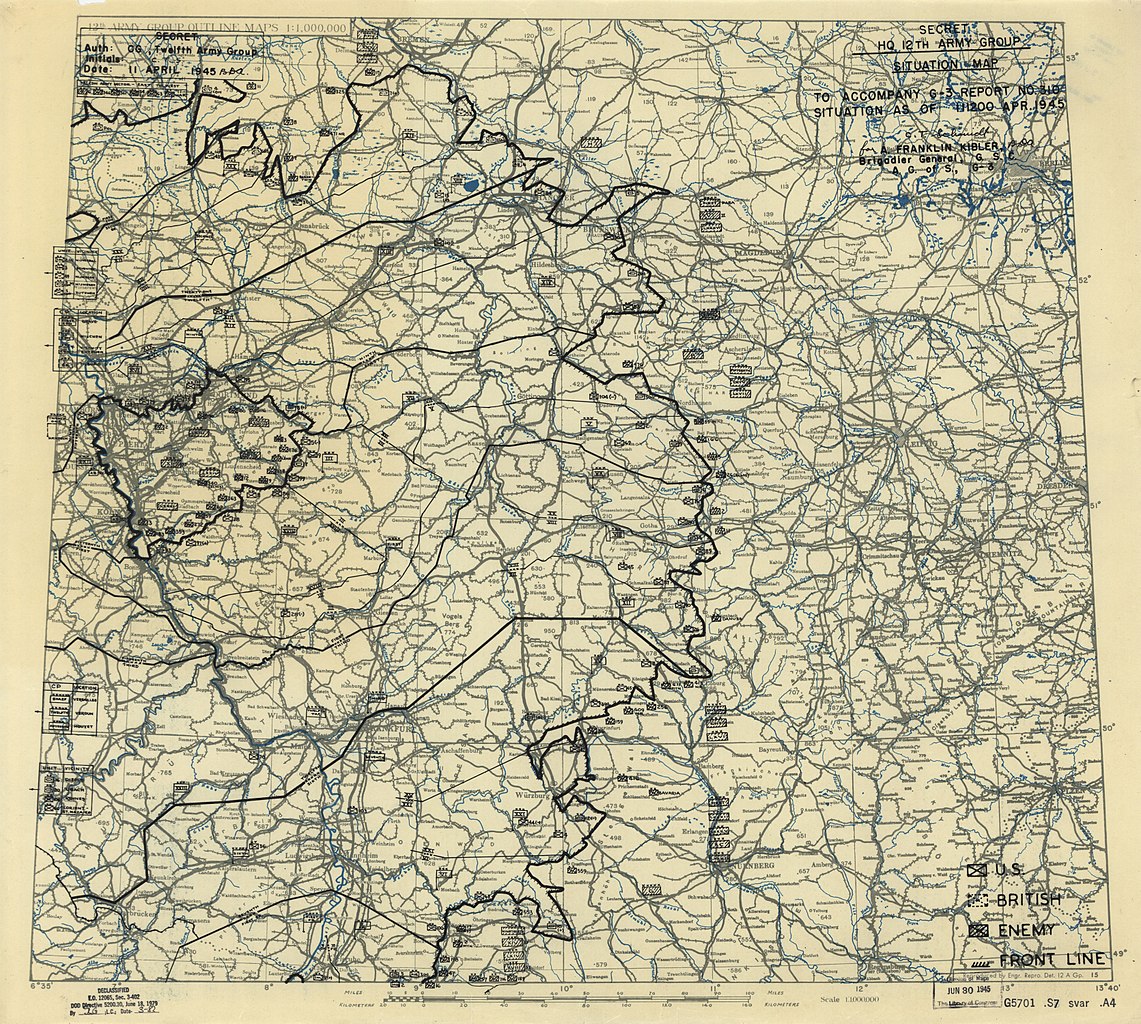 Forces of the British 2nd Army cross the Leine River near Celle. Photo: Churchill tanks of 3rd Scots Guards, 6th Guards Tank Brigade, advance towards Celle, 11 April 1945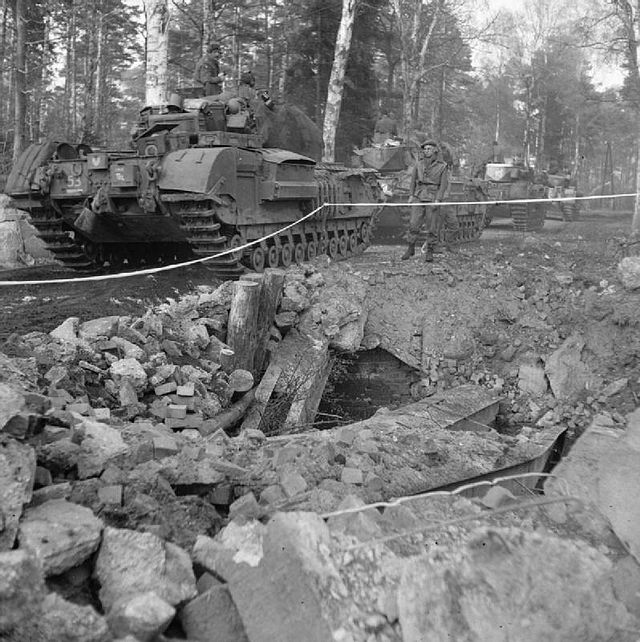 Photo: Churchill tanks carrying infantry through Mellendorf, 11 April 1945 Photo: Churchill tanks carrying infantry through Mellendorf, 11 April 1945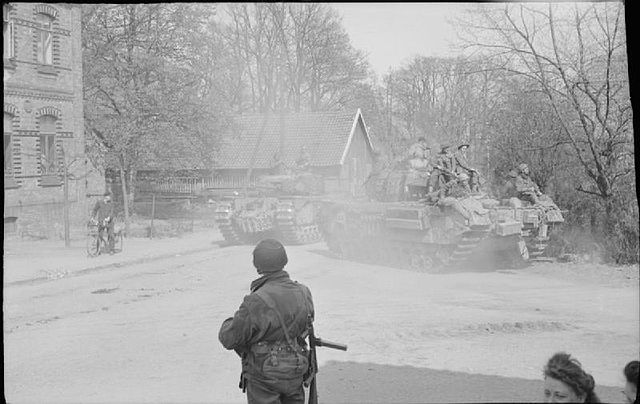 Leading armored units of the US 9th Army reach the Elbe River, south of Magdeburg. Forces of US 3rd Army capture Weimar. Photo: Tanks support infantrymen of the 5th Division, 3rd U.S. Army, in clearing out a German observation post in the newly-taken town of Grevenstein, Germany. 11 April, 1945 Photo: Infantrymen of the 5th Division, 3rd U.S. Army, skirt the newly-taken town of Grevenstein, Germany, to attack a nearby hill which the Germans are using for an observation post. 11 April, 1945 Photo: Infantrymen of the 5th Division, 3rd U.S. Army, skirt the newly-taken town of Grevenstein, Germany, to attack a nearby hill which the Germans are using for an observation post. 11 April, 1945 US troops find an intact V-weapon plant at Nordhausen, and remove as much material as possible to keep it from the Russians. The first troops arrive at 11.30am after being radioed in by Pvt. Galione who was calling them into neighbouring Mittelbau Dora camp. Instead they got lost and stumbled upon Nordhausen. Buchenwald concentration camp is liberated. Western Front (1945) - Liberation of the NetherlandsPhoto: Canadian soldiers search houses in Deventer, 11 April 1945 Air War over Europe Air War over Europe The Eighth Air Force flies Mission 941: 1,303 bombers and 913 fighters are dispatched to hit a variety of targets in Germany; 1 B-17 is lost: 300 B-17s bomb the Freiham oil depot and 133 attack the Kraiburg munitions plant; secondary targets hit are the munitions depot at Landshut and the marshalling yard at Treuchtlingen; 1 B-17 is lost. Escorting are 273 P-51s. 28 B-17s bomb the munitions depot and 82 hit the marshalling yard at Landshut; 131 attack the airfield and 79 hit the marshalling yard (79) at Ingolstadt; 70 bomb the marshalling yards at Treuchtlingen and 108 bomb the marshalling yards at Donauworth without loss. The escort is 281 P-51s. 79 B-24s bomb the Obertraubling Airfield, 31 hit a munitions depot while 80 attack an oil depot at Regensburg; 71 bomb the marshalling yards at Neumarkt and 73 hit the marshalling yards at Amberg. 211 P-47s and P-51s escort. The Ninth Air Force dispatches 689 A-20s, A-26s and B-26s to strike marshalling yards at Bernburg, Oschersleben, Zwickau, and Kothen, the Naumburg ordnance depot, Bamberg motor transport plant, and several other targets; fighters escort the bombers, fly patrols, sweeps, a leaflet mission, and armed reconnaissance (claiming 43 aircraft shot down), and support the US 3d and 9th Armored Divisions in the Nordhausen and Ringleben-Sachsenburg-Rothenberga areas, the 2d Armored Division as it reaches the Elbe River south of Magdeburg in a record drive of 57 miles (92 km), the XVI Corps along the Ruhr River at Witten, the XX Corps as it crosses the Saale River at Weimar and overruns the Buchenwald concentration camp and Allied prisoner camp nearby, the XII Corps in the Coburg-Rottenbach area, and the VIII Corps as it approaches the Saale River south of Weimar. 40 Fifteenth Air Force P-38s dive-bomb the Rosenheim railroad bridge. 40 other P-38s and 29 P-51s strafe rail traffic in the Munich and Regensburg; Plzen, Czechoslovakia; and Linz and Salzburg, Austria areas. 129 RAF Halifaxes of No 4 Group and 14 Pathfinder Lancasters attacked the railway yards at Nuremberg with great accuracy. No aircraft lost. 100 RAF Halifaxes of No 4 Group and 14 Lancasters and 8 Mosquitos of No 8 Group also carried out a very good attack on railway yards on Bayreuth without loss. 107 RAF Mosquitos attacked Berlin in 3 waves. Large fires were seen. 1 Mosquito lost. 8 Mosquitos attacked Munich without loss. Italian campaignCarrara is captured by the US 92nd Infantry Division (an element of US 5th Army) in its advance from Massa. In the east, forces of British 8th Army have now pushed the leading units over the Senio River to the Santerno River, where bridging operations begin. Photo: Photo: Sherman tanks advance, 11 April 1945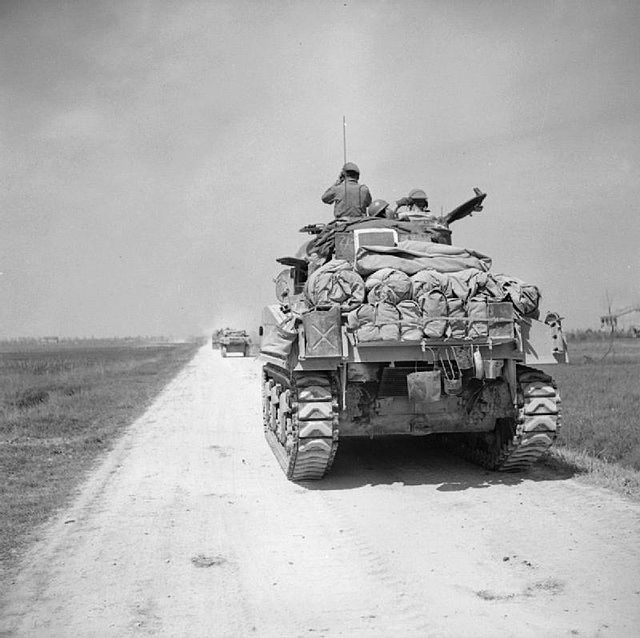 Photo: 'Fantails' or Buffalo amphibians transport German prisoners through a flooded landscape south of Lake Comacchio, 11 April 1945 Photo: 'Fantails' or Buffalo amphibians transport German prisoners through a flooded landscape south of Lake Comacchio, 11 April 1945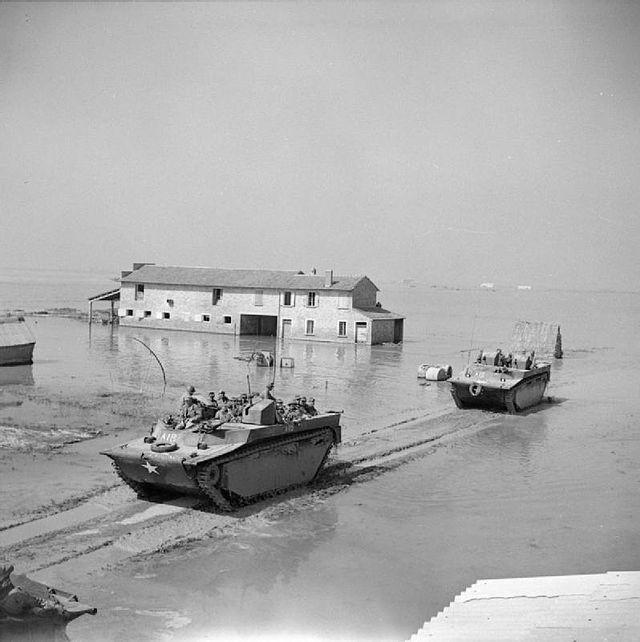 During the night of 10/11 April, Twelfth Air Force A-20s and A-26s bomb bridges at Lavis, Ala, Rovereto, San Michele all'Adige, and San Ambrogio di Valpolicella, and hit vehicles, Po River crossings and targets of opportunity in the Po Valley; medium bombers continue to support British Eighth Army forces between Imola and Comacchio Lagoon, bomb guns south of La Spezia in front of the US Fifth Army advance, and bomb 4 bridges on the Brenner line; XXII Tactical Air Command fighter-bombers also fly support on the Eighth Army front, and hit communications (including the Brenner line) and fuel and ammunition dumps in the north. 544 Fifteenth Air Force B-24s and B-17s hit communications in northern Italy, concentrating on the transportation system feeding into the Brenner area, in an effort to hamper the enemy's supply and escape routes; the bombers bomb bridges at Padua, Vipiteno, Campodazzo, Ponte Gardena, and Campo di Trens, marshalling yards at Bronzolo and Ora, a vehicle repair shop at Osoppo, and a fuel depot at Goito. 250+ fighters escort the bomber missions. United StatesPhoto: The U.S. Navy destroyer USS Wadleigh (DD-689) off the Mare Island Naval Shipyard, California (USA), on 11 April 1945 Pacific War Pacific WarCHINA (Fourteenth Air Force): In China, 7 B-25s bomb Hsihhsiassuchi, 5 pound the Pinglo barracks and storage area, and a few others hit the Yanglowtung railroad yards and targets of opportunity E of Paoching; 150+ fighter-bombers attack troops, river, road and rail traffic, and a variety of targets of opportunity scattered throughout S and E China and N French Indochina. INDIA-BURMA (Tenth Air Force): In Burma, 54 fighter-bombers hit troop and supply concentrations near Mong Kung and Mong Nim, attack trucks and targets of opportunity in other areas behind the battleline, and sweep several roads S of bomb line; transports fly 424 sorties carrying men and supplies to forward areas. BURMA Photo: Supply trucks heading south near Pyawbe stop to examine a signpost that points them towards Rangoon, 312 miles away, 11 April 1945 Photo: A column of vehicles heads south near Pyawbe, 300 miles from Rangoon, 11 April 1945 Photo: A column of vehicles heads south near Pyawbe, 300 miles from Rangoon, 11 April 1945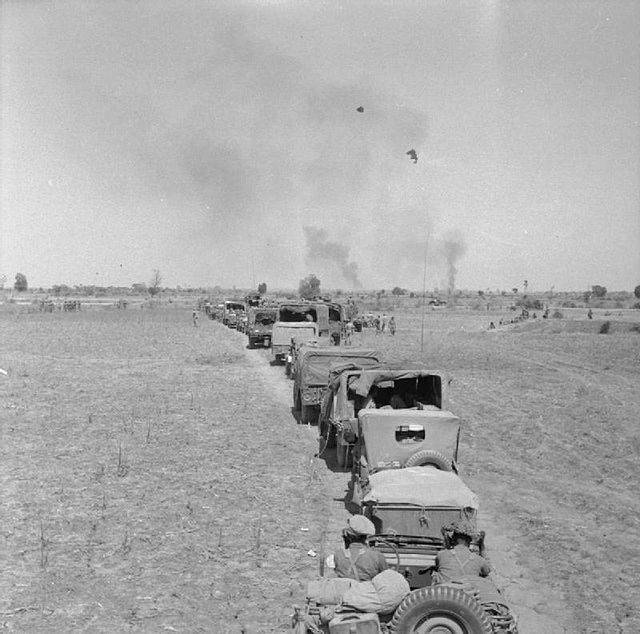 PALAU (Seventh Air Force): 24 B-24s from Angaur Airfield hit Cotabato supply and personnel areas on Mindanao Island. 18 Guam based B-24s pound positions on Eten. SOUTHWEST PACIFIC AREA On Formosa, B-24s bomb Okayama while B-25s hit several targets including the Ts'eng Wen sugar refinery, Seiko, Sunbon-sha, and Shasekiryo. P-38s attack gun positions at Tarakan. JAPANESE OCCUPIED NETHERLANDS EAST INDIES Sabang is shelled by the battleships Queen Elizabeth and Richelieu of the British Eastern Fleet (Admiral Walker). Two escort carriers give air cover and attack installations and shipping at Port Blair and Emmahaven. PHILIPPINE CAMPAIGN (1945) Units of the Americal Division land on Bohol. 24 Seventh Air Force 24 B-24s from Angaur Island, Palau Islands, hit the Cotabato supply and personnel areas on Mindanao. B-24s bomb Cotabato on Mindanao. On Negros Island, B-24s hit Japanese defenses northwest of Guadalupe and A-20s hit a bivouac east of Negritos. On Luzon Island B-24s,B-25s, A-20s, and fighter-bombers bomb numerous targets including Fuga Island, the Cagayan Valley areas, Santa Fe, bridges and other communications in Iligan, Naguilian, Manga, and Tuguegarao, and troops and supply concentration north of Imugan; troop support strikes are flown in the Solvec Cove area and east of Manila; Baguio and a troop concentration in the Batangas area and on the Bicol peninsula are bombed; at Iriga, defenses are hit with napalm. VOLCANO AND RYUKYU ISLANDS CAMPAIGN The US Army's 105th Infantry Regiment, 27th Infantry Division, lands on Tsuken Shima off the east coast of Okinawa. Kamikazes damage battleship Missouri (BB-63) and destroyers Bullard (DD-660) and Kidd (DD-661), 26°00'N, 130°00'E; carrier Enterprise (CV-6) (near-miss of two suiciders), 26°00'N, 128°00'E; and destroyer escort Samuel S. Miles (DE-183), 26°12'N, 127°20'E; carrier Essex (CV-9) is damaged by bomb, 26°50'N, 130°30'E; destroyer Hale (DD-642) is damaged by bomb, 26°00'N, 120°00'E; strafing accounts for damage to destroyer Hank (DD-702), 27°00'N, 130°00'E, and destroyer escort Manlove (DE-36), 26°12'N, 127°20'E; attack transport Berrien (APA-62) is damaged by collision with tank landing ship LST-808, 26°22'N, 127°43'E; friendly fire accounts for damage to destroyer Trathen (DD-530), 27°13'N, 130°15'E, and attack cargo ship Leo (AKA-60), 26°21'N, 127°43'E; tank landing ship LST-399 is damaged by grounding, 26°20'N, 127°45'E. Photo: A kamikaze aircraft hits the water off the starboard quarter of the U.S. Navy aircraft carrier USS Enterprise (CV-6), during operations off Okinawa, 11 April 1945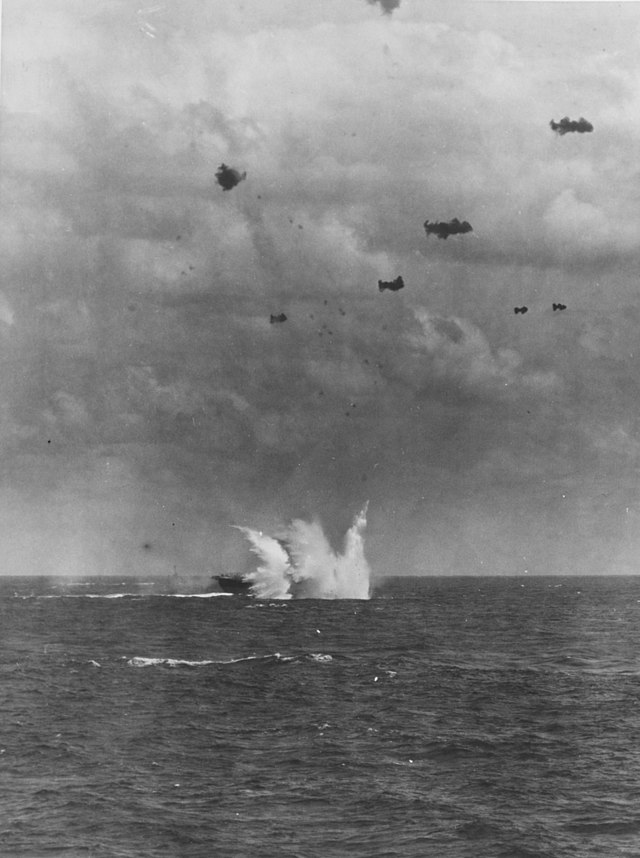 Photo: The U.S. Navy aircraft carrier USS Enterprise (CV-6) at left under attack by a Japanese suicide plane, during operations off Okinawa on 11 April 1945. She was hit and damaged on this day, but returned to action in early May following repairs made at Ulithi. At right is USS Oakland (CL-95), which is opening fire on the diving plane. Note tracer shells streaking across the upper part of the image Photo: The U.S. Navy aircraft carrier USS Enterprise (CV-6) at left under attack by a Japanese suicide plane, during operations off Okinawa on 11 April 1945. She was hit and damaged on this day, but returned to action in early May following repairs made at Ulithi. At right is USS Oakland (CL-95), which is opening fire on the diving plane. Note tracer shells streaking across the upper part of the image Photo: A Japanese kamikaze suicide plane (Yokosuka D4Y "Judy"?) attacks the U.S. Navy aircraft carrier USS Bunker Hill (CV-17) off Okinawa, 1409 hrs, 11 April 1945. It was shot down and crashed aft of the ship Photo: A Japanese kamikaze suicide plane (Yokosuka D4Y "Judy"?) attacks the U.S. Navy aircraft carrier USS Bunker Hill (CV-17) off Okinawa, 1409 hrs, 11 April 1945. It was shot down and crashed aft of the ship Photo: A Japanese Mitsubishi A6M piloted by Lieutenant Junior Grade Shigehisa Yaguchi about to crash into the U.S. Navy destroyer USS Kidd (DD-661) off Okinawa, Japan, on 11 April 1945. The plane hit on the starboard side below the bridge. Its 500 kg bomb continued through the boiler room exiting the port side of the hull and exploded close aboard. The attack killed 38 of Kidd's crew and wounded 55. Another destroyer is visible in the background Photo: A Japanese Mitsubishi A6M piloted by Lieutenant Junior Grade Shigehisa Yaguchi about to crash into the U.S. Navy destroyer USS Kidd (DD-661) off Okinawa, Japan, on 11 April 1945. The plane hit on the starboard side below the bridge. Its 500 kg bomb continued through the boiler room exiting the port side of the hull and exploded close aboard. The attack killed 38 of Kidd's crew and wounded 55. Another destroyer is visible in the background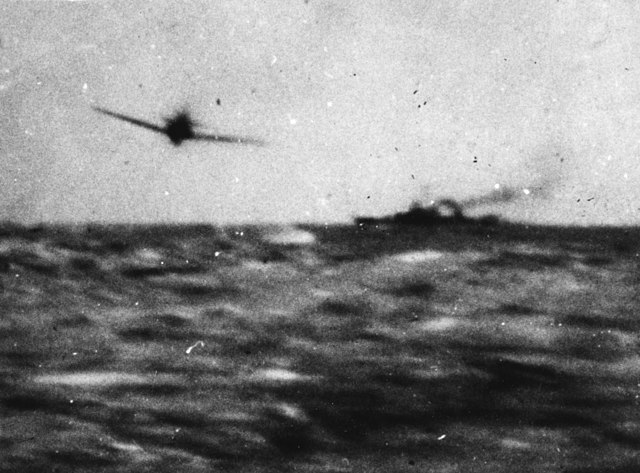 ALASKA (Eleventh Air Force): P-38s together with USN aircraft pick up bombfilled paper balloons over Attu and E of Adak Islands in the Aleutian Islands; one balloon over Attu is shot down and portions of the gondola are recovered in Massacre Bay. UNITED STATES NAVY DEPARTMENT COMMUNIQUES, CINCPOA COMMUNIQUÉ NO. 329, APRIL 11, 1945 No substantial changes were made in the lines on Okinawa on April 11 (East Longitude Date). In the south the enemy continued to resist attacks of the Twenty Fourth Army Corps with artillery, mortar and small arms fire. In the north Marines of the Third Amphibious Corps met some organized resistance on Motobu Peninsula but continued to advance northward on Ishikawa Isthmus. Army troops of the Twenty‑Fourth Corps reduced enemy points of resistance on Tsugen Island off the east coast of Okinawa and occupied the island on April 11. Direct support was provided for our forces by carrier aircraft, Naval gunfire and Marine and Army artillery. Our forces in the Okinawa area were attacked sporadically by enemy aircraft, four of which were destroyed. United States forces on Okinawa had lost 432 killed at the end of April 9. Our wounded for the same period were 2,103. A total of 180 were missing. On the night of April 10, Army Black Widow night fighters strafed and bombed targets on Haha Jima and Chichi Jima in the Bonins. On the same date a Marine Mitchell of the Strategic Air Force attacked a large cargo ship north of the Bonins scoring rocket hits on it and leaving it dead in the water. Planes of the Fourth Marine Aircraft Wing attacked buildings and other installations on islands in the Palaus and on Yap in the Western Carolines on April 11. PACIFIC Submarine Parche (SS-384) sinks Japanese auxiliary minesweeper Togo Maru off Todogasaki, 38°53'N, 142°05'E. Submarine Spadefish (SS-411) sinks Japanese auxiliary minesweeper No.17 Hinode Maru off Tokckok-Kundo, 37°13'N, 125°11'E. RAF Liberators (203 Squadron) sink Japanese submarine chaser Ch 7 and auxiliary netlayer Agata Maru in Andaman Sea, 08°57'N, 93°38'E. Japanese auxiliary submarine chaser Cha 215 is sunk by mine off Futaoi-Jima, Shimonoseki.
|
|
lordroel
Administrator
Posts: 68,007 
Likes: 49,410
|
Post by lordroel on Apr 12, 2024 6:08:22 GMT
Day 2041 of World War II, April 12th 1945Western Front (1945) - Western Allied invasion of GermanyMap: HQ Twelfth Army Group situation map, April 12th 1945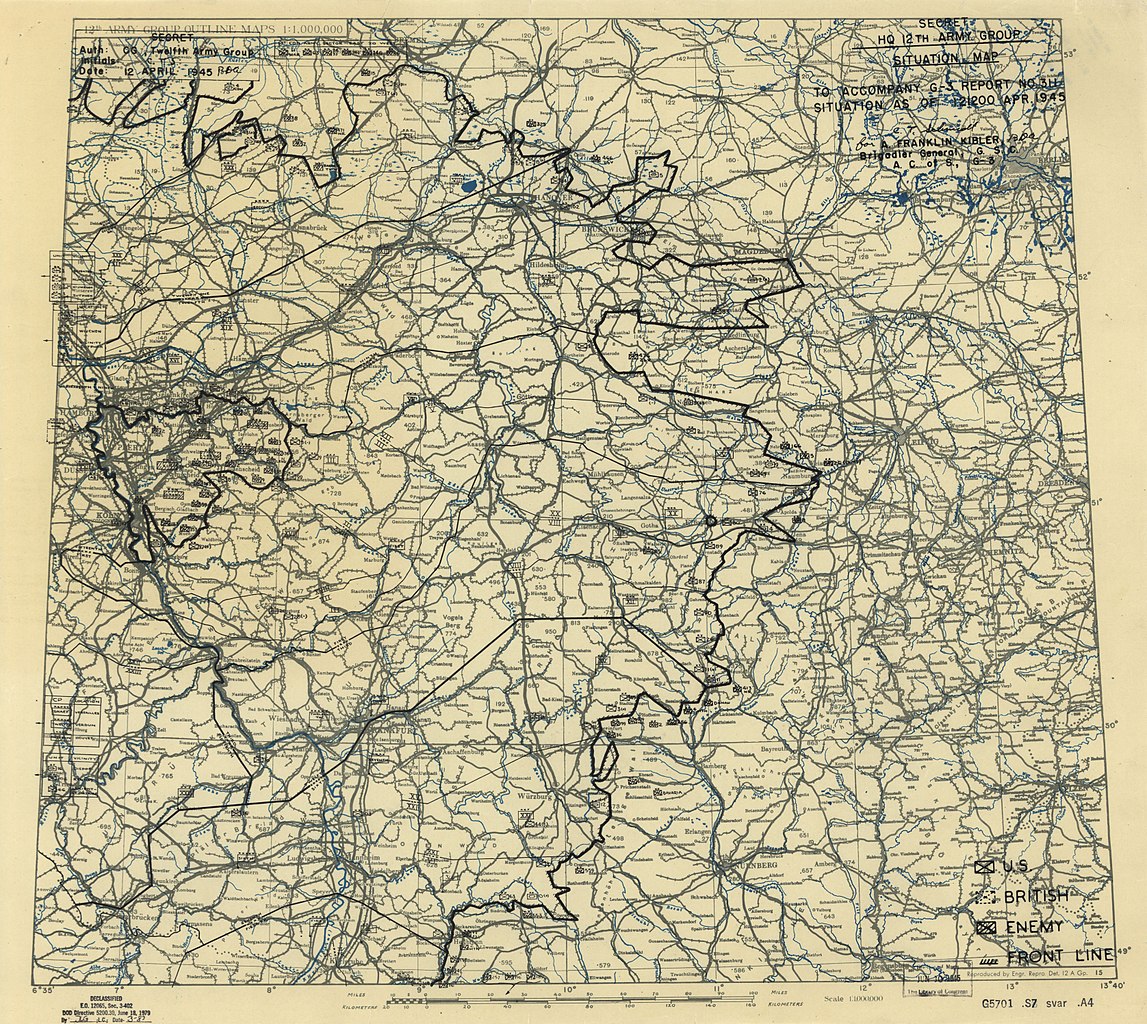 US 9th Army forces cross the Elbe River near Magdeburg, while in the rear of their advance, Brunswick falls. Troops of the US 3rd Army take Erfurt. In the south, French units take Baden Baden. To the rear, the Ruhr pocket has been further reduced by the capture of Essen by American attacks. Photo: Tanks of 9th Armored Division and infantrymen of 69th Division, 1st U.S. Army, roll into newly-taken Kölleda, Germany. 12 April, 1945 Photo: Halftrack of 9th Armored Division, 1st U.S. Army, drives through Wiehe, Germany, on route to the Elbe River. 12 April, 1945 Photo: Halftrack of 9th Armored Division, 1st U.S. Army, drives through Wiehe, Germany, on route to the Elbe River. 12 April, 1945 Photo: Troops of an armored infantry unit move over hill and along road toward the town of Kronach, Germany, in Third U.S. Army sector. 12 April, 1945 Photo: Troops of an armored infantry unit move over hill and along road toward the town of Kronach, Germany, in Third U.S. Army sector. 12 April, 1945 Photo: Sexton 25-pdr self-propelled guns of 86th Field Regiment (Hertfordshire Yeomanry) firing against enemy positions, 12 April 1945 Photo: Sexton 25-pdr self-propelled guns of 86th Field Regiment (Hertfordshire Yeomanry) firing against enemy positions, 12 April 1945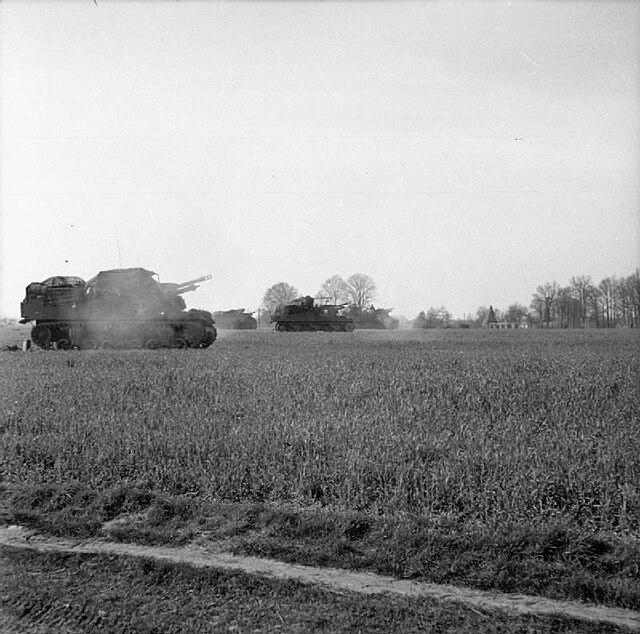 Air War over Europe Air War over Europe 167 A-20s, A-26s and B-26s of the Ninth Air Force, escorted by 95 Eighth Air Force P-51s, attack the Hof rail bridge, Kempten ordnance depot, and Goppingen marshalling yard, plus a town area and a casual target of opportunity; 275+ planes abort because of weather; fighters escort the bombers, attack the town of Kothen, fly armed reconnaissance and sweeps over wide areas and support ground forces; fighters also support the US III, XVI, and XVIII Corps as they continue to reduce the Ruhr pocket, the 9th Armored Division on the Saale River near Werben and Bad Lauchstadt, the XX Corps from the Saale River N and S of Jena E across the Weisse Elster River, the VIII Corps along the Saale further S of Jena, the XII Corp SE of Coburg on the Hasslach River, the 2d Armored Division across the Elbe River near Randau S of Magdeburg, the 5th Armored Division on the W bank of the Elbe at Wittenberge, and the XVI Corps as it continues fighting in the Duisburg and Dortmund areas. 97 RAF Mosquitos to Berlin and 3 to Munich. 13 Mosquitos on Intruder patrols. No aircraft lost. Italian campaign British 8th Army has three separate bridgeheads over the Santerno. On the right of the attack, British 5th Corps is advancing along the north bank of the Reno. Photo: Churchill Crocodile flamethrower tanks move forward near Imola, 12 April 1945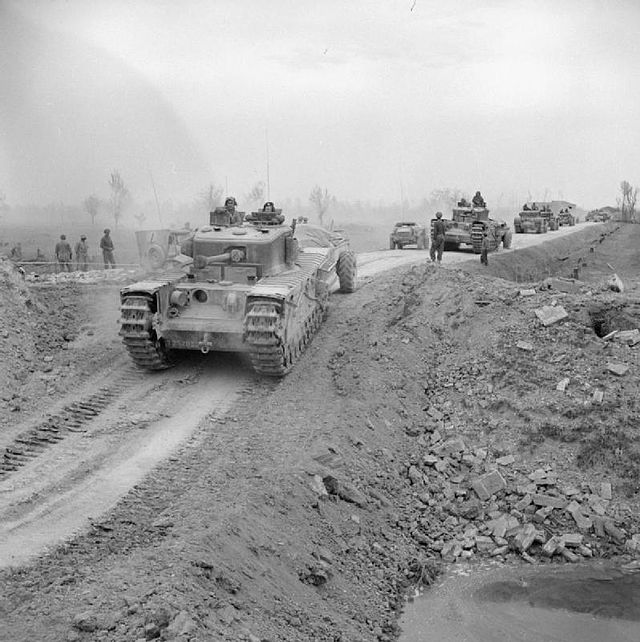 Photo: A heavily camouflaged Sherman tank crosses a Bailey bridge over the River Santerno near Imola, 12 April 1945 Photo: A heavily camouflaged Sherman tank crosses a Bailey bridge over the River Santerno near Imola, 12 April 1945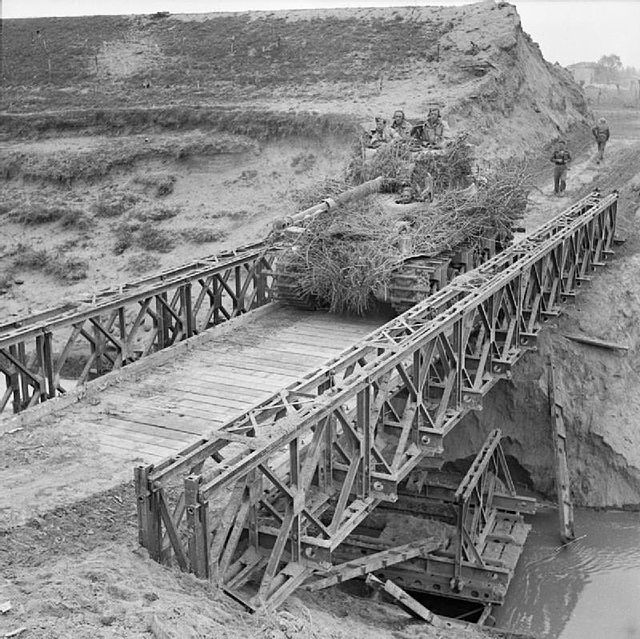 The US Fifteenth Air Force dispatches 400+ B-17s and B-24s to hit communications in N Italy and S Austria, attacking railroad bridges at Padua, Ponte di Piave and Nervesa della Bataglia, Italy, and Sankt Veit an der Glan, Austria, an ammunition dump at Malcontenta, and supply dump at Peschiera del Garda, Italy; 124 P-51s provide escort. 123 P-38s bomb railroad bridges at Unzmarkt and Arnoldstein, Austria; 128 B-24s, with P-51 escort, sent against N Italian communications abort due to bad weather. 38 P-51s escort MATAF B-25s on raids in N Yugoslavia. During the night of 11/12 Apr, US Twelfth Air Force A-20s and A-26s hit Po River crossings; medium bombers, restricted by low clouds, bomb approaches to the Maribor, Yugoslavia bridge, hit targets along the Brenner rail line, and support the British Eighth Army in the Argenta area; fighter-bombers attack NE Italian railroad lines, including fuel dumps and communications targets in the Po Valley. GermanyHeinrich Himmler ordered that commanders who failed to hold key positions in the defense of Germany would be executed. United StatesPresident Roosevelt dies of a cerebral hemorrhage at Warm Springs in Georgia. Vice-President Truman becomes President. Truman has so far had limited involvement in the work of the Roosevelt administration (he was a surprising choice as running mate in 1944) and among the subjects on which he receives his first briefing in the next few days in the atomic weapons project. YouTube (The Death of Franklin Roosevelt)Pacific War CHINA (Fourteenth Air Force): In China, 12 B-24s supported by 14 P-51s, bomb the Wuchang railroad yards and airfield; 7 B-25s bomb the Hsuchang railroad yards, 3 hit Loning, 2 attack Likuanchiao, 2 bomb Tenghsien, and a single B-25 attack storage areas at Pingyao and Huaiching; 100+ fighter-bombers attack troops, horses, bridges, river shipping, trucks, and railroad targets at several locations in French Indochina and at points scattered over S and E China; the 449th Fighter Squadron, 51st FG, based at Chengkung with P-38s, sends a detachment to operate from Posek. INDIA-BURMA (Tenth Air Force): 75 fighter-bombers continue to pound targets in the C Burma battle area; troop concentrations, gun positions, supplies, vehicles, and general targets of opportunity are attacked along the battlefront, behind enemy lines, and along roads S of the bomb line; 369 air supply sorties are flown throughout the day. The 20th Tactical Reconnaissance Squadron, 8th Photographic Reconnaissance Group, based at Myitkyina, Burma with F-6s and P-40s, sends a flight to operate from Akyab, Burma. BURMA The British 4th Corps advance continues in the Sittang Valley. There is fighting at Pyaubwe and Yamethin. To the west of Meiktila, British 7th Indian Division from (part of British 33rd Corps) captures Kyaukpadaung. Photo: A company commander briefs his men before a patrol, 12 April 1945 Photo: An infantry patrol pauses near a possible Japanese strongpoint, 12 April 1945 Photo: An infantry patrol pauses near a possible Japanese strongpoint, 12 April 1945 PALAU (VII Fighter Command): 90 P-51s are dispatched to escort B-29s on a raid against Tokyo; they claim 15-6-3 Japanese aircraft; 4 P 51s are lost. During the night of 12/13 Apr, 6 Iwo Jima based fighters, operating singly at intervals, bomb and strafe targets on Kita, Chichi, Haha, and Ani Jima. (Twentieth Air Force): 4 missions are flown. Mission 63: 94 B-29s, escorted by 90 P-51s, strike the Nakajima aircraft factory at Tokyo while 11 hit the secondary target, the Shizuoka engine plant; B-29s gunners claim 16 fighters downed. Mission 64: 66 B-29s hit a chemical plant at Koriyama and 9 hit targets of opportunity. Mission 65: 70 B-29s hit a second chemical plant at Koriyama and 6 hit targets of opportunity; 2 B-29s are lost. Mission 66: During the night of 12/13 Apr, 5 B-29s mine Shimonoseki Strait. SOUTHWEST PACIFIC AREA [Far East Air Force]: On Formosa, B-24s attack Tainan and bomb Okayama Airfield. The 70th Troop Carrier Squadron, 433d Troop Carrier Group, moves from Dulag to Tanauan with C-46s and C-47s. PHILIPPINE CAMPAIGN (1945) (Seventh Air Force B-24s): 24 based on Angaur Island hit a personnel area at Kabacan on Mindanao Island. Far East Air Force operations include dispatching P-38s and A-20s to support ground troops on Cebu and Negros Islands. On Mindanao Island, B-24s bomb Sapakan, Kabacan and the Davao Bay areas and P-38s hit Cotabato and also Kabacan. On Luzon Island, B-24s, B-25s, A-20s, and fighter-bombers pound targets throughout the Cagayan Valley, blast defenses at Balete Pass and in the Baguio area, and hit troops, communications targets, and defenses at numerous points in SW and SE Luzon Island. VOLCANO AND RYUKYU ISLANDS CAMPAIGN On Okinawa, fighting continues on the Motobu Peninsula, in the north, and around Kakazu, in the south, along the Japanese held Shuri Line but US 10th Army forces make little ground in these areas. Off Okinawa, destroyer Mannert L. Abele (DD-733) is sunk by Baka, 27°25'N, 126°59'E--she is the first U.S. Navy ship to be sunk by that type of weapon; destroyer Stanly (DD-478) is damaged by Baka, 27°12'N, 128°17'E; high speed minesweeper Jeffers (DMS-27) is damaged by Baka and kamikaze, 26°50'N, 126°35'E; kamikazes sink support landing craft LCS-33 and damage battleship Idaho (BB-42), 26°26'N, 127°32'E; battleship Tennessee (BB-43), destroyer Zellars (DD-777), destroyer escort Riddle (DE-185), 26°00'N, 128°00'E; destroyers Purdy (DD-734), 27°16'N, 127°50'E, and Cassin Young (DD-793), 27°17'N, 127°50'E; destroyer escorts Rall (DE-304), 26°36'N, 127°39'E, Walter C. Wann (DE-412), 26°17'N, 127°20'E, and Whitehurst (DE-634), 26°04'N, 127°12'E, and light minelayer Lindsey (DM-32), 26°28'N, 127°15'E; minesweeper Gladiator (AM-319) is damaged by near-miss of kamikaze, 26°05'N, 127°35'E. Friendly fire accounts for damage to battleship New Mexico (BB-40), 26°31'N, 127°37'E and destroyer Bennion (DD-662); while attack cargo ship Wyandot (AKA-92) is damaged in collision with medium landing ship LSM-312, 26°21'N, 127°44'E; tank landing ship LST-555 is damaged by grounding, 26°20'N, 127°45'E. Kamikazes also attack U.S. freighter Minot Victory, but Armed Guard gunners inflict sufficient damage on the suicider that it only strikes the ship a glancing blow and then disintegrates; there are no fatalities on board the merchantman among the 57-man merchant complement, the 27 Armed Guard sailors and nine passengers. Photo: The U.S. Navy destroyer USS Zellars (DD-777) after a kamikaze crashed into her port side on 12 April 1945. The plane hit Zellars forward of the bridge in her number 2 handling room. The 500-kilogram bomb tore through several light bulkheads before exploding on the starboard side of the ship in the scullery. Zellars temporarily lost all power, and the fireroom had to be secured. She had to return to the United States for repairs Photo: The U.S. Navy battleship USS Tennessee (BB-43) passes the destroyer USS Zellars (DD-777), which was hit by Kamikaze attacks off Okinawa, 12 April 1945 Photo: The U.S. Navy battleship USS Tennessee (BB-43) passes the destroyer USS Zellars (DD-777), which was hit by Kamikaze attacks off Okinawa, 12 April 1945 ALASKA (Eleventh Air Force): P-38s shoot down paper bomb-balloons over Attu Island. UNITED STATES NAVY DEPARTMENT COMMUNIQUES, N. D. COMMUNIQUÉ NO. 592, APRIL 12, 1945 Pacific Area. 1. The submarine USS Scamp is overdue from patrol and presumed lost. 2. The LCS (L) (S)‑49 was lost in the Philippine area as the result of enemy action. 3. The next of kin of casualties have been informed in both cases. UNITED STATES NAVY DEPARTMENT COMMUNIQUES, CINCPOA COMMUNIQUÉ NO. 330, APRIL 12, 1945 The Sixth Marine Division on Okinawa moved forward against sporadic resistance by the enemy on Motobu Peninsula on April 12 (East Longitude Date). On Ishikawa Isthmus our troops continued to press northward over rugged terrain and extremely poor roads. The First Marine Division continued mopping up in its zone of action. There was virtually no change in the lines in the Southern sector of Okinawa where the Twenty‑Fourth Army Corps, including elements of the Twenty‑Seventh and Ninety‑Sixth Divisions, continued to meet strong enemy resistance on April 12. On April 12, large numbers of enemy aircraft made desperate suicidal attacks on our forces in the Okinawa Area. Early in the morning, seven enemy aircraft were shot down in the vicinity of the Hagushi beaches. During the afternoon, ships' guns, carrier aircraft and shore‑based antiaircraft shot down 111 of the attackers. One of our destroyers was sunk during these attacks and several other surface units were damaged but remained in operation. Installations on Chichi Jima and Haha Jima in the Bonins were bombed and strafed on the night of April 11‑12 by Army Black Widow night fighters. Warehouse and other installations in the Palaus and facilities on the airfield on Yap in the Western Carolines were bombed by Hellcat and Corsair fighters and Avenger torpedo planes of the Fourth Marine Aircraft Wing on April 12. Liberators of the Seventh Army Air Force bombed installations on Truk in the Carolines on April 11. Search aircraft of Fleet Air Wing Four and Mitchells and Liberators of the Eleventh Army Air Force on April ?, made rocket machine gun and bombing attacks on installations on Shimushu, Paramushiru, and the Torishima Group in the Northern Kuriles. On April 11, further attacks were carried out by Eleventh Army Air Force aircraft on the Kataoka Naval Base on Shimushu where Army planes damaged one of several enemy fighters which attacked them. Fleet Air Wing Four Search planes made rocket and strafing attacks on installations at the mouth of the Hayake River on Paramushiru on April 11. Minami Cape on Shimushu and Masu Town on Paramushiru were bombed by Army Mitchells on the same date. All our aircraft returned safely. PACIFIC In the final mining mission carried out in support of the Okinawa campaign, five USAAF B-29s mine Shimonoseki Straits. Submarine Chub (SS-329) is damaged by aerial bombs, Java Sea, 06°03'S, 113°56'E, but remains on patrol. Submarine Silversides (SS-236) sinks Japanese auxiliary submarine chaser Shiratori Maru east of Tanega Jima,30°45'N, 131°57'E. British submarine HMS Stygian sinks Japanese auxiliary minesweeper Wa 104 and damages auxiliary submarine chasers Cha 104 and Cha 114 off north coast of Bali, 08°05'S, 115°06'E. Mines sink Japanese submarine RO 64 off Kobe, Japan, 34°14'N, 132°16'E, and merchant cargo ship Minatogawa Maru off Wakamatsu. B-24 aircraft (service and nationality unspecified) sinks Japanese ship No.2 Hakushi Maru off Badjowe, 04°33'S, 120°23'E. Fire of undetermined origin destroys buildings and damages Finger Bay dock, Adak Island; the blaze also damages floating drydock YFD-22 and floating workshop YR-36. Gasoline tanker Ogeechee (AOG-35) is saved from further damage by escort patrol vessel PCE-895, which pulls her out into Finger Bay.
|
|
lordroel
Administrator
Posts: 68,007 
Likes: 49,410
|
Post by lordroel on Apr 13, 2024 14:03:10 GMT
Day 2042 of World War II, April 13th 1945YouTube (Soviets Take Vienna and Königsberg) Eastern FrontVienna falls to the Soviet Army. As agreed by the Allies in 1943, it appears that Austria will not be treated as a conquered nation. Moscow radio said tonight that because the people of Vienna and other parts of Austria had helped the Red Army fight the Germans they had "saved the honour of the Austrian nation." Western Front (1945) - Western Allied invasion of GermanyMap: HQ Twelfth Army Group situation map, April 13th 1945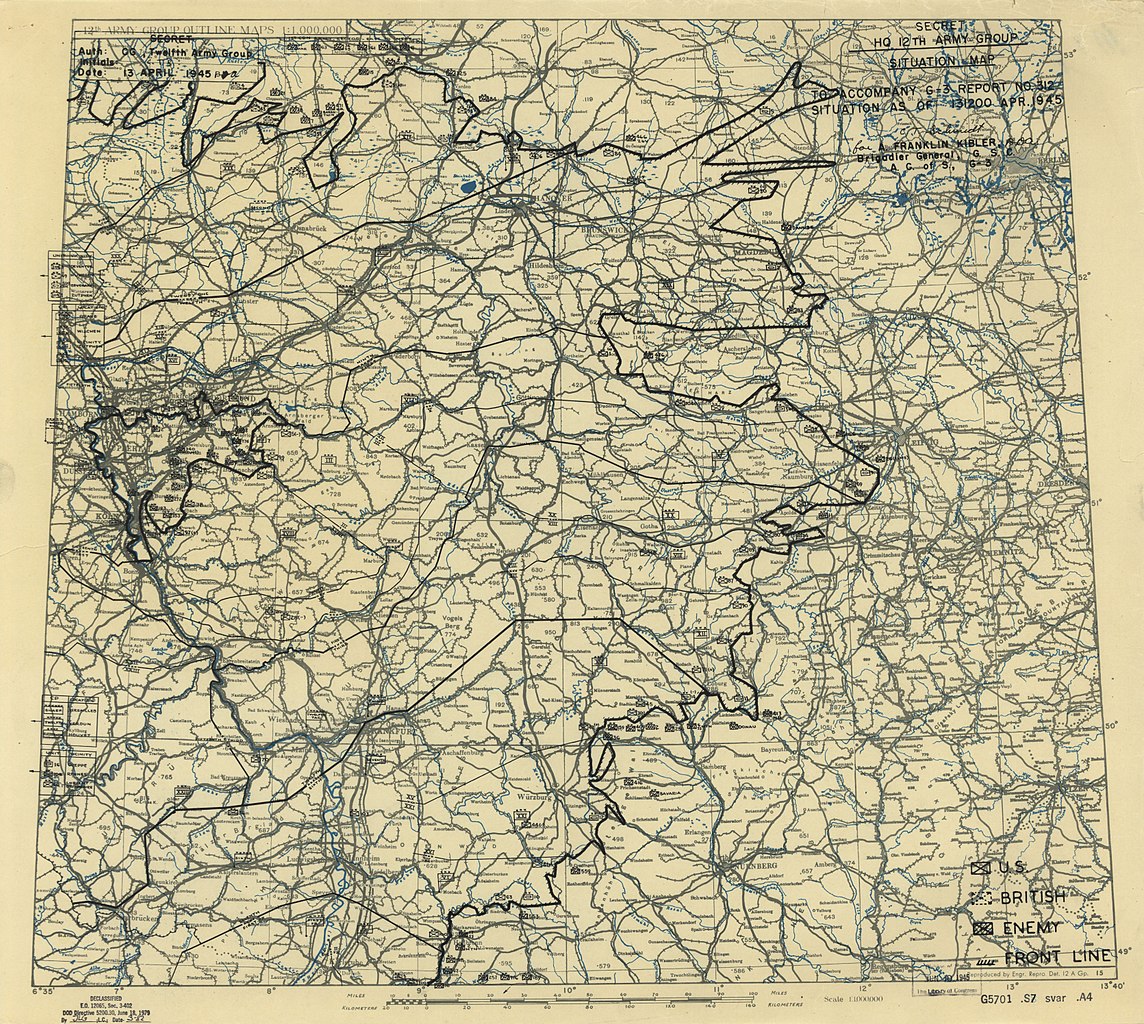 The US 83rd Infantry Division with several associated units, arrive at the west bank of the Elbe. The US Army XIXth Corps commander, Major General Raymond S. McLain order it to cross the Elbe and into territory assigned to the Red Army, and to prepare to advance east/northeast (in the direction toward Berlin). Jena is captured by US 3rd Army units. To the south, US 7th Army forces take Bamberg. Photo: Stuart light tanks pass half-tracks and other vehicles of 15th (Scottish) Division during the advance to the River Elbe, Germany, 13 April 1945 Photo: Carriers towing 6-pdr anti-tank guns and other vehicles of 15th (Scottish) Division in Celle during the advance to the River Elbe, 13 April 1945 Photo: Carriers towing 6-pdr anti-tank guns and other vehicles of 15th (Scottish) Division in Celle during the advance to the River Elbe, 13 April 1945 Photo: A Wasp flamethrower and other vehicles of 15th (Scottish) Division during the advance to the River Elbe, 13 April 1945 Photo: A Wasp flamethrower and other vehicles of 15th (Scottish) Division during the advance to the River Elbe, 13 April 1945 Photo: Churchill tanks of 6th Guards Tank Brigade carrying men of the 10th Highland Light Infantry negotiate a bomb crater during the advance to the River Elbe in Germany, 13 April 1945 Photo: Churchill tanks of 6th Guards Tank Brigade carrying men of the 10th Highland Light Infantry negotiate a bomb crater during the advance to the River Elbe in Germany, 13 April 1945 Photo: Churchill tanks of 6th Guards Tank Brigade with infantry, carriers and half-tracks of 15th (Scottish) Division wait to advance towards the River Elbe, 13 April 1945 Photo: Churchill tanks of 6th Guards Tank Brigade with infantry, carriers and half-tracks of 15th (Scottish) Division wait to advance towards the River Elbe, 13 April 1945 Photo: Sherman tanks of the 1st Coldstream Guards, Guards Armoured Division, shooting at enemy positions in a wood during the advance in Germany, 13 April 1945 Photo: Sherman tanks of the 1st Coldstream Guards, Guards Armoured Division, shooting at enemy positions in a wood during the advance in Germany, 13 April 1945 Photo: Troops pass through Heilbronn after initial German resistance crumbled. 13 April, 1945 Photo: Troops pass through Heilbronn after initial German resistance crumbled. 13 April, 1945

Photo: Infantrymen of the 8th Infantry Division, 1st U.S. Army, move along the road outside Wergeberg, Germany. 13 April, 1945
 The Nazi concentration camps at Belsen and Buchenwald are liberated by British and American forces respectively. Eisenhower turns down his third chance to capture Berlin, saying that it is just a political prize. Western Front (1945) - Liberation of the NetherlandsPhoto: Churchill AVRE in Arnhem, 13 April 1945 Photo: A Buffalo of 79th Armoured Division on the banks of the River Ijssel at Arnhem, with the blown railway bridge in the background, 13 April 1945 Photo: A Buffalo of 79th Armoured Division on the banks of the River Ijssel at Arnhem, with the blown railway bridge in the background, 13 April 1945 Photo: A Universal carrier being loaded aboard a Buffalo prior to being transported across the River Ijssel at Arnhem, 13 April 1945 Photo: A Universal carrier being loaded aboard a Buffalo prior to being transported across the River Ijssel at Arnhem, 13 April 1945 Air War over Europe Air War over Europe The Eighth Air Force flies Mission 945: The AAF claims 284-0-220 Luftwaffe aircraft. 212 B-17s, escorted by 256 P-51s, attack the marshalling yard at Neumunster visually; 2 B-17s are lost. The escort claims 137-0-83 Luftwaffe aircraft in the air; 6 P-51s are lost. During this mission, 97 P-47s and P-51s fly a freelance mission in support of the bombers; they claim 147-0-137 aircraft on the ground; a P-47 and a P-51 are lost. During Mission 946 flown that night, 10 B-24s bomb the Beizenburg rail junction without loss. Fighter-bombers of the Ninth Air Force's IX Tactical Air Command fly a special mission against the HQ of Field Marshall Walter Model's Army Group B at Haus Waldesruh in the Ruhr pocket; the air attack is followed by an artillery barrage; as a result the HQ is moved to Haan. IX Tactical Air Command pilots sight Soviet fighters in the air for the first time. Weather grounds the 9th Bombardment Division. Fighters fly patrols and armed reconnaissance, and support the US XVIII Corps in the Huckeswagen and Hagen areas, the III Corps between the Ruhr and Honne Rivers, the 3d Armored Division on the Saale River in the Alsleben, Nelben and Friedeburg area, the XX Corps astride and between the Weisse Eister and Zwickauer Mulde Rivers north of Gera, the XVI Corps northwest of Hagen, the 2d Armored Division in the Elbenau-Grunwalde area, and the 5th Armored Division along the Elbe River in the Tangermunde area. (Jack McKillop) 34 RAF Lancasters of No 5 Group (Nos 9 and 617 Squadrons) set out to attack the warships Prinz Eugen and Lützow in Swinemünde harbour but the raid was abandoned because of cloud over the target. All aircraft returned safely. 377 RAF Lancasters and 105 Halifaxes of Nos 3, 6 and 8 Groups to Kiel. 2 Lancasters lost. This raid was directed against the port area, with the U-boat yards as the main objective. Bomber Command rated this as 'a poor attack' with scattered bombing. 20 RAF Halifaxes and 8 Mosquitos in a diversionary raid on Boizenburg, 87 Mosquitos to Hamburg, 20 to Stralsund and 12 to Reisa, 62 RCM sorties, 55 Mosquito patrols, 82 Lancasters and 27 Halifaxes minelaying in Kiel Bay and the Kattegat. 1 Mosquito of No 100 Group lost. Italian campaignNew Zealander troops capture Massa Lombarda, southwest of Lake Comacchio. Twelfth Air Force B-25s are restricted by weather to 1 mission, an attack on a road bridge at Mollinella; fighter bombers continue to hit communications and dumps in the Po Valley and guns in the La Spezia area; during the night of 12/13 April, A-20s and A-26 Invaders attack Po River crossings at San Benedetto Po, Ostiglia, Piacenza, and Casalmaggiore, bridges at San Ambrogio di Valpolicella, and motor transport and targets of opportunity in the Milan area. GermanyOfficially Germany reacted to the news of President Roosevelt's death with a correct silence. The Nazi leaders, however, greeted it as a ray of light in what is now a desperate situation for them. "My Führer," Josef Göbbels told Hitler, "I congratulate you. Roosevelt is dead. It is written in the stars that the second half of April will be the turning point for us." The Nazis believe that Roosevelt's death will be the signal for the western allies and the Soviet Union to fall out. Some plan to hold out in redoubts in north and south Germany until this occurs. Other Germans fear that Roosevelt's death leaves them to the possibly less tender mercies of Churchill and Stalin. Adolf Hitler proclaims from his underground bunker that deliverance was at hand from encroaching Russian troops--Berlin would remain German. A "mighty artillery is waiting to greet the enemy," proclaims Der Fuhrer. ChileThe government of Chile declares war on Japan. United StatesPhoto: The U.S. Coast Guard cutter USCGC Owasco (WPG-39) off the Western Pipe & Steel Co. shipyard at San Pedro, California (USA), on 13 April 1945. She was commissioned on 18 May 1945. Note the heavy armament: Owasco carried two twin 5"/38 dual purpose guns as her main battery, two quad 40mm mounts and four 20mm cannons. Her anti-submarine armament consisted of 2 depth charge racks, six "Y" guns and a "Hedgehog"
 Pacific War Pacific WarCHINA (Fourteenth Air Force): 6 B-25s hit a fort at Bac Ninh, French Indochina. In China, 11 B-25s bomb the railroad yards and warehouse area at Kaifeng and 6 knock out a bridge at Ningming; 7 B-25s hit shipping in the S China Sea and Bakli Bay on Hainan Island and the town areas of Tenghsien and Liuchow; 4 others, along with 5 P-51s, knock out a bridge and hit the town area and shipping at Puchi; 24 P-38s and P-51s knock out 3 bridges, damage another, and hit several targets of opportunity in N French Indochina; about 140 fighter-bombers fly armed reconnaissance and strikes throughout S and E China, hitting rail, road, and river traffic, town areas, troops, and general targets of opportunity. Unit moves in China: the detachment of the 16th Fighter Squadron, 51st Fighter Group, operating from Poseh with P-51s returns to base at Chengkung; the 490th Bombardment Squadron (Medium), 341st Bombardment Group (Medium), from Warazup, Burma to Hanchung with B-25s. INDIA-BURMA (Tenth Air Force): In Burma, 30+ P-47s and P-38s attack troops and supplies in the Hamn gai, Loi-hseng, and Wan Yin areas and sweep roads S of the bomb line in C Burma; air transport operations to the front areas total 450 sorties. The 317th Troop Carrier Squadron (Commando), 2d Air Commando Group, moves from Palel to Kalaikunda, India with C-47s. BURMA Photo: Men of the 2nd York and Lancaster Regiment searching the ruins of a railway station for Japanese snipers, during the advance of 14th Army to Rangoon along the railway corridor, 13 April 1945 GUAM (Seventh AF): 18 Guam Island-based B-24s pound enemy positions on Marcus Island in the N Pacific; 23 B-24s from Angaur Airfield bomb personnel and storage areas at Kabacan on Mindanao Island. 2 Saipan-based P-61 night fighters bomb and strafe Pagan Island in the Mariana Islands. (Twentieth Air Force): Mission 67: During the night of 13/14 Apr, 327 B-29s bomb the Tokyo arsenal area; 3 others hit targets of opportunity; 7 B-29s are lost. LEYTE Photo: The U.S. Navy destroyer tender USS Dixie (AD-14) at anchor in Leyte, circa April-May 1945. Note the ship's jack is at half staff, dating the photo to the period of mourning for the death of President Franklin Delano Roosevelt on 12 April 1945. Dixie is painted Camouflage Measure 32, Design 4Ax SOUTHWEST PACIFIC AREA [Far East Air Force]: B-24s hit the Hong Kong waterfront (Taikoo Docks) and storage areas in Canton, China. On Formosa, other B-24s hit Tainan Airfield and Okayama Airfield while B-25s attack railroads. PHILIPPINE CAMPAIGN (1945) In Manila Bay, American forces land on Fort Drum, known as "the Concrete Battleship", and begin to pour 5,000 gallons of oil fuel into the fortifications. This is then set on fire and burns for five days, eliminating the Japanese garrison. Photo: A U.S. landing party disembarking to cover the engineers who will be pumping petroleum into Fort Drum on April 13, 1945 Photo: Battery McCrea magazine explodes as petroleum burns throughout Fort Drum. The explosion of a magazine blows the armor and concrete off the top of Battery McCrea on April 13, 1945 Photo: Battery McCrea magazine explodes as petroleum burns throughout Fort Drum. The explosion of a magazine blows the armor and concrete off the top of Battery McCrea on April 13, 1945 On Luzon Island, numerous sweeps are flown over the Cagayan Valley and ground support missions are continued on Luzon, Cebu, and Negros Islands. On Mindanao, B-24s bomb the Davao area and B-25s hit various targets on Mindanao and in the Sulu Archipelago. Off Okinawa, destroyer escort Connolly (DE-306) is damaged by kamikaze, 26°55'N, 126°46'E; gasoline tanker Wabash (AOG-4) is damaged in collision with small craft, 26°00'N, 128°00'E. VOLCANO AND RYUKYU ISLANDS CAMPAIGN On Okinawa, elements of the US 6th Marine Division not engaged on the Motobu Peninsula continue to advance up the west coast of the island and reach the northwest tip at Hedo Point. Japanese Kamikaze attacks hit a destroyer. British carriers attack Sakashima Gunto. Photo: Okinawa - American LCTs unload supplies on Yellow Beach near the mouth of the Bishi Gawa river on 13 April 1945 ALASKA (Eleventh Air Force): At Attu Island, 27 P-38s and P-40s scramble following radar reports of unidentified plots; later, they shoot down 9 of 11 Japanese paper bomb-balloons sighted over the W Aleutians. UNITED STATES NAVY DEPARTMENT COMMUNIQUES, N. D. COMMUNIQUÉ NO. 593, APRIL 13, 1945 Far Eastern Waters. 1. U. S. submarines have reported the sinking of 15 enemy vessels, including two combatant ships‑an escort vessel and a converted gunboat. Reported sunk were: 1 escort vessel 2 destroyer transports 1 large tanker 1 naval auxiliary 1 converted gunboat 6 medium cargo vessels 1 medium tanker 2 small cargo vessels 2. These sinkings have not been reported in any previous Navy Department communiqué. UNITED STATES NAVY DEPARTMENT COMMUNIQUES, CINCPOA COMMUNIQUÉ NO. 331, APRIL 13, 1945 During the early morning of April 13, the enemy in the Southern sector of Okinawa counterattacked in battalion strength but was beaten back with numerous losses by the Twenty‑Fourth Army Corps, supported by Naval gun fire and artillery. No substantial change was made in the lines in the South during the day. On Motobu Peninsula in the North, Marines of the Third Amphibious Corps continued to engage groups of the enemy in sporadic fighting. Third Corps troops on Ishikawa Isthmus continued to press northward against Ineffective resistance. Aircraft from fast carriers of the U. S. Pacific Fleet shot down over 100 enemy planes in the area of the Ryukyus on April 11‑12, in addition to those reported destroyed in communiqué No. 330. At Tokuno and Kikai Islands, eight more planes were destroyed on the ground and fuel dumps and warehouses were damaged or set afire. On April 12, Shinchiku and Kiirun airfields on Formosa were attacked by Seafire and Hellcat fighters of the British Pacific Fleet. Sixteen enemy planes were shot out of the air, one was destroyed on the ground, and five were damaged. On the following day, U. S. carrier aircraft shot one plane down and destroyed 12 others on the ground in the Northern Ryukyus. Attacking shipping end ground installations in and around the Ryukyus our planes destroyed 23 Barges and small craft, damaged airfields and set buildings afire. During the period March 18 to April 12, inclusive, U. S. Fast Carrier Task Forces under command of Vice Admiral Marc A. Mitscher, U. S. Navy, hot down 841 enemy planes in combat, destroyed 73 by gunfire and destroyed 363 on the ground. Navy Search Aircraft of Fleet Air Wing One destroyed a large radio station on Gaja Island in the Northern Ryukyus and sank a picket ship and set second vessel afire north of the Bonins on April 13. Army Black Widow night fighters bombed and strafed harbor installations at Chichi Jima and Haha Jima in the Bonins on the night of April 12‑13. On April 12, a single Navy Search Privateer of Fleet Air Wing Two combed installations on Wake Island. Marine Corsairs and Hellcats of the Fourth Aircraft Wing bombed warehouses and buildings in the Palaus and on Yap in the Western Carolines on April 13. Marine fighters and bombers continued neutralizing raids on enemy‑held gases in the Marshalls on April 12. UNITED STATES NAVY DEPARTMENT COMMUNIQUES, CINCPOA PRESS RELEASE NO. 72, APRIL 13, 1945 The Commander in Chief, U. S. Pacific Fleet and Pacific Ocean Areas, has authorized the following, statement: For some months the Japanese have been employing aircraft on a gradually increasing scale in suicidal attacks upon our forces in the Western Pacific. These aircraft were initially piloted by a group of pilots who were known as the "Kamikaze Corps" by the Japanese. The enemy has made much in his propaganda of this "sure death‑sure hit" suicide technique which is simply an attempt to crash planes on the decks of our ships. The enemy has expended a large number of planes and personnel on missions of this nature with negligible effect on the continuing success of our operations. Some major units of the fleet have been damaged, but no battleship, fast carrier or cruiser has been sunk. Some smaller ships have been sunk, but in the great majority of cases they have remained in operation after being struck by one of these suicide planes. This reflects considerable credit on our officers and men and also on the designers and builders of our ships. Effective methods of meeting and destroying suicidal attacks have been developed and will continue to be employed to increase the toll of Japanese aircraft shot down by our aircraft and by our antiaircraft guns. The "suicide attack" and the so‑called "Kamikaze Corps" are the products of an enemy trapped in an increasingly desperate situation. Pushed back upon heir own inner defenses the Japanese have resorted to fanatical methods which, from a purely military viewpoint, are of doubtful value. The "Kamikaze Corps" is apparently being used not only to attempt to damage our ships but also to stir the lagging spirits of the Japanese people. Although these "sure death‑sure hit" pilots are reported to be volunteers, many have very willingly become survivors of "suicide" missions and are now prisoners of war. The enemy claims for the accomplishments of "suicide swimmers, human torpedoes and suicide speed boats" hardly need comment. In the majority of such attacks up to this date these personnel have failed completely in their missions but have been successful in committing suicide. The "suicide" technique is continuing at the present time. Although it is always considered and prepared for as a factor in estimating the enemy's capabilities it cannot prevent our continuing success in the war in the Pacific. PACIFIC Submarine Parche (SS-384) sinks Japanese auxiliary minesweeper No.1 Misago Maru, 38°36'N, 141°41'E, and guardboat No.2 Kosho Maru, 38°27'N, 142°13'E off Todogasaki. British submarine HMS Stygian sinks auxiliary minesweeper Wa.104 off Bali, 08°05'S, 115°06'E. U.S. freighter Harrington Emerson is mistakenly bombed and strafed by U.S. aircraft off Borneo, 05°03'N, 119°44'E. The ship is only slightly damaged, and there are no fatalities among the merchant crew, the passengers, stevedores, or the 29 Armed Guards. Japanese auxiliary submarine chaser Kaiko Maru is sunk by aircraft, 21°25'N, 109°20'E. Mines laid by USAAF B-29 (20th Bomber Command) sinks Japanese cargo ship Shinro Maru southeast of Hesaki Light, 33°53'N, 131°02'E, and damage Coast Defense Vessel No.40 off Futaio Jima. B-29-laid mine sinks cargo ship Kinoto Maru off Cape Wada light, 34°39'N, 135°11'E. USAAF B-24s (13th Air Force) sink Japanese merchant tanker No.12 Nanshin Maru off southeast coast of Borneo, 04°00'N, 116°20'E.
|
|
lordroel
Administrator
Posts: 68,007 
Likes: 49,410
|
Post by lordroel on Apr 14, 2024 7:51:02 GMT
Day 2043 of World War II, April 14th 1945Eastern Front 1st and 2nd Belorussian and 1st Ukrainian Fronts launch attack on Berlin along the Oder and Neisse. The scene is now set for the Red Army's assault on Berlin. The victorious marshals, Zhukov, Konev and Rokossovky, are drawn up in overwhelming strength, ready to attack. Zhukov and Konev dislike one another, and there is keen rivalry between them for the honour of taking the German capital. Elsewhere, the Russians are slackening their advance. East Prussia is now harmless. Vienna has fallen. Graz is threatened. But it seems as if the Russians are holding their breath in readiness for the last 40-mile march on Berlin. It will be a desperate affair. Western Front (1945) - Western Allied invasion of GermanyMap: HQ Twelfth Army Group situation map, April 14th 1945 With Patton's Third Army thrusting through the Thuringian Forest to Dresden and Leipzig, the gap between the Americans and the Russians is closing rapidly and Germany is being sliced in two. There are fears that Hitler may attempt a last-ditch defence in the southern redoubt based on Berchtesgaden. French and American troops are closing on the Danube before crossing into Bavaria. The US 3rd Army captures Bayreuth. In the north, the British are moving on Bremen, Hamburg and Wilhelmshaven to forestall any attempt to mount a defence of the ports. Photo: Infantrymen load up on tanks of 90th Division, 3rd U.S. Army, in Lobenstein, prepared for new objectives. 14 April, 1945

Photo: 607th Tank Destroyer Battalion crossing the Saale River in Saalfeld, Germany, April 14, 1945 Western Front (1945) - Liberation of France Western Front (1945) - Liberation of FranceA series of French attacks on remaining German positions begins today and will last for 6 days. The area is in the south-west at Royan, in the Gironde estuary. The French battleship 'Lorraine' provides bombardment support for these attacks. Western Front (1945) - Liberation of the Netherlands4th Battalion Lincolnshire Regiment of the British 49th Division, attached to the Canadian Army, liberated Arnhem in the Netherlands, scene of the Market-Garden battle of the previous year. Attacking the town in flanking movement from the east across the River Ijssel rather than the Rhine, the fighting was no less bitter, but the Lincolns achieved their objective and took 234 prisoners at a cost of five men killed and 49 wounded. Elsewhere in the Netherlands, Allied troops captured Assen, Diepenveen, and Olst. Photo: Sherman Crab flail tanks in front of burning buildings in Arnhem, 14 April 1945 Photo: Troops clearing snipers in Arnhem, 14 April 1945 Photo: Troops clearing snipers in Arnhem, 14 April 1945 Photo: A scout car and infantry fighting their way through Arnhem, 14 April 1945 Photo: A scout car and infantry fighting their way through Arnhem, 14 April 1945 Photo: Troops walking through the devastated streets of Arnhem, 14 April 1945 Photo: Troops walking through the devastated streets of Arnhem, 14 April 1945 Photo: Troops of the 2nd Essex Regiment patrol the streets in Arnhem, 14 April 1945 Photo: Troops of the 2nd Essex Regiment patrol the streets in Arnhem, 14 April 1945 Photo: German POWs are marched back past a Churchill AVRE during fighting in Arnhem, 14 April 1945 Photo: German POWs are marched back past a Churchill AVRE during fighting in Arnhem, 14 April 1945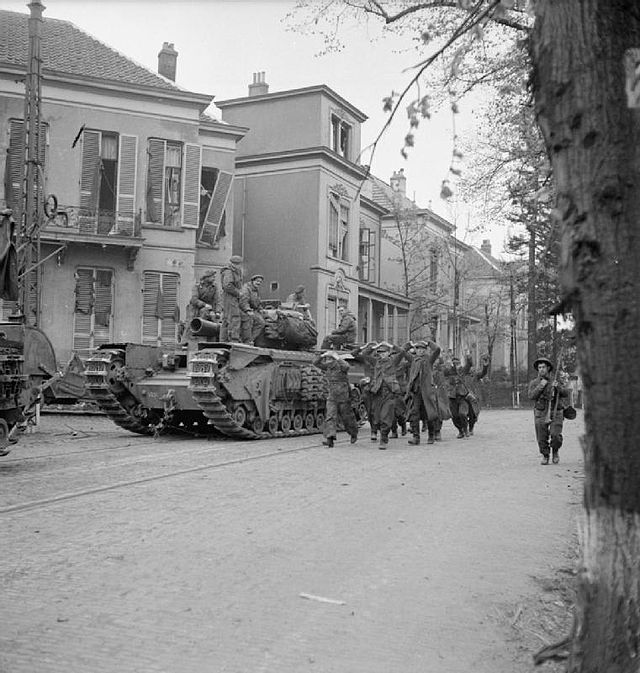 Air War over Europe Air War over EuropeRelentless Allied air attacks on Germany are wiping out the Luftwaffe on the tarmac and the Kriegsmarine in harbour. Figures show that 1,738 enemy aircraft were destroyed in a week's attacks on 59 airfields. A total of 332 were shot down in air combat. Many German planes are limited by a lack of fuel. The Eighth Air Force flies Mission 948: 1,167 bombers are dispatched without escort to visually attack enemy pockets on the Gironde estuary; 2 B-24s are lost; other Allied Air Forces and French naval units attack similar targets; the air attacks precede a ground assault by a French detachment of the Sixth Army Group on the defence pockets which deny the Allies use of port facilities in the Bordeaux area: 480 B-17s hit 15 strongpoints and flak batteries in the Bordeaux/Royan, Pointe Coubre and Pointe Grave areas without loss. 315 B-24s hit 12 strongpoints and flak batteries in the same area as Force 1 above; 2 B-24s are lost. 338 B-17s attack 4 strongpoints and flak batteries in the Bordeaux/Royan area without loss. Himmler orders that no prisoners at Dachau concentration camp "shall be allowed to fall into the hands of the enemy alive." "A handover is out of the question. The camp must be evacuated immediately. No prisoner must be allowed to fall into the hands of the enemy alive," says a handwritten note, apparently referring to Dachau concentration camp. It is signed by Gestapo chief Heinrich Himmler and dated April 14, 1945. 18 Ninth Air Force B-26s fly a leaflet mission in the Ruhr area; fighters fly patrols, sweeps, and armed reconnaissance, and support the US 3d Armored Division southwest of the Elbe/Mulde River junction near Dessau, the 9th Armored Division in the Borna and Lobstadt area, XX Corps elements which continue to arrive at the Zwickauer Mulde River, the VIII Corps along the Weisse Elster River south of Gera, XII Corps elements in the Bayreuth area, the 2d and 5th Armored Divisions along the Elbe River in the Barby-Magdeburg and Tangermunde areas. 29 Fifteenth Air Force P-38s bomb and strafe railroad targets in the Munich and Regensburg-Linz, Austria areas. Fifteenth Air Force bombers attack the Klagenfurt marshalling yard as a target of opportunity. 20 RAF Lancasters of 6 17 Squadron again found their target at Swinemünde covered by cloud and returned without bombing. No aircraft lost. 500 RAF Lancasters and 12 Mosquitos of Nos 1, 3 and 8 Groups attacked Potsdam. This was the first time that Bomber Command 4-engined aircraft had entered the Berlin defence zone since March 1944 but the approach, across parts of Germany recently captured by Allied troops, and the Cuxhaven diversion led to only 1 Lancaster being lost; it was shot down by a night fighter. This was the last raid of the war by a major Bomber Command force on a German city. The aiming point was the centre of Potsdam and the intention was to destroy the local barracks (depot of the old German Guards regiments) and the railway facilities. The attack was reasonably successful and severe damage was caused in Potsdam but bombs also fell in the nearby northern and eastern districts of Berlin. 24 RAF Lancasters and 4 Mosquitos in a diversion raid to Cuxhaven, 62 Mosquitos to Berlin and 10 to Wismar, 54 RCM sorties, 50 Mosquito patrols. No aircraft lost. Italian campaignUS 5th Army joins British 8th Army in mounting the spring offensive operations. There are attacks on either side of the roads to Bologna from Florence and Pistoia. Vergato is captured. Photo: During the air preparation of the big "push" in Italy by the U.S. Fifth Army, the men, mules, and armor of the 10th Mountain Division and supporting tank units move forward between 8:30 A.M. and 9:10 A.M., 14 April 1945. Bologna, Italy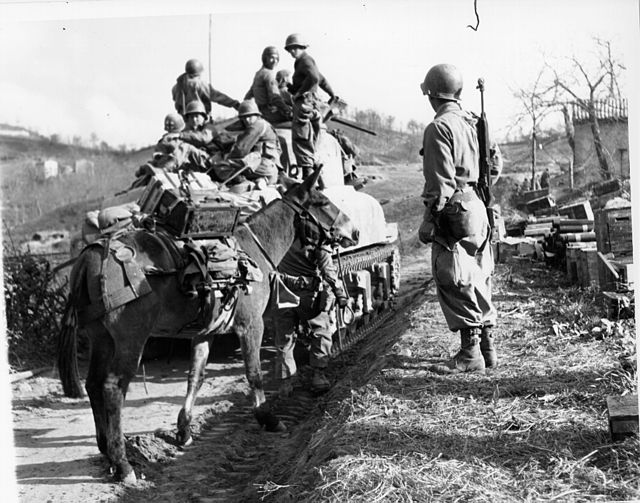 Photo: Tanks take off for their firing positions. Mt. Valbura area, Italy. 14 April, 1945 Photo: Tanks take off for their firing positions. Mt. Valbura area, Italy. 14 April, 1945 During the night of 13/14 April, Twelfth Air Force A-20s and A-26 Invaders continue to hit communications in the Po Valley; bad weather over the northern part of the Brenner line prevents medium bomber attacks but the B-25s, escorted by 54 Thirteenth Air Force P-51s, hit alternates on the southern part of the line at Salorno, San Ambrogio di Valpolicella, and Chiusaforte, bomb gun emplacements southeast of La Spezia in support of the US Fifth Army, and hit 5 defensive positions along the British Eighth Army front in the Argenta area; fighter-bombers concentrate on supporting Fifth Army forces southwest of Bologna. 318 Fifteenth Air Force B-17s and B-24s hit ammunition factories at Avigliana, Spilimbergo, Malcontenta, and Palmanova, and a motor transport depot at Osoppo; 158 fighters provide escort. Battle of the AtlanticAllied forces conduct Operation Teardrop. Two carrier task groups carry out an extensive search for Seewolf U-boats suspected of transporting V2 rockets to be launched against New York city. GermanyReichsfuhrer SS Himmler orders that no prisoners at Dachau "shall be allowed to fall into the hands of the enemy alive." United StatesPhoto: Franklin Delano Roosevelt's funeral procession with horse-drawn casket, Pennsylvania Avenue, 14 April 1945 Pacific War Pacific WarCHINA (Fourteenth Air Force): In China, 24 B-24s, supported by 12 P-51s, bomb Loyang and knock out a bridge over the Yellow River; 30+ B-25s and 130+ fighter-bombers attack bridges (knocking out at least 6), river, road, and rail traffic, troops, storage areas, town areas, and general targets of opportunity over the vast expanse of S and E China; the 118th Tactical Reconnaissance Squadron, Fourteenth AF (attached to 23d Fighter Group), based at Chengkung, begins operating from Laohwangping with P-40s and P-51s. INDIA-BURMA (Tenth Air Force): In Burma, 41 P-47s and P-38s attack troops, supplies, and fuel dumps at Tawnghkam Nawng-hkam, Mong Kung, Loi-makhkawn, and Nawngkaw; 8 P-38s damage bridges at Kong pau and Kyawngteng; 446 transport flights are flown to forward areas. PALAU (Seventh Air Force): 24 Angaur Airfield based B-24s pound supply and personnel areas at Tigatto in the Philippines. GUAM (Twentieth Air Force): B-29 units arriving at Northwest Field, from the US: HQ 16th BG (Very Heavy) and the 16th and 17th Bombardment Squadrons (Very Heavy); HQ 501st BG (Very Heavy) and the 21st and 485th Bombardment Squadrons (Very Heavy). SOUTHWEST PACIFIC [Far East Air Force]: B-25s sweep the Canton-Hong Kong, China waterways, hitting shipping and other targets and B-24s bomb four airfields on Formosa. PHILIPPINE CAMPAIGN (1945) The US 14th Corps continues its advance onto the Bicol Peninsula in the southwest of Luzon. Calauag is taken. In north Luzon, US 1st Corps continues attacking near Baguio but fails to make significant progress. On Luzon Island, B-24s and fighter-bombers bomb island fortifications in Manila Bay, fighter-bombers hit bivouacs and other targets in N Luzon and support ground forces E of Manila and on Carabao Island. Fighter bombers and B-24s fly support missions for ground forces on Negros and Cebu. On Mindanao, B-24s bomb the Davao area and B-25s join US Marine Corps (USMC) aircraft in hitting highways and vehicles. VOLCANO AND RYUKYU ISLANDS CAMPAIGN On Okinawa, American forces attack strong Japanese defenses in the hilly Motobu Peninsula in the north. The 4th and 29th Marines launched a coordinated attack on the Motobu Peninsula inland in an easterly direction and west and southwest from the center of the peninsula, respectively. Off Okinawa, kamikazes damage battleship New York (BB-34), 26°00'N, 128°00'E, and destroyers Sigsbee (DD-502), Dashiell (DD-659), and Hunt (DD-674), 27°15'N, 130°25'E; gunboat PGM-11 is damaged by grounding, 26°13'N, 127°27'E. Carrier-based F6Fs, FM Wildcats and F4Us shoot down 45 Japanese aircraft near the ships of Task Force 58. The aircraft carrier HMS Formidable joins the RN's Task Force 57 replacing HMS Illustrious which is ordered to retire for an overhaul. UNITED STATES NAVY DEPARTMENT COMMUNIQUES, CINCPOA COMMUNIQUÉ NO. 332, APRIL 14, 1945 Elements of the Marine Third Amphibious Corps on Okinawa Island on April 14 advanced northward to the vicinity of Momubaru Town on the west coast and Arakawa Town on the east coast. Resistance was negligible. The Marines on Motobu Peninsula are now in possession of most of that area and are attacking small concentrations of enemy troops which continue to resist. In the southern sector during the early morning hours of April 14, the enemy mounted a small counterattack which was immediately beaten off by troops of the Ninety Sixth Army Division. Enemy positions were brought under fire of field artillery, ships' guns, and carrier and land‑based aircraft. A few enemy aircraft appeared in the area off Okinawa during the day and nine were shot down by our combat air patrols. Aircraft from carriers of the U. S. Pacific Fleet bombed airfields on Ishigaki and Miyako Islands in the Sakishima group on April 14, destroying seven aircraft on the ground and damaging twenty five more. Without opposition, carrier aircraft of the British Pacific Fleet struck airfields and installations at Matsuyama and Shinchiku on Formosa on April 13. A number of aircraft were damaged on the ground and hangars, barracks, buildings, a railway bridge, a train and other targets were heavily hit. Several small groups of enemy planes attempted to attack surface units of the British force and three of these were shot down. The task force suffered no damage. Fighters of the Fourth Marine Aircraft Wing bombed enemy islands in the Palaus on April 14. PACIFIC Tank landing ship LST-241 is damaged by collision, 14°38'N, 140°19'E. Submarine Gabilan (SS-252) attacks Japanese Surabaya-to-Makassar convoy, sinking cargo vessel Kako Maru, 05°19'S, 117°06'E, and auxiliary submarine chaser No.1 Shonan Maru, 05°13'S, 118°12'E. Submarine Tirante (SS-420) attacks Japanese convoy MOSI-02 in the approaches to the Yellow Sea, sinking transport Jusan Maru, escort vessel Nomi, and Coast Defense Vessel No.31 west of Quelpart Island 33°25'N, 126°15'E. For his skill and daring in carrying out this surface attack through mined and shoal-obstructed waters, Lieutenant Commander George L. Street III, Tirante's captain, will receive the Medal of Honor. Japanese auxiliary submarine chaser Cha 11 is sunk by aircraft, 15°45'N, 108°28'E. Japanese merchant cargo ship Kako Go is sunk by aircraft near Rima Island. Mines damage Japanese minelayer Tokiwa 78 miles off Hesaki, and auxiliary minelayer Koei Maru off Hime Jima lighthouse. USAAF B-24s (14th Air Force) bomb Japanese shipping at Shanghai, sinking cargo vessel Takko Maru, 31°14'N, 121°30'E.
|
|
lordroel
Administrator
Posts: 68,007 
Likes: 49,410
|
Post by lordroel on Apr 15, 2024 2:48:55 GMT
Day 2044 of World War II, April 15th 1945Eastern FrontThe Soviet 3rd Ukrainian Front (Tolbuhkin) begins an offensive against the industrial area of Mührisch-Ostrau in Moravia defended by Heeresgruppe Mitte (Schörner). Soviet forces begin a final offensive against the German held positions in the Samland Peninsula. Western Front (1945) - Western Allied invasion of GermanyMap: HQ Twelfth Army Group situation map, April 15th 1945 Units of the US 9th Army, which have crossed the Elbe River near Magdeburg, are forced to retreat. The US 1st Army takes Leuna. Meanwhile, Operation Venerable is launched against the German garrison in the fortress of Royan, at the mouth of the Gironde River; heavy napalm bomb attacks by the US 8th Air Force and shelling by the Free French battleship Lorraine are followed by an attack by Free French and American forces. Photo: Infantrymen of the 80th Division of Gen. Patton's Third Army passing the Carl Zeiss Lens and Camera Plant in newly-captured Jena, Germany. 15 April, 1945 The first British troops entered Bergen- Belsen on Sunday, April 15th 1945, at 3 p.m., led by Brigadier H.L. Glyn Hughes, the Chief Medical Officer of the British Second Army (with anti-tank battery of 63 A/Tk Regt, Royal Artillery.) Brigadier Hughes cried when he saw the horrible conditions of the camp. He later mentioned that "Belsen was unique in its vile treatment of human beings. Nothing like it had happened before in the history of mankind. The victims of this infamous behavior had been reduced to a condition of sub-human existence" The liberators' most urgent concerns included separating the sick from the living, burying the dead, and caring for the sick. While Bergen-Belsen contained no gas chambers, more than 35,000 people died of starvation, overwork, disease, brutality and sadistic medical experiments. Anne Frank and her sister, Margot, died of typhus in March 1945, along with other prisoners in a typhus epidemic. Photo: A Comet tank of 11th Armoured Division approaches the neutral exclusion zone thrown up around Bergen-Belsen concentration camp, 15 April 1945 Photo: A Comet tank of 11th Armoured Division passes the camp gate at Bergen Belsen concentration camp, 15 April 1945 Photo: A Comet tank of 11th Armoured Division passes the camp gate at Bergen Belsen concentration camp, 15 April 1945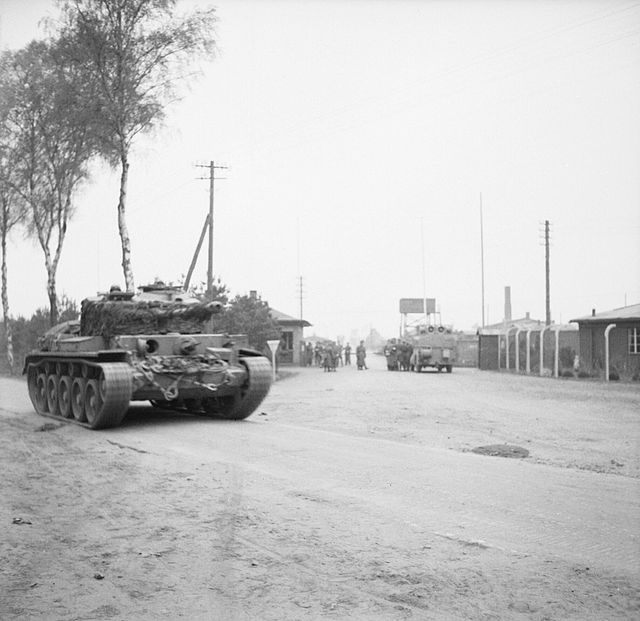 A heavily guarded convoy of US Army trucks moves the Reichsbank gold reserve from the potassium mines here back to the vaults of the Reichsbank in the recently captured city of Frankfurt-am-Main. By mid-August the gold will have been quantified and appraised. The gold is valued at $262,213,000 US dollars (4,575,760,923.08 dolloers in 2024). Western Front (1945) - Liberation of the NetherlandsAllied troops captured Zutphen, Leeuwarden, and Zoutkamp in the Netherlands. Photo: A soldier looks down the approach road to the bridge at Arnhem, scene of bitter fighting during the previous September, 15 April 1945 Photo: An armoured bulldozer at work clearing debris in Arnhem, 15 April 1945 Photo: An armoured bulldozer at work clearing debris in Arnhem, 15 April 1945 Western Front (1945) - Liberation of Belgium Photo: Belgian and French former POWs wait at Rheine aerodrome to board RAF Dakota aircraft which will transport them to Brussels, 15 April 1945 Western Front (1945) - Liberation of Belgium Photo: Belgian and French former POWs wait at Rheine aerodrome to board RAF Dakota aircraft which will transport them to Brussels, 15 April 1945 Air War over Europe Air War over Europe106 RAF Mosquitos to Berlin, 8 to Oranienburg airfield and 4 to Lechfeld airfield, 27 RCM sorties, 19 Mosquito patrols. 1 Mosquito of No 100 Group lost. Italian campaign Both US 5th and British 8th Armies continue their attacks. Elements of the Polish 2nd Corps (part of British 8th Army) has reached the Sillario River after crossing the Santero River. Photo: German prisoners, taken by troops of the 10th Mountain Division, are marched to a stockade behind Fifth Army lines in Campidello, Italy, 15 April 1945  Battle of the Atlantic Battle of the AtlanticDestroyer escorts Frost (DE-144) and Stanton (DE-247) sinks German submarine U-1235, North Atlantic, 47°54'N, 30°25'W. GermanyAdolf Hitler issues an order in the event that Germany is split into northern and southern areas, Admiral Karl Dönitz would be appointed Commander-in-Chief of the north, or General Field Marshal Albert Kesselring would be Commander-in-Chief of the south, with Hitler in charge of the other part. United StatesPhoto: The U.S. Navy high-speed transport USS Burke (APD-65) off Norfolk, Virginia (USA), on 15 April 1945. She is painted in Camouflage Measure 31, Design 20L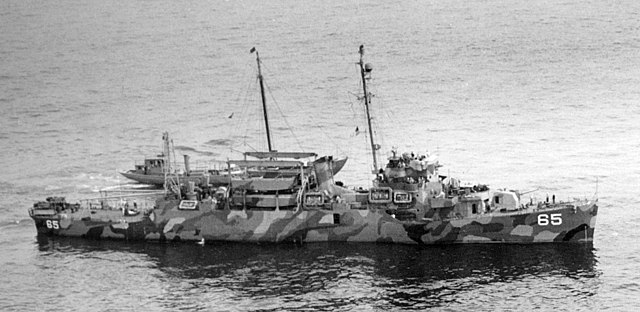 Pacific War Pacific WarCHINA (Fourteenth Air Force): In China, 3 B-25s knock out the Pa- Ching pontoon bridge, 7 pound a storage depot at Fang-cheng, 4 bomb Tunganhsien, and 3 hit Paoching; 1 B-24 bombs the Canton docks; almost 200 fighter-bombers ranging over all of S China and up into the N China plain hit numerous targets including bridges, river shipping, town areas, trucks, railroad traffic, gun positions, storage areas, and general targets of opportunity; the Paoching, Hengyang, Yungfengshih, and Hsihhsiassuchi areas are especially hard hit. INDIA-BURMA (Tenth Air Force): In Burma, 62 P-38s and P-47s attack troop concentrations and supply areas at Loi-Mwe, Lawksawk, Thongdan, and near Laihka; 312 transport sorties are flown to forward areas. HQ AAF (Twentieth Air Force): 2 missions are flown during the night of 15/16 Apr. Mission 68: 194 B-29s bomb the Kawasaki urban area; 8 others hit targets of opportunity; 12 B-29s are lost. Mission 69: 109 B-29s hit the urban area of Tokyo; 1 B-29 is lost. SOUTHWEST PACIFIC AREA [Far East Air Force]: On Formosa B-24s bomb Toyohara, Shinchiku, and Shinshoshi Airfields and B-25s hit the Shoka rail yards. The 4th Fighter Squadron (Commando), 3d Air Commando Group, moves from Mangaldan to Laoag with P-51s. BURMA The British 20th Indian Division (part of British 33rd Corps) captures Taungdwingyi and moves toward Magwe and Thayetmyo. Other units of British 33rd Corps are still fighting farther up the Irrawaddy River. JAPAN Aircraft of fast carrier task force (Vice Admiral Marc A. Mitscher) attack airfields and aircraft on the ground in southern Kyushu, Japan; strike is repeated on 16 April. PHILIPPINE CAMPAIGN (1945) A battalion of the 151st Infantry Regiment, 38th Infantry Division, lands on Carabao Island at the entrance to Manila Bay; landing is preceded by cruiser/destroyer and aircraft bombardment. Far East Air Forces B-24s and fighter-bombers bomb island fortifications in Manila Bay, fighter-bombers hit bivouacs and other targets in northern Luzon and support ground forces east of Manila and on Carabao Island. Fighter bombers and B-24s fly support missions for ground forces on Negros and Cebu Islands. On Mindanao Island, B-24s bomb the Davao area and B-25s join USMC F4U Corsairs and SBD Dauntlesses in hitting highways and vehicles. VOLCANO AND RYUKYU ISLANDS CAMPAIGN On Okinawa, the US 6th Marine Division assaults Yae Hill but is driven back by the Japanese defense. Off Okinawa, kamikazes damage destroyers Wilson (DD-408), 26°03'N, 127°20'E, and Laffey (DD-724), 27°16'N, 127°50'E; Japanese assault demolition boat damages motor minesweeper YMS-331, 26°15'N, 127°36'E; attack transport Berrien (APA-62) is damaged by friendly fire. ALASKA (Eleventh Air Force): A B-24 flies a weather reconnaissance mission. UNITED STATES NAVY DEPARTMENT COMMUNIQUES, CINCPOA COMMUNIQUÉ NO. 333, APRIL 15, 1945 Three enemy counterattacks in the Southern sector of Okinawa were broken up by Marine and Army artillery on the night of April 14‑15 (East Longitude Date). At noon on April 15, the Twenty‑Fourth Army Corps lines were unchanged. In the north, Marines of the Third Amphibious Corps continued to mop up small units of the enemy. In the Western area of Motobu Peninsula one isolated group of the enemy was offering stiff resistance. Ground forces continued to receive effective support from Naval guns, carrier and land-based aircraft, and field artillery. Keufu Island in the Kerama Group was occupied by our troops on April 14. Privateers of Fleet Air Wing One damaged a small cargo ship near Tanega Island in the northern Ryukyus and bombed and strafed buildings and radio towers on the Island on April 15. A Marine Mitchell scored rocket hits on a small ship in the area of the Bonins on the night of April 14‑15. On the same date, Army night fighters attacked targets on Haha Jima, Chichi Jima and Muko Jima in the Bonins. Corsair and Hellcat fighters of the Fourth Marine Aircraft Wing damaged bridge and pier installations in the Palaus on April 15. UNITED STATES NAVY DEPARTMENT COMMUNIQUES, CINCPOA ADVANCE HEADQUARTERS, GUAM, APRIL 15, 1945 1. Elements of the Marine Third Amphibious Corps on Okinawa Island on April 14 advanced northward to the vicinity of Momubaru town on the west coast and Arakawa town on the east coast. Resistance was negligible. The Marines on Motobu Peninsula are now in possession of most of that area and are attacking small concentrations of enemy troops which continue to resist. 2. In the southern sector during the early morning hours of April 14 the enemy mounted a small counterattack which was immediately beaten off by troops of the Ninety Sixth Army Division. Enemy positions were brought under fire of field artillery, ships' guns and carrier and land‑based aircraft. 3. A few enemy aircraft appeared in the area off Okinawa during the day and nine were shot down by our combat air patrols. 4. Aircraft from carriers of the U. S. Pacific Fleet bombed airfields on Ishigaki and Miyako Islands in the Sakishima group on 14 April, destroying seven aircraft on the ground and damaging twenty five more. 5. Without opposition, carrier aircraft of the British Pacific Fleet struck airfields and installations at Matsuyama and Shinchiku on Formosa on 13 April. A number of aircraft were damaged on the ground and hangars, barracks, buildings, a railway bridge, a train and other targets were heavily hit. Several small groups of enemy planes attempted to attack surface units of the British force and three of these were shot down. The task force suffered no damage. 6. Fighters of the Fourth Marine Aircraft Wing bombed enemy islands in the Palaus on 14 April. C. W. NIMITZ, Fleet Admiral, U. S. Navy, Commander in Chief, U. S. Pacific Fleet, and Pacific Ocean Areas. PACIFIC Submarine Charr (SS-328) lays mines off the Malay Peninsula. Japanese guardboat No.2 Hinode Maru is sunk by U.S. aircraft off Chezhudo, 33°19'N, 127°21'E. Mine laid by USAAF B-29 (20th Air Force) sinks Japanese cargo ship No.3 Yamanami Maru southeast of Hesaki Light, 33°53'N, 131°02'E. Hulk of Japanese army tanker Shincho Maru (sunk by TF 38 planes on 21 January) is scuttled across entrance of Takao, Formosa, harbor.
|
|
lordroel
Administrator
Posts: 68,007 
Likes: 49,410
|
Post by lordroel on Apr 16, 2024 2:48:45 GMT
Day 2045 of World War II, April 16th 1945YouTube (Soviet Berlin Offensive Begins)Eastern FrontThe Red Army launches the final offensive on Berlin. The 1st Belorussian Front (Marshal Zhukov), to the east, and 1st Ukraine Front (Marshal Konev), to the southeast, lead the assault with support from 2nd Belorussian Front (Marshal Rokossovsky) in the north. Stalin is nominally in command of the operation and at this time it is not clear whether the armies commanded by Zhukov, or those commanded by Konev, are to make the final assault on the city. The two Soviet Fronts comprise over 2,000,000 men with more than 6000 tanks and self-propelled guns, about 6000 aircraft and almost 16,000 artillery tubes. Photo: At the observation post of the 8th Guards Army in the battles for Seelow Heights. In the center, Army Commander V.I. Chuikov, on the right, a member of the Military Council of the Army A.M. Pronin, 16 April 1945 The German troops defending the line are organized into Army Group Vistula (General Heinrici), facing 1st and 2nd Belorussian Fronts, and Army Group Center (Field Marshal Schorner), facing 1st Ukrainian Front. There are about 1,000,000 German troops deployed in fairly strong and well-prepared positions overlooking the west bank of the Oder River and Neisse River, however, they lack significant stocks of armor, artillery and aircraft. After the massive artillery preparation, the attacks of 1st Belorussian Front begin from the Soviet bridgehead already taken west of the Oder, near Kustrin. By a well-timed short withdrawal the forces of the German Army Group Vistula have avoided the worst effects of this Soviet bombardment, but they have insufficient strength to do more than hold the Soviet attack temporarily. The attack of 1st Ukrainian Front begins a little later over the Neisse, north and south of Triebel. Map: Initial position for the Battle of the Oder on April 16, 1945
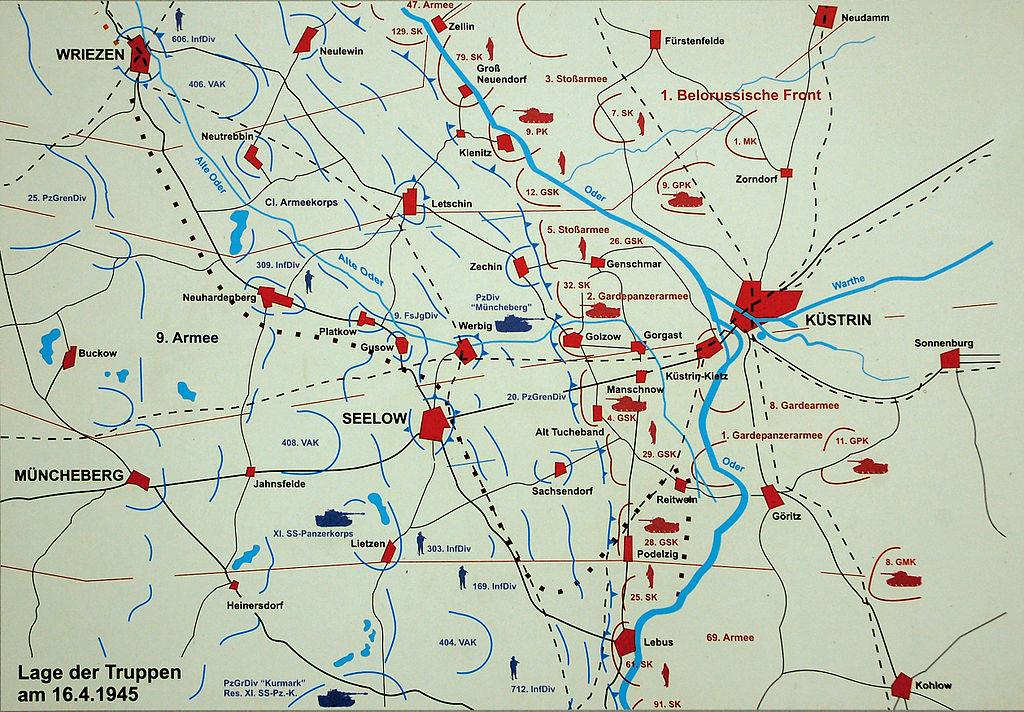 Western Front (1945) - Western Allied invasion of GermanyMap: HQ Twelfth Army Group situation map, April 16th 1945 Western Front (1945) - Western Allied invasion of GermanyMap: HQ Twelfth Army Group situation map, April 16th 1945 US 7th Army units reach the outskirts of Nuremberg. The special prisoner of war camp at Colditz is liberated by other Allied units during the day. Photo: Light tank of 6th Armored Division of Gen. Patton's U.S. Third Army rolling into newly-captured town of Zeitz, Germany. 16 April, 1945 Photo: Street scene in Seehausen, Germany, shows elements of a tank battalion, 5th Armored Division, 9th U.S. Army, and civilians eager to get to the stores before curfew. 16 April, 1945 Photo: Street scene in Seehausen, Germany, shows elements of a tank battalion, 5th Armored Division, 9th U.S. Army, and civilians eager to get to the stores before curfew. 16 April, 1945 Photo: Infantry of the Royal Scots Fusiliers supported by Churchill tanks move quickly over open ground during operations to outflank German resistance in Uelzen, 16 April 1945 Photo: Infantry of the Royal Scots Fusiliers supported by Churchill tanks move quickly over open ground during operations to outflank German resistance in Uelzen, 16 April 1945 Photo: A sniper from the Seaforth Highlanders takes aim from behind a carrier as 15th (Scottish) Division troops deal with German resistance in Uelzen, 16 April 1945 Photo: A sniper from the Seaforth Highlanders takes aim from behind a carrier as 15th (Scottish) Division troops deal with German resistance in Uelzen, 16 April 1945 Photo: Comet tanks of 23rd Hussars, 11th Armoured Division pause during the drive on the Elbe, 16 April 1945 Photo: Comet tanks of 23rd Hussars, 11th Armoured Division pause during the drive on the Elbe, 16 April 1945 Photo: Ram Kangaroo personnel carriers of 4th Armoured Brigade in Rethem, 16 April 1945 Photo: Ram Kangaroo personnel carriers of 4th Armoured Brigade in Rethem, 16 April 1945 Western Front (1945) - Liberation of the NetherlandsPhoto: Dutch civilians throw flowers into the path of a Churchill tank in the small town of Velp, 16 April 1945 Western Front (1945) - Liberation of the NetherlandsPhoto: Dutch civilians throw flowers into the path of a Churchill tank in the small town of Velp, 16 April 1945 Air War over Europe Air War over Europe RAF Meteor III jets make their first operational sortie on the Continent. 18 RAF Lancasters of No 617 Squadron flew to Swinemünde to attack the pocket battleship 'Lützow'. 1 Lancaster was shot down (No 617 Squadron's last loss of the war) and all but 2 aircraft were damaged. 15 aircraft managed to bomb the target with Tallboys or with 1,000-pounders. The effects of one near miss with a Tallboy tore a large hole in the bottom of the 'Lützow' and she sank in shallow water at her moorings. Italian campaign Photo: Fifth Army, Roffeno Area, Italy. Members of the 1st Battalion, 86th Infantry Regiment, 10th Mountain Division area tying on part of a 37 mm pack gun. This piece weighs approximately 22 lbs. It takes two mules to carry the whole weapon. The mules are from the U.S, 16 April 1945 Photo: After the 126th Mountain Engineers, 10th Mountain Division cleared a demolition, a tank of the 751st Tank Battalion, who is in support of the 10th Mountain Division, advances on Tole, Italy. 16 April, 1945 Photo: After the 126th Mountain Engineers, 10th Mountain Division cleared a demolition, a tank of the 751st Tank Battalion, who is in support of the 10th Mountain Division, advances on Tole, Italy. 16 April, 1945 The 8th Air Force flies Mission 951: 1,348 unescorted bombers are dispatched to attack strongpoints on the French Atlantic coast; the first two forces below make the sole operational employment of napalm bomb by the 8th Air Force against German ground installations; the results are negligible and HQ recommends its discontinuance against this type of target: 492 B-17s hit four strongpoints and flak batteries in the Royan area without loss. 341 B-24s hit six strongpoints and flak batteries in the Royan area without loss. 442 B-17s hit 9 strongpoints and flak batteries in the Bordeaux/Royan, Pointe Grave and Pointe Courbre area without loss. The 8th Air Force flies Mission 955: During the morning, 485 B-17s bomb the tank ditch defence line at Pointe de Grave on the south side of the Gironde estuary in the Bordeaux area in support of the ground assault in that area. Battle of the Atlantic'U-1235' is sunk in the North Atlantic by destroyer escorts USS 'Frost' (DE-144) and USS 'Stanton' (DE-247). All 57 crewmen on the U-boat are lost. 'U-880' is sunk in the North Atlantic by depth charges from the destroyer escorts USS' Frost' (DE-144) and USS 'Stanton' (DE-247). All 49 crewmen on the U-boat are lost. Minesweeper HMCS 'Esquimalt' is attacked and sunk by 'U-190' (Oblt.Hans-Edwin Reith) off Halifax, Nova Scotia. There are 44 casualties. Frigate HMS 'Ekins' strikes a mine which causes her boiler room to flood, and she lies dead in the water. The ship's company are able to get the ship moving again, and she returns to the Medway under her own power. United States The federal government tacked another year on to the term of one of Roosevelt's key pieces of wartime legislation, the Lend-Lease Act. All told, the U.S. funneled US$50.6 billion (US$866.99 billion in year 2024 dollars) worth of Lend-Lease aid to the Allies during the war, the majority of which went to Britain and the USSR. Pacific WarCHINA (Fourteenth Air Force): In China, 18 B-24s pound a storage area at Linfen; 3 bomb targets of opportunity in the Bakli Bay, Hainan Island and Canton areas; 10 B-25s bomb Yungfengshih, Kweilin, and Shanhsien, knocking out 1 bridge and hitting buildings, river shipping, and rail traffic. About 120 fighter-bombers over S and E China hit river, road, and rail traffic, town areas, troops, and general targets of opportunity at many scattered locations; the 490th Bombardment Squadron (Medium), 341st BG (Medium), based at Hanchung sends a detachment to operate from Hsian with B-25s. INDIA-BURMA (Tenth Air Force): In Burma, 22 fighter-bombers pound troop concentrations in the Ke-hsi Mansam vicinity; 19 others attack road bridges behind enemy lines, claiming 1 bridge destroyed; air transport operations to forward areas continue on steady basis. BURMA Allied advances are continuing in Burma, with the capital, Rangoon, now firmly in General Slim's sights. Today it was the turn of Taungup, in the Arakan peninsula, to fall to XV Corps, while inland IV Corps is chasing General Honda's 33rd Japanese Army down the Sittang Valley towards Pyinmanna. The Japanese forces are also in retreat along the Irrawaddy, where XXXIII Corps is driving south to oil-rich Yenangyaung. GUAM Seventh Air Force: 18 Guam Island-based B-24s pound Marcus Island in the N Pacific. 2 P-61s from Saipan bomb and strafe Pagan. VII Fighter Command: Mission 3: In the first very long range fighter operation from Iwo Jima, P-51s with Twentieth AF B-29 navigational escort, strafe and bomb targets at Kanoya Airfield; 4 P-51s are lost; B-25s continue to furnish navigational escort in all subsequent VII Fighter Command strikes (through 14 Aug) on Japan from Iwo Jima. SOUTHWEST PACIFIC AREA [Far East Air Force]: On Formosa, B-25s hit Taien Airfield, while B-24s and P-51s bomb Giran and Matsuyama Airfields and nearby areas. P-38s pound Lingkas Tank Farm and other targets at Tarakan. During the night of 15/16 Apr B-24s bomb Taihoku, Formosa. The 387th Bombardment Squadron, 312th BG moves from Mangaldan to Floridablanca with A-20s. PHILIPPINE CAMPAIGN (1945) The 1st Battalion, 151st Infantry Regiment, 38th Infantry Division, makes an unopposed landing on Carabao Island in Manila Bay. The landing had been supported by the light cruiser USS Phoenix, two destroyers and two infantry landing craft (rocket). The Phoenix had blown a hole in the seawall and the only thing encountered by the soldiers was "one badly shaken pig." Ft. Frank, a "concrete battleship", in Manila Bay is attacked with fuel oil and allowed to burn. Ft. Drum had been similarily attacked on the 14th. This completes the capture of Japanese positions in Manila Bay. Fighter bombers hit N Luzon Island bivouacs and other targets and support strikes and sweeps are flown over Cebu, Negros, and Mindanao with B-25s hitting highways on Mindana and B-24s hit defenses on Carabao Island. VOLCANO AND RYUKYU ISLANDS CAMPAIGN The US 77th Infantry Division lands on the small island of Ie Shima and encounters heavy Japanese resistance. Off Okinawa, kamikazes sink destroyer Pringle (DD-477), 27°26'N, 126°59'E; and damage carrier Intrepid (CV-11), 27°37'N, 131°14'E; battleship Missouri (BB-63), 26°00'N, 130°00'E; destroyer Bryant (DD-665), 27°05'N, 128°13'E; destroyer escort Bowers (DE-637), 26°52'N, 127°52'E; high speed minesweepers Hobson (DMS-26), 27°26'N, 126°59'E, and Harding (DMS-28), 26°42'N, 127°25'E; and oiler Taluga (AO-62), 26°03'N, 127°26'E. Destroyer McDermut (DD-677) is damaged by friendly fire, 27°30'N, 130°20'E. Photo: The U.S. Navy aircraft carrier USS Intrepid (CV-11) afire, after she was hit by a Kamikaze off Okinawa on 16 April 1945. A Fletcher-class destroyer steams by in the foreground Photo: The U.S. Navy aircraft carrier USS Intrepid (CV-11) burning after the ship was hit by two Japanese kamikaze aircraft, 16 April 1945 Photo: The U.S. Navy aircraft carrier USS Intrepid (CV-11) burning after the ship was hit by two Japanese kamikaze aircraft, 16 April 1945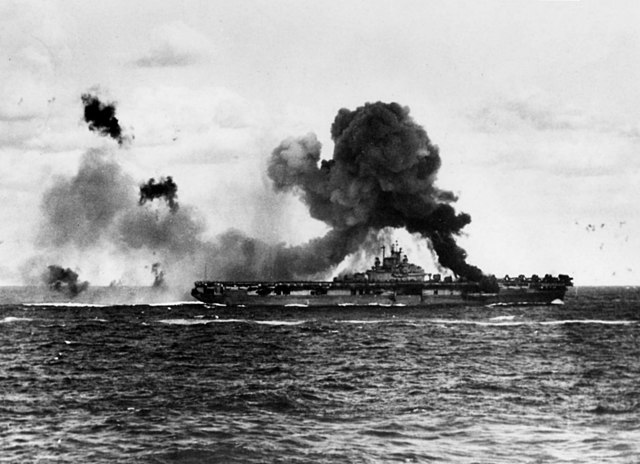 Photo: The U.S. Navy destroyer USS Laffey (DD-724) photographed from USS PCE-851, on Okinawa Radar Picket Station Number One, after being hit by five kamikazes, two bombs, and some near misses, on 16 April 1945 Photo: The U.S. Navy destroyer USS Laffey (DD-724) photographed from USS PCE-851, on Okinawa Radar Picket Station Number One, after being hit by five kamikazes, two bombs, and some near misses, on 16 April 1945 Photo: The U.S. Navy destroyer escort USS Bowers (DE-637) arriving in the Kerama Retto, Ryukyu Islands, under her own power after being hit by a Kamikaze on 16 April 1945. Wreckage of the plane, a Nakajima Ki-43 (Allied code name "Oscar"), can be seen embedded in the the ship's bridge face. Note Bowers' very unusual paint, with traces of Camouflage Measure 31 or 32, Design 16D, showing through Camouflage Measure 22. The ship may have been undergoing repainting at the time she received this damage Photo: The U.S. Navy destroyer escort USS Bowers (DE-637) arriving in the Kerama Retto, Ryukyu Islands, under her own power after being hit by a Kamikaze on 16 April 1945. Wreckage of the plane, a Nakajima Ki-43 (Allied code name "Oscar"), can be seen embedded in the the ship's bridge face. Note Bowers' very unusual paint, with traces of Camouflage Measure 31 or 32, Design 16D, showing through Camouflage Measure 22. The ship may have been undergoing repainting at the time she received this damage ALASKA (Eleventh Air Force): B-25s abort a mission to bomb Hayakegawa because of weather front; 6 B-24s radarbomb the Kataoka naval base on Shimushu; another B-24 flies a radar-ferret sortie. UNITED STATES NAVY DEPARTMENT COMMUNIQUES, CINCPOA COMMUNIQUÉ NO. 334, APRIL 16, 1945 Supported by carrier aircraft and by naval gunfire, elements of the Twenty Fourth Army Corps landed on le Shima, an island west of Okinawa, on the morning of April 16 (East Longitude Date). Advancing inland rapidly against resistance which was initially light but later stiffened, our troops captured the enemy airfield and secured most of the area west of that point. The greater part of the enemy defense force has been driven back to defensive positions in the pinnacles southeast of the airfield. Marines of the Third Amphibious Corps continued to attack groups of the enemy on Motobu Peninsula, Okinawa, on April 16. Marine forces continued to advance northward in the rugged terrain of the island north of the peninsula. There was little change in the lines of the Twenty Fourth Army Corps in the southern sector of Okinawa. Naval guns and carrier planes attacked enemy positions in the south. At the end of April 13 our forces on Okinawa had killed 9,108 of the enemy and captured 391 prisoners of war. About 85,000 civilians had come under jurisdiction of the U. S. Military Government on the island by the end of April 15. Our Military Government authorities have constructed one large camp and have taken over thirteen villages for use of civilians. Civilian foodstuffs are being salvaged and used. Our medical facilities have proved adequate for treatment of civilians thus far. Fast carrier task forces of the U. S. Pacific Fleet attacked aircraft, airfields and other military installations in the northern Ryukyus and on the island of Kyushu during the period April 12 to 15 (East Longitude Dates). In sweeps over airfields on Kikai and Tanega our planes shot down 77 enemy aircraft from April 12 to 14. Attacking major air bases at Kanoya and Kushira on Kyushu on April 15, U. S. carrier planes shot down 29 aircraft, destroyed 58 on the ground and damaged 60 more. The enemy launched heavy air attacks against our forces in and around Okinawa on the morning of April 16. Strong combat air patrols from the fast carrier task forces of the U. S. Pacific Fleet met the attacking enemy aircraft and preliminary reports indicate that our planes shot down 62 enemy aircraft over the Okinawa area. Fighters, sweeping Kyushu, shot down 22 more, antiaircraft guns of the fast carrier forces shot down 15, and 67 more were shot out of the air by combat air patrols in the Ryukyus area. Ship's antiaircraft fire off the Okinawa beaches destroyed 38 Japanese planes on April 16. Land‑based aircraft shot down an unreported number. On April 16, Army Mustang fighters of the Seventh Fighter Command based on Iwo Island attacked ground installations at Kanoya and Kushira on Kyushu. Army Black Widow night fighters attacked military installations in the Bonins during the night of April 15‑16. Search planes of Fleet Air Wing One damaged a small cargo ship heavily on April 16 in the northern Ryukyus. PACIFIC Army forces covered by naval gunfire and carrier aircraft land on Ie Shima, Ryukyus. Submarine Sea Dog (SS-401) sinks Japanese merchant cargo ship Toko Maru off Mikura Jima, 33°31'N,139°36'E. Submarine Sunfish (SS-281) attacks Japanese convoy emerging from Yamado harbor, Honshu, and sinks Coast Defense Vessel No.73 and transport Manryu Maru, 39°35'N, 142°06'E. Mine laid by USAAF B-29 (20th Air Force) damages Japanese cargo vessel No.10 Kaishin Maru off Shimonoseki, 33°53'N, 131°09'E.
|
|
lordroel
Administrator
Posts: 68,007 
Likes: 49,410
|
Post by lordroel on Apr 17, 2024 2:48:48 GMT
Day 2046 of World War II, April 17th 1945Eastern FrontThe Soviet attacks east of Berlin continue. In the very fierce battles, which have developed, the Germans are fighting with skill and desperation but are slowly being forced to give ground. Meanwhile, in Austria and Czechoslovakia, the Soviet attacks and German losses continue, Zisterdorf and Polten are taken in Austria. Western Front (1945) - Western Allied invasion of GermanyMap: HQ Twelfth Army Group situation map, April 17th 1945 Germans units in the Ruhr are beginning to surrender on a large scale. There is also fighting near Bremen and Nuremberg. It is two days since the British Army agreed a truce with the local German commander which enabled them to enter Bergen-Belsen peacefully. The Hungarian army guards who stayed on duty "to prevent a mass breakout", have shot dead 83 prisoners for minor offences. Now the British are in full control, and a Jewish sergeant, Norman Turgel, has arrested Josef Kramer, the camp's commandant. Kramer's men have been disarmed and put to work burying the estimated ten thousand dead lying around the camp. They have to be locked up to protect them from the vengeance of prisoners. Yesterday seven Kapos [prisoner-guards] were savagely beaten to death. U.S. Lieutenant Colonel Boris T. Pash commandeers over half a ton of uranium at Strassfut, in an effort to prevent the Soviets from developing an A-bomb. Pash was head of the Alsos Group, organized to search for German scientists in the postwar environment in order to prevent the Soviets, previously Allies but now a potential threat, from capturing any scientists and putting them to work at their own atomic research plants. Uranium piles were also rich "catches," as they were necessary to the development of atomic weapons. Photo: Universal carriers pass through the ruins of Massendorf, 17 April 1945
 Photo: Men of 6th King's Own Scottish Borderers move forward at the double during the assault on Uelzen, 17 April 1945 Photo: Men of 6th King's Own Scottish Borderers move forward at the double during the assault on Uelzen, 17 April 1945 Western Front (1945) - Liberation of the Netherlands Western Front (1945) - Liberation of the NetherlandsGerman resistance in the Netherlands was effectively ended with the surrender of the Apeldoorn garrison. The Germans had intended to make a stand along the canal, but the Canadians sent the 5th Armoured Division up from Arnhem to surround the town. After this the remaining German garrisons along the Grebbe Line followed suit and by 19 Apr fighting was almost finished allowing food supplies to be sent forward for the starving Dutch population. Photo: A Sherman Firefly of 5th Canadian Armoured Division assists troops of 11th Royal Scots Fusiliers, 49th (West Riding) Division to clear the Germans from Ede, 17 April 1945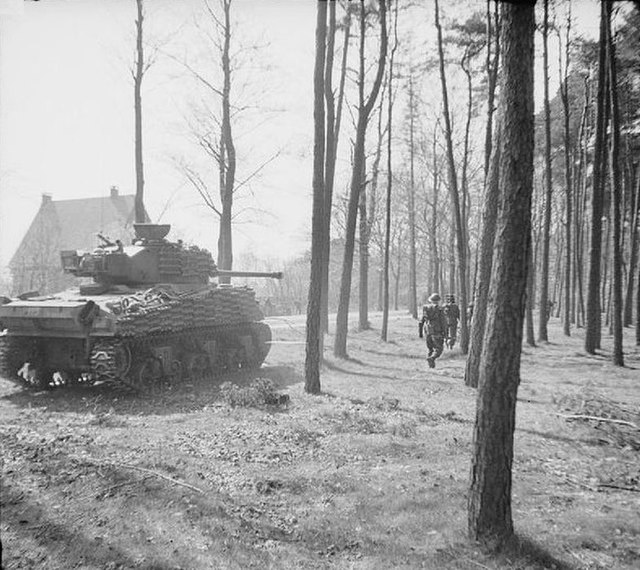 Photo: Sherman tanks of the 5th Canadian Armoured Division and infantry of the 11th Royal Scots Fusiliers, 49th (West Riding) Division, advance through the outskirts of Ede in Holland, 17 April 1945 Photo: Sherman tanks of the 5th Canadian Armoured Division and infantry of the 11th Royal Scots Fusiliers, 49th (West Riding) Division, advance through the outskirts of Ede in Holland, 17 April 1945 Photo: Universal carrier of 11th Royal Scots Fusiliers, 49th (West Riding) Division, during operations to clear the Germans out of the Dutch town of Ede, 17 April 1945 Photo: Universal carrier of 11th Royal Scots Fusiliers, 49th (West Riding) Division, during operations to clear the Germans out of the Dutch town of Ede, 17 April 1945 Photo: Dutch civilians cheer as a Sherman Firefly of 5th Canadian Armoured Division enters Ede, 17 April 1945 Photo: Dutch civilians cheer as a Sherman Firefly of 5th Canadian Armoured Division enters Ede, 17 April 1945 Photo: Infantry of the 11th Royal Scots Fusiliers, 49th (West Riding) Division, searching houses in Ede in Holland, 17 April 1945 Photo: Infantry of the 11th Royal Scots Fusiliers, 49th (West Riding) Division, searching houses in Ede in Holland, 17 April 1945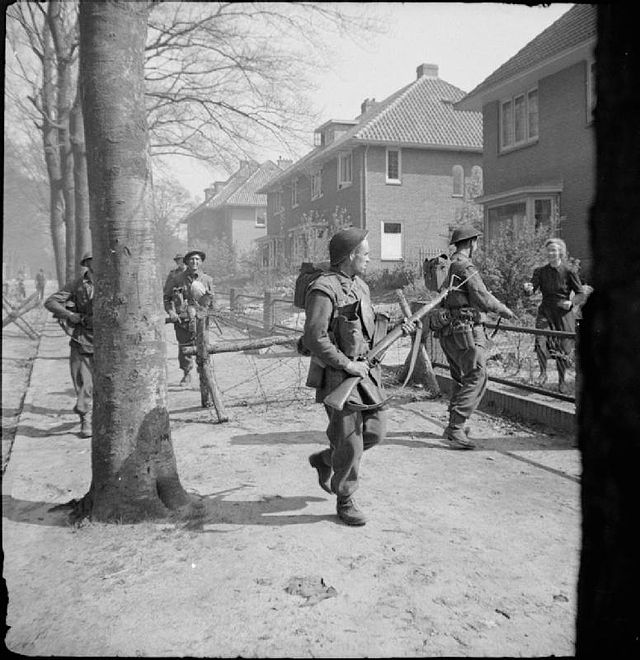 Air War over Europe Air War over Europe Allied bombing has destroyed over a thousand Luftwaffe aircraft on the ground as US troops reach Magdeburg. The Eighth Air Force flies Mission 957: 1,054 bombers and 816 fighters are dispatched to hit rail targets in eastern Germany and western Czechoslovakia; 50 Luftwaffe fighters are encountered, mostly jets and the AAF claims a total of 300-0-119 aircraft destroyed on the ground and in the air (including 4 jets); 8 bombers and 17 fighters are lost. 152 B-17s bomb the rail center at Dresden and 276 bomb the marshalling yard at Dresden; they claim 1-0-1 aircraft; 6 B-17s are lost. Escorting are 230 P-51s; they claim 2-0-3 aircraft in the air and 91-0-37 on the ground; 2 P-51s are lost. 76 B-17s bomb the Dresden area and 86 attack the rail junction and station at Aussig; 86 hit the secondary target, the marshalling yard at Dresden; 2 B-17s are lost. 265 P-51s escort claiming 11-0-2 aircraft in the air and 142-0-47 on the ground; 14 P-51s are lost. 55 B-24s hit the rail center and junction at Fischern while 37 bomb the rail junction and bridge at Falkenau. The escort is 228 P-47s and P-51s; they claim 53-0-29 aircraft on the ground; 1 P-51 is lost. At Saaz, P-47s and P-51s bounce a flight of four Me 262s from JG 7 trying to land at the airbase. All four jets are destroyed with only Oblt. Grünberg baling out of his aircraft and surviving. The Ninth Air Force's 9th Bombardment Division attacks the defended city of Magdeburg (including numerous gun positions in the area), marshalling yard and ordnance depot at Aalen, marshalling yard and ordnance depot at Tubingen, and ordnance depot at Ravensburg; fighters fly escort to the bombers, fly patrols, area cover, and armed reconnaissance, hit airfields at Marianske Lazne and Michalovy Hory, and support the US 3d Armored Division mopping up south of the Elbe River and west of the Mulde River near Dessau, the 9th Armored Division along the Mulde east of Leipzig, the VIII Corps in the Greiz-Zwickau area, the XX Corps southwest of Chemnitz, the 5th Armored Division at the Knesebeck Forest, south of Wittingen, and the 2d Armored Division opening an assault on Magdeburg. 147 Fifteenth Air Force P-38s divebomb railroad bridges at Seefeld and Mariahof. Fifteenth Air Force P-51s, with 10 flying top cover, strafe targets of opportunity in the Munich, Germany, Plzen, Czechoslovakia, and Linz, Austria areas. 90 RAF Lancasters and 11 Mosquitos of No 5 Group attacked the railway yards in the small town of Cham deep in south-eastern Germany. The attack was completely successful, with tracks torn up and rolling stock destroyed. No aircraft lost. 61 RAF Mosquitos to Berlin and 43 to Ingoldstadt airfield, 28 RCM sorties, 40 Mosquito patrols. 2 Mosquitos lost from the Berlin raid. Photo: Aerial photograph of Langar airfield looking north north west, with the control tower and technical site on the left and the bomb dump to the right, 17 April 1945. Photograph taken by No. 309 Fighter Training Unit, sortie number RAF/106G/LA/226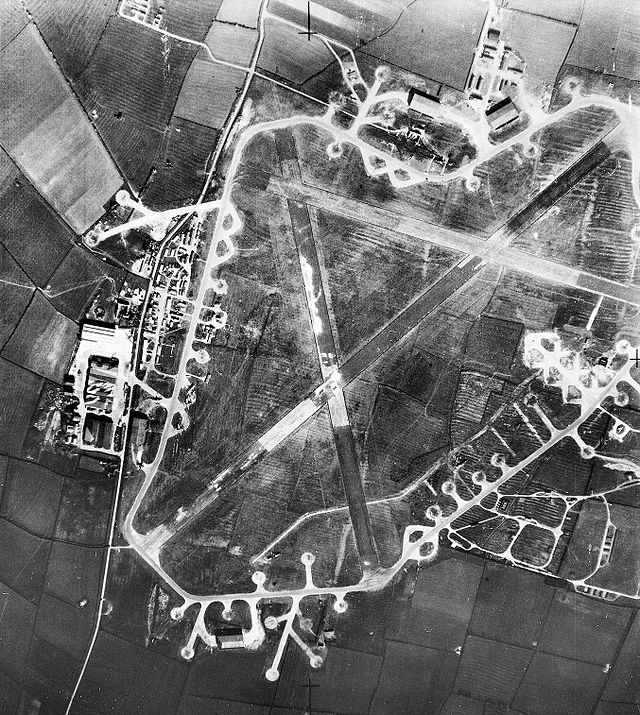 Italian campaign Italian campaignAllied offensive operations continue. On the right flank of the British 8th Army attacks, Argenta falls to forces of the British 5th Corps after an amphibious move across Lake Coamchio. North and east of Argenta there are no more rivers before the Po River and the British units are soon passing through what becomes known as the "Argenta Gap." West of Argenta, the British 13th Corps enters the line between British 5th Corps and the Polish 1st Corps which is moving northwest toward Bologna. US 5th Army attacks continue as well, though with slower progress because of the more difficult terrain south and west of Bologna. Photo: Churchill tanks being filmed by an AFPU cameraman during the advance of 56th Division north-east of Argenta, Italy, 17 April 1945 Photo: Infantrymen of Co. "I", 3rd Bn., 85th Regt., 10th Mtn. Div., march in a column of file up the road to the trucks which will take them to more forward positions. 17 April, 1945 Photo: Infantrymen of Co. "I", 3rd Bn., 85th Regt., 10th Mtn. Div., march in a column of file up the road to the trucks which will take them to more forward positions. 17 April, 1945 Photo: Infantrymen of Co. "I", 3rd Bn., 85th Regt., 10th Mtn. Div., entruck to move to more forward positions. 17 April, 1945 Photo: Infantrymen of Co. "I", 3rd Bn., 85th Regt., 10th Mtn. Div., entruck to move to more forward positions. 17 April, 1945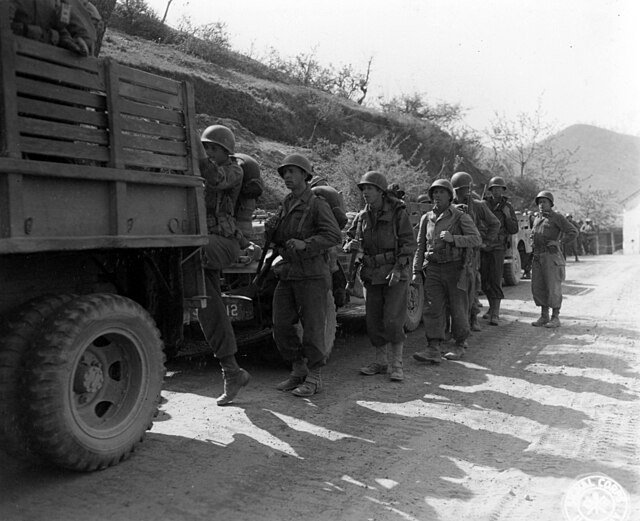 During the night of 16/17 April, Twelfth Air Force A-20s and A-26 Invaders hit Po River crossings and several towns west and southwest of Bologna; during the day B-25s successfully attack 4 Reno River bridges near Bologna and close support targets on the British Eighth Army front to the southwest, and extensively damage 4 bridges in northern Italy and Austria on the Brenner rail line; XXII Tactical Air Command fighters and fighter-bombers concentrate on close support of the US Fifth Army south and west of Bologna. The Fifteenth Air Force dispatches 751 B-24s and B-17s, in support of the US Fifth Army, to hit troop concentrations, supply dumps, gun positions, and HQ immediately south and southwest of Bologna; 143 P-51s provide escort. Battle of the Atlantic U.S. freighter Cyrus H. McCormack, while in convoy HX 348, is torpedoed and sunk by German submarine U-1107 70 miles southwest of Brest, France, 47°47'N, 06°26'W; British rescue ship Gothland picks up the survivors, but two Armed Guard sailors (of the 12-man detachment) are lost along with four of the 40-man merchant crew. U.S. freighter Swiftscout is torpedoed by German submarine U-548 about 145 miles northeast of Cape Henry, Virginia, 37°30'N, 72°45'W; Armed Guard gunfire drives the attacker down, but U-548 returns to torpedo the ship a second time, sinking her. Only one man is lost (none of the 10-man Armed Guard) and the survivors are rescued by steamship Chancellorsville. Pacific WarCHINA (Fourteenth Air Force): In China, 4 B-25s and 4 P-51s blast river shipping S of Yiyang; 6 B-25s bomb the area around Kwangsi University at Liang-feng; 2 B-24s bomb the Bakli Bay dock area on Hainan Island; 70+ P-51s and P-40s hit troops, town areas, road traffic, river shipping, and general targets of opportunity at several locations in S and E China including Changsha, Sinning, Sinhwa, Yiyang, Tungting Lake, Paoching, Yungfengshih, Shanhsien, Lingling, Pingsiang, Tsinkong, and Hochih. INDIA-BURMA (Tenth Air Force): In Burma, 18 fighter-bombers hit troops and supplies near Mong Kung and Wan Hpun; 12 others attack vehicles and other targets of opportunity along roads S of the bomb line; 489 transport sorties are completed to forward areas throughout the day. IWO JIMA (VII Fighter Command): 18 P-51s flying two strikes from Iwo Jima attack vessels in Futamiko in the Bonin Islands. SAIPAN (Twentieth Air Force): Missions 70 to 75: 118 B-29s bomb airfields at Tachiarai, Kokubu, Izumi, Nittagahara, and 2 at Kanoya; 5 others attack targets of opportunity; beginning on this date and continuing through 11 May, XXI Bomber Command devotes about 75 per cent of its combat effort to support of the Okinawa campaign; during this period the B-29s fly more than 2,100 sorties against 17 airfields on Kyushu and Shikoku Islands which are dispatching air attacks (including Kamikaze raids) against USN and USMC forces. SOUTHWEST PACIFIC AREA [Far East Air Force]: On Formosa, B-24s bomb Taichu, Shinshoshi, Toyohara, and Okayama Airfields and B-25s hit the airfield at Taito. The 69th and 311th Fighter Squadrons, 58th FG, move from Mangaldan to Porac with P-47s. PHILIPPINE CAMPAIGN (1945) In Operation Victor Five, the U.S. Army's X Corps consisting of the 24th and 31st Infantry Division is landed on Mindanao Island, Philippine Islands, near Malabang, Parang and Cotabato. The landings are supported by the cruisers and destroyers of Task Group 74.2 and USMC aircraft (30 F4Us and 35 SBDs). The defenders do not make a determined stand. VOLCANO AND RYUKYU ISLANDS CAMPAIGN Off Okinawa, light cruiser Mobile (CL-63) is damaged by on-board explosion, 26°13'N, 127°52'E; light minelayer Tolman (DM-28) is damaged by grounding, 26°16'N, 127°32'E; and tank landing ship LST-929 is damaged in collision with tank landing ship LST-267, 26°21'N, 127°43'20"E. Photo: A Japanese plane crashes near the stern of a U.S. Navy light aircraft carrier, during an unsuccessful kamikaze attack, 17 April 1945. As the photo was taken from the battleship USS South Dakota (BB-57) the carrier is most probably USS Bataan (CVL-29), as South Dakota and Bataan were assigned to Task Group 58.3 (and Bataan was the only CVL assigned to TG 58.3) Destroyers Heermann (DD-532), McCord (DD-534), Mertz (DD-691), and Collett (DD-730), assisted by destroyer Uhlmann (DD-687) and TBM (VT 47) from small carrier Bataan (CVL-29) sink Japanese submarine I 56 150 miles east of Okinawa, 26°42'N, 130°38'E. Numerous sweeps and sorties are flown in support of ground forces over Luzon, Cebu, Negros, and Mindanao Islands and the Sulu Archipelago. B-24s over Mindanao bomb Cotabato and Kabacan. UNITED STATES NAVY DEPARTMENT COMMUNIQUES, CINCPOA COMMUNIQUÉ NO. 335, APRIL 17, 1945 About two thirds of the area of le Shima was brought under the control of the Tenth Army on April 17 (East Longitude Date) as our attacking forces wheeled eastward to occupy a line running from the northeast corner of the airfield along the base of the island's central pinnacle and through the town of Iegusugu to the southern coast. Resistance was moderate throughout the day. Small pockets of the enemy continued to resist attacks of Marines of the Third Amphibious Corps on Motobu Peninsula and in northern Okinawa. In the south there was no change in the lines of the Twenty‑Fourth Army Corps. Our troops in both the northern and southern sectors were supported throughout the day by heavy Naval gunfire, carrier aircraft and Army and Marine artillery. A few enemy reconnaissance planes were in the Okinawa area during the day. Search aircraft of Fleet Air Wing One destroyed two small cargo ships at anchor near Tanega Island in the northern Ryukyus and demolished a warehouse on the island with a direct bomb hit on April 17. In waters east of the Ryukyus, Fleet Air Wing One planes sank three small cargo ships and damaged three others on the same date. United States forces attacking the home islands of Japan and the island groups of the Ryukyus since initiation of the Ryukyus campaign on March 18 to April 17, inclusive, have, destroyed more than 2200 Japanese aircraft in the air and on the ground. Aircraft from the fast carriers of the Pacific Fleet have destroyed more than 1600 of this total. In addition, units of the British Pacific Fleet operating in waters off the Sakishimas and Formosa have destroyed more than 80 enemy planes. Search aircraft of Fleet Air Wing Four made rocket and machine gun attacks on buildings on Tomari Cape on Paramushiru in the northern Kuriles and strafed a trawler off the island on April 16. Liberators of the Seventh Bomber Command bombed concrete structures and runways on Marcus Island on April 16. On the same date Marine Mitchells strafed ground installations at Kushira airfield on Kyushu. Army Mustangs of the Seventh Fighter Command strafed and bombed shipping in and around Chichi Jima in the Bonins on April 17. Corsairs and Hellcats of the Fourth Marine Aircraft Wing bombed and strafed targets in the Palaus on April 17. Planes of Fleet Air Wing One attacked installations on Yap and Puluwat in the Carolines on April 17. Fleet Air Wing Two planes continued neutralizing attacks on enemy‑held bases in the Marshalls on April 16. Mopping up operations on Iwo Island continued during the month of April as our forces developed that island as an air base. A total of 22,731 of the enemy were killed on Iwo from February 19 to April 14, inclusive, and 624 were captured. UNITED STATES NAVY DEPARTMENT COMMUNIQUES, CINCPOA PRESS RELEASE NO. 79, APRIL 17, 1945 On the morning of April 16 large numbers of enemy aircraft attacked one of our destroyers for more than two hours off the coast of Okinawa. The ship took two bomb hits and four suicide hits. But she shot down 6 dive bombers and proceeded to operate as ordered. PACIFIC Submarine Seahorse (SS-304) is damaged by depth charges in Tsushima Strait, 33°45'N, 128°26'E, and is forced to terminate her patrol. Submarine Sea Owl (SS-405) sinks Japanese submarine RO 46 500 yards off Wake Island 19°17'N, 166°35'E. Japanese transport Teizui Maru (ex-German Mosel) is sunk by mine near western entrance to Shimonoseki Strait, 34°04'N, 130°50'E.
|
|
lordroel
Administrator
Posts: 68,007 
Likes: 49,410
|
Post by lordroel on Apr 18, 2024 2:46:47 GMT
Day 2047 of World War II, April 18th 1945Eastern FrontBetween Stettin and Schwedt, the 2nd Belorussian Front opens its offensive against the 3rd Panzer Army. Except in a small area along the axis of advance of 1st Ukrainian Front, the Soviet forces engaged in the battle for Berlin have advanced less than 10 miles toward the city. However, the German defense is being worn down. In the East, the Soviet 1st Ukrainian Front captures Forst on the Neisse River; north of Frankfurt, the Soviet 1st Belorussian Front continues its attack to take the Seelow Heights, gradually wearing down the outnumbered German defenders. Western Front (1945) - Western Allied invasion of GermanyMap: HQ Twelfth Army Group situation map, April 18th 1945 The last German forces resisting in the Ruhr Pocket surrender. Field Marshal Model, commanding German Army Group B inside the pocket, commits suicide. About 325,000 German prisoners have been taken in this area by the Allied forces. The US 9th Army captures Magdeburg and the US Third Army captures Nürnberg and advances into Bohemia. Patton's US 3rd Army crosses the Czech frontier. Photo: First U.S. Army infantrymen of the 2nd Infantry Division rest along street in Leipzig, Germany, while 2nd Division tank destroyers await orders to move forward. 18 April, 1945 Photo: "G" Co., 272nd Regiment, 69th Infantry Division, 1st U.S. Army, moves forward in newly-captured Leipzig. 18 April, 1945 Photo: "G" Co., 272nd Regiment, 69th Infantry Division, 1st U.S. Army, moves forward in newly-captured Leipzig. 18 April, 1945 Photo: A Churchill tank of 6th Guards Tank Brigade supporting infantry in Uelzen, 18 April 1945 Photo: A Churchill tank of 6th Guards Tank Brigade supporting infantry in Uelzen, 18 April 1945 Photo: Surrendering German civilians pass a Churchill tank of 6th Guards Tank Brigade in Uelzen, 18 April 1945 Photo: Surrendering German civilians pass a Churchill tank of 6th Guards Tank Brigade in Uelzen, 18 April 1945 Photo: Tanks have gone forward to soften enemy positions in Nurnberg, Hitler's Nazi Party shrine which is under assault by elements of Lt. Gen. Alexander M. Patch's Seventh Army, 18 April, 1945 Photo: Tanks have gone forward to soften enemy positions in Nurnberg, Hitler's Nazi Party shrine which is under assault by elements of Lt. Gen. Alexander M. Patch's Seventh Army, 18 April, 1945 Photo: Seventh Army riflemen take cover from heavy machine gun fire behind shed at street corner in bitterly-defended Nurnberg, famous Nazi shrine and German industrial center, 18 April, 1945 Photo: Seventh Army riflemen take cover from heavy machine gun fire behind shed at street corner in bitterly-defended Nurnberg, famous Nazi shrine and German industrial center, 18 April, 1945 The U.S. Army 8th Division is assigned Military occupation of a sector of the Ruhr - Rhine area. This sector includes the Wuppertal, Dusseldorf, Wissen and Mulheim areas. Some officers from all units attached to the division are temporarily assigned to the Military Government section to help administer such a large area. The primary problem is that of Displaced Persons (DPs). Russian, Polish, Italian, French and other nationalities were used as slave labour in the Ruhr region. Freed DPs begin looting and pillaging both as a means of survival and revenge. Some acts of violence take place within the 8th Division area. DP camps are set up, and DPs fed and clothed (from German stores) which brings the situation under control Other than several cases of typhus reported in the town of Siegburg, no serious epidemics are reported. Map: Reduction of the Ruhr Pocket and advance to Elbe and Mulde rivers - 5-18 April 1945 Western Front (1945) - Liberation of the Netherlands Western Front (1945) - Liberation of the NetherlandsThe Wehrmacht's Army Group H is cut off when the Canadian 2nd Army reaches the Zuider Zee. Photo: The 3rd Canadian infantry brigade conquers the head of the Afsluitdijk, Kornwerderzand, April 18, 1945 Photo: Carriers of the 3rd Canadian Infantry Division at the head of the Afsluitdijk, April 18, 1945 Photo: Carriers of the 3rd Canadian Infantry Division at the head of the Afsluitdijk, April 18, 1945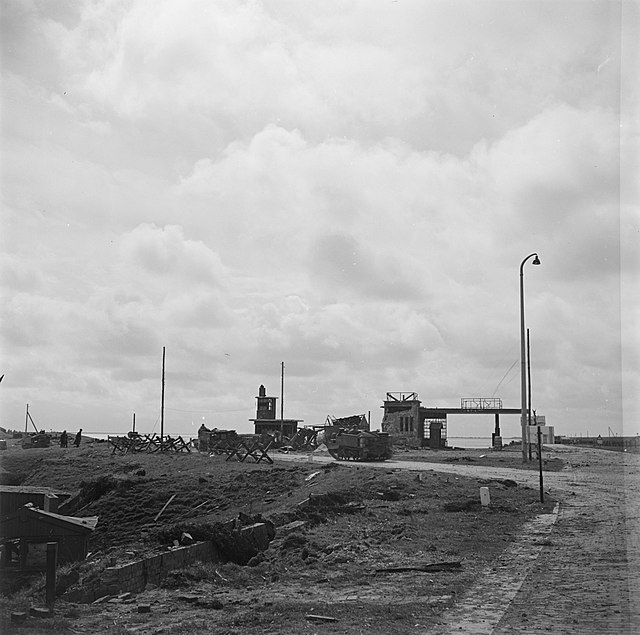 Photo: With the liberation of the Northern Netherlands, the Allied troops took control of the positions at the Afsluitdijk near Zurich (Friesland). They can now overlook the German positions. The enemy is still nesting on the Kornwerderzand strip. Canadian soldier standing by behind a fire machine gun at the head of the Afsluitdijk (towards Kornwerderzand), April 18, 1945 Photo: With the liberation of the Northern Netherlands, the Allied troops took control of the positions at the Afsluitdijk near Zurich (Friesland). They can now overlook the German positions. The enemy is still nesting on the Kornwerderzand strip. Canadian soldier standing by behind a fire machine gun at the head of the Afsluitdijk (towards Kornwerderzand), April 18, 1945 Photo: A British triple 20mm anti-aircraft gun position guards the Bailey Bridge at Arnhem, 18 April 1945 Photo: A British triple 20mm anti-aircraft gun position guards the Bailey Bridge at Arnhem, 18 April 1945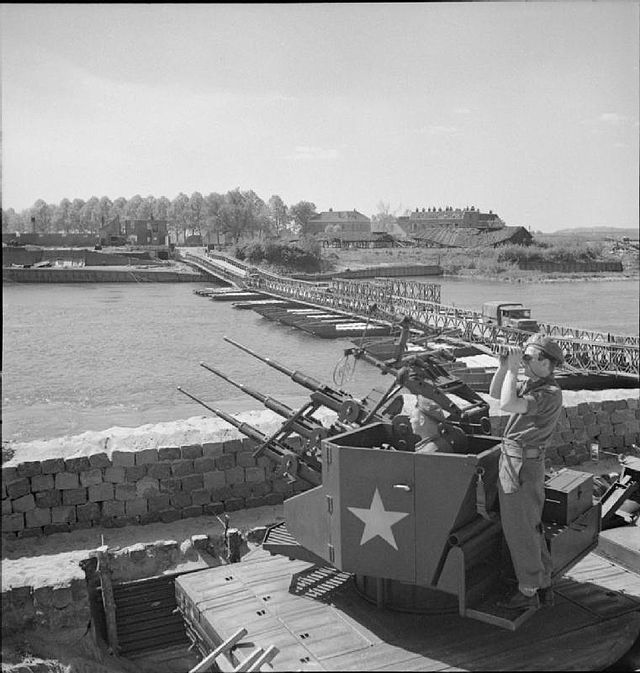 Air War over Europe Air War over Europe Heligoland: 969 RAF aircraft - 617 Lancasters, 332 Halifaxes, 20 Mosquitos - of all groups attacked the naval base at Heligoland, the airfield and the town on this small island. The bombing was accurate and the target areas were turned almost into crater-pitted moonscapes. 3 Halifaxes were lost. German marines who arrange a peaceful handover of the island to British forces are shot by the SS as mutineers. During Eighth Air Force Mission 959: 174 B-17s bomb the secondary target, the marshalling yard at Straubing without loss. 99 P-51s escort. 166 B-24s bomb the marshalling yard while 28 attack the rail bridge and rail industry at Passau without loss. Escorting are 240 P-47s and P-51s; they claim 12-0-8 aircraft on the ground; 1 P-51 is lost. 9 B-17s bomb the electrical transformers and 56 attack the marshalling yard at Traunstein while 148 hit the marshalling yard and electrical transformers at Rosenheim; 61 hit the secondary, the marshalling yard at Freising. 139 P-51s escort. About 590 Ninth Air Force B-26 Marauders, A-26 Invaders and A-20s attack oil storage at Neuburg an der Donau, marshalling yards at Juterbog and Nordlingen, and rail junctions at Falkenburg and Juterbog; fighters escort the bombers, fly patrols, sweeps, and armed reconnaissance, attack assigned targets, and support ground forces including the US V Corps assaulting Leipzig, the VII Corps in the Dessau-Halle areas, the 5th Armored Division near Steimke, and the 2d Armored Division at Magdeburg and other XIX Corps elements astride the Elbe River south of Barby; organized German resistance in the Ruhr pocket ceases. 57 RAF Mosquitos to Berlin and 36 to Schleissheim airfield near Munich, 35 RCM sorties, 33 Mosquito patrols. 1 Mosquito of No 141 Squadron was lost while carrying out a napalm attack on an airfield in Northern Germany; this was a new form of weapon being used by the Mosquito squadrons of No 100 Group. 114 RAF Lancasters and 9 Mosquitos of No 5 Group attacked the railway yards in the Czechoslovak town of Komotau (now known as Chomutov). This was the last major raid in the long communications offensive to which No 5 Group had made a particularly effective contribution. The raid was completely successful and all the aircraft involved returned safely. Italian campaign During the night of 17/18 April, Twelfth Air Force A-20s and A-26s pound communications in the southern Po Valley and the towns of Vignola, Bazzano, and Sassuolo in the US Fifth Army battle area; B-25s and B-26s hit 2 railroad fills and a bridge on the southern Brenner line and troop concentrations on the US Fifth and British Eighth Army fronts, southwest of Bologna and in the Dugnano Paderno area; fighter-bombers of the XXII Tactical Air Command also concentrate on support targets in the Fifth Army battle area. Photo: Humber light reconnaissance cars of 56th Recce Regiment in Argenta, 18 April 1945 Photo: Churchill tanks of 21st Army Tank Brigade cross the River Reno close to a destroyed railway bridge near Bastia Umbra, Italy, 18 April 1945 Photo: Churchill tanks of 21st Army Tank Brigade cross the River Reno close to a destroyed railway bridge near Bastia Umbra, Italy, 18 April 1945 473 Fifteenth Air Force B-24s and B-17s, with an escort of 89 P-51s, support the US Fifth Army offensive in the Bologna area, blasting defensive positions and communications in areas around the city; 78 P-38s dive-bomb a railroad bridge at Malborghetta Valbruna, while 87 others dive-bomb 2 railroad bridges at and southeast of Kolbnitz, Austria. Battle of the AtlanticU.S. freighter Cyrus H. McCormack, while in convoy HX 348, is torpedoed and sunk by German submarine U-1107 70 miles southwest of Brest, France, 47°47'N, 06°26'W; British rescue ship Gothland picks up the survivors, but two Armed Guard sailors (of the 12-man detachment) are lost along with four of the 40-man merchant crew. U.S. freighter Swiftscout is torpedoed by German submarine U-548 about 145 miles northeast of Cape Henry, Virginia, 37°30'N, 72°45'W; Armed Guard gunfire drives the attacker down, but U-548 returns to torpedo the ship a second time, sinking her. Only one man is lost (none of the 10-man Armed Guard) and the survivors are rescued by steamship Chancellorsville. GermanyBerlin: Goebbels burns his office files. The citizens of Berlin, like their Führer, are taking refuge from impending disaster underground. As the Allied armies close in on their city they leave their cellars and dugouts only to fetch vital supplies of food and water. But the basic essentials are running short in Berlin and people often queue for hours - in the dead of night before the Russian bombardment begins at 5am - just in the hope of a loaf of bread. They are also taking refuge from their own people - from the SS which is reportedly shooting people on the spot on the accusation that they are "defeatists", or rounding them up to join the Volkssturm in the last desperate defence of the Reich. Many are now waiting only to surrender. United StatesPhoto: The U.S. Navy landing craft repair ship USS Patroclus (ARL-19) underway in the harbour at Baltimore, Maryland (USA), on 18 April 1945 after completion of her conversion from an tank landing ship (LST) to a landing craft repair ship (ARL). She is painted in Camouflage Measure 31, Design 5L Pacific War Pacific WarCHINA (Fourteenth Air Force): In China, 3 B-25s hit trucks and other targets of opportunity E of Siangtan; 52 P-51s and P-40s attack river shipping, town areas, rail and road traffic, tanks, and bridges at several S and E China locations including Sinhwa, Hengyang, Changsha, Luchai, Paoching, Kweiyang, Yenkou, Sinning, and Siangtan. INDIA-BURMA (Tenth Air Force): In Burma, 21 P-38s attack troop concentration, tanks, artillery positions, and a bivouac area near Man Li and Kongsam; 5 P-61s hit a supply area W of Laihka; transports land or drop 806 tons of supplies at forward bases and frontline areas. IWO JIMA (VII Fighter Command): During the night of 18/19 Apr, 3 Iwo Jima based P-61s flying individual strikes, bomb and strafe Futamiko and the radio station on Chichi Jima. SAIPAN (Twentieth Air Force): Missions 76 to 81: 112 B-29s hit Japanese airfields at Tachiarai, Izumi, Kokubu, Nittagahara, and 2 at Kanoya, the same targets attacked yesterday; 13 other B-29s hit targets of opportunity; 2 B-29s are lost. SOUTHWEST PACIFIC AREA [Far East Air Force]: On Formosa B-25s bomb Karenko Airfield, B-24s bit Tainan, Giran, Toyohara, Hobi, and Soton Airfields, and P-38s on sweeps hit rail and road transportation. B-25s and P-38s hit Tarakan and Sandakan. HQ 58th FG and 310th Fighter Squadron move from Mangaldan to Porac with P-47s. VOLCANO AND RYUKYU ISLANDS CAMPAIGN Off Okinawa, light cruiser Mobile (CL-63) is damaged by on-board explosion, 26°13'N, 127°52'E; light minelayer Tolman (DM-28) is damaged by grounding, 26°16'N, 127°32'E; and tank landing ship LST-929 is damaged in collision with tank landing ship LST-267, 26°21'N, 127°43'20"E. Destroyers Heermann (DD-532), McCord (DD-534), Mertz (DD-691), and Collett (DD-730), assisted by destroyer Uhlmann (DD-687) and TBM (VT 47) from small carrier Bataan (CVL-29) sink Japanese submarine I 56 150 miles east of Okinawa, 26°42'N, 130°38'E. PHILIPPINE CAMPAIGN (1945) Fighter bombers and A-20s hit the Balete Pass area and support ground forces on Luzon, Negros, and Cebu. B-24s bomb Piso Point on Mindanao. UNITED STATES NAVY DEPARTMENT COMMUNIQUES, CINCPOA COMMUNIQUÉ NO. 336, APRIL 18, 1945 Tenth Army Troops in Ie Shima made substantial gains in the Northeastern area of the Island on April 18 (East Longitude Date). The enemy in the area of Iegusugu Peak gave stiff resistance from dug in positions and pillboxes. On the third day of the action, preliminary reports show that 388 of the enemy have been killed and one prisoner taken. In the same period our forces lost 15 killed and 73 wounded. Five are listed as missing. Elements of the Marine Third Amphibious Corps have reached the northern end of Okinawa Island. The Marines on Motobu Peninsula continued operations on April 18 against isolated groups of the enemy in that sector. There were no changes in the lines of the Twenty‑Fourth Army Corps In the Southern Sector of Okinawa. Naval guns and carrier aircraft continued to attack enemy strong points in the south. As of April 18, according to the most recent reports available, 989 officers and men of the U. S. Pacific Fleet had been killed in the Okinawa operation and associated attacks on Japan, 2,220 were wounded in action, and 1,491 were missing in action. At last report the soldiers and Marines of the Tenth Army had lost 478 officers and men killed, 2,457 had been wounded and 260 were missing. A Search Privateer of Fleet Air Wing One sank a small cargo ship north of the Ryukyus on April 18. Corsair and Hellcat fighters of the Fourth Marine Aircraft Wing attacked targets in the Palaus and destroyed buildings on Yap in the Western Carolines on April 18. Liberators of the Eleventh Army Air Force on April 17, bombed the Kataoka Naval Base on Shimushu in the Northern Kuriles. U. S. patrols on Saipan, Tinian and Guam in the Marianas killed 30 Japanese and took 88 prisoners of war during the week ending April 14. PACIFIC Submarine Seahorse (SS-304) is damaged by depth charges in Tsushima Strait, 33°45'N, 128°26'E, and is forced to terminate her patrol. Submarine Sea Owl (SS-405) sinks Japanese submarine RO 46 500 yards off Wake Island 19°17'N, 166°35'E. Japanese transport Teizui Maru (ex-German Mosel) is sunk by mine near western entrance to Shimonoseki Strait, 34°04'N, 130°50'E.
|
|
lordroel
Administrator
Posts: 68,007 
Likes: 49,410
|
Post by lordroel on Apr 19, 2024 2:56:55 GMT
Day 2048 of World War II, April 19th 1945Eastern Front In the east, Zhukov's army crashes through German defenses and swarms to within 20 miles (32 km) of Berlin's eastern suburbs. Konev's army threatens southern Berlin. Western Front (1945) - Western Allied invasion of GermanyMap: HQ Twelfth Army Group situation map, April 19th 1945 In the west, the U.S. First Army nears its final stop line in central Germany as it captures Leipzig and Halle. Eisenhower has ordered the First and Ninth Armies to halt along the Elbe and Mulde rivers and let the Red Army overrun areas that will be part of the postwar Soviet occupation zone. Leipzig is taken. The British 2nd Army reaches the Elbe River south of Namburg. Patton's US forces cross the Czech border. Final German surrenders in the Ruhr pocket total 325,000. British begin the attack on Bremen. Photo: Third U.S. Army tank moves past a burning building in Vorback, Germany. 19 April, 1945 Western Front (1945) - Liberation of the NetherlandsPhoto: Universal Carriers of 49th (West Riding) Division's Reconnaissance Regiment are welcomed by Dutch civilians on the outskirts of Kampen, 19 April 1945 Western Front (1945) - Liberation of the NetherlandsPhoto: Universal Carriers of 49th (West Riding) Division's Reconnaissance Regiment are welcomed by Dutch civilians on the outskirts of Kampen, 19 April 1945 Air War over Europe Air War over Europe The Eighth Air Force flies Mission 961: 605 B-17s and 584 P-51s are dispatched to make visual attacks on rail targets in southeastern Germany and northwestern Czechoslovakia; they claim 18-1-5 Luftwaffe aircraft; 5 B-17s and 2 P-51s are lost: 135 B-17s bomb the Elsterwerda marshalling yards while 143 bomb the Falkenberg marshalling yards. Escorting are 191 P-51s that claim 5-0-0 aircraft; 1 P-51 is lost. Of 321 B-17s dispatched, 115 hit the railroad industry and rail bridge at Pirna while 87 hit Karlsbad and 109 bomb the marshalling yard at Aussig; they claim 6-1-2 aircraft; 5 B-17s are lost. The escort is 197 P-51s; they claim 7-0-3 aircraft. Ninth Air Force bombers hit marshalling yards at Ulm, Neu Ulm, and Gunzburg (primary targets), the city of Donauworth and a target of opportunity at Schelklingen; weather prevents 70+ of the 450+ dispatched aircraft from bombing targets; fighters fly escort to the bombers, carry out patrols and armed reconnaissance, bomb a radio station, and cooperate with the US VII Corps in the Halle-Dessau area, the XII Corps attacking southeast from south of Bayreuth, the XX Corps in the Bamberg-Nurnberg area, preparing to drive toward Austria, and the XIX Corps along the Elbe River in the Magdeburg area. Fifteenth Air Force heavy bombers Bischofshofen and Rosenheim while 78 P-38s divebomb the marshalling yard at Weilheim. Fifteenth Air Force B-17s and B-24s bomb the Rattenberg railroad bridge and marshalling yards at Lienz, Klagenfurt and Linz. 49 RAF Lancasters of No 3 Group carried out a G-H raid on the Pasing railway yards, Munich. The bombing appeared to be concentrated. No aircraft lost. 36 RAF Lancasters of 9 and 617 Squadrons attacked coastal battery positions at Heligoland with Tallboy bombs. All targets were hit and no aircraft were lost. 79 RAF Mosquitos to Berlin, 35 to Wittstock airfield and 8 to Schleswig airfield, 34 RCM sorties, 40 Mosquito patrols. No aircraft lost. Italian campaign The US Fifth Army breaks out of the Apennines onto the Po plateau. Photo: Members of the 2nd Bn., 85th Mtn. Inf., 10th Mtn. Div., on the move through Badia. 19 April, 1945 Photo: Troops of the 2nd Bn., 86th Mtn. Inf., 10th Mtn. Div., move down dusty mountain road into the Po Valley. 19 April, 1945 Photo: Troops of the 2nd Bn., 86th Mtn. Inf., 10th Mtn. Div., move down dusty mountain road into the Po Valley. 19 April, 1945 Photo: Stretcher bearers pass Sherman tanks in Portomaggiore, 19 April 1945 Photo: Stretcher bearers pass Sherman tanks in Portomaggiore, 19 April 1945 During the night of 18/19 April, Twelfth Air Force A-20s and A-26 Invaders bomb roads, vehicles, and lights in the Bologna, Turin, Milan, and Mantua areas, and continuing to attack Po River crossings, hit 8 bridges; B-25s and B-26s bomb bridges in the Brenner Pass and support ground forces at several points including Budrio, Vignola, and San Martino in the Soverzano areas; fighter-bombers hit dumps, communications, and close support targets in the US Fifth Army battle areas south and west of Bologna. Fifteenth Air Force bombers attack the Avisio viaduct, the Vipiteno railroad bridge, AA batteries near Grisolera and Santo Stino di Livenza, and several minor targets of opportunity. Battle of the AtlanticDestroyer escorts Buckley (DE-51) and Reuben James (DE-153) sink German submarine U-879, North Atlantic, 42°19'N, 61°45'W. GermanyOn the eve of Hitler's 56th birthday, Dr. Goebbels exhorts the nation and predicts that in spite of all misfortunes Germany will yet prevail, that the "perverse coalition between Bolshevism and Plutocracy" is about to break up, and that it is Adolf Hitler ("Our Hitler!") who will still turn back the tide and save Europe, as he has thus far, from falling into the clutches of the Kremlin. United StatesPhoto: The U.S. Navy destroyer USS Selfridge (DD-357) in the Atlantic Ocean on 19 April 1945. Selfridge was transferred to the Atlantic in September 1944. Note the addition of the HF/DF on the short mast aft. She is painted in Camouflage Measure 32, Design 3D. This photo was taken from an aircraft of Photographic Squadron 15 (VJ-15)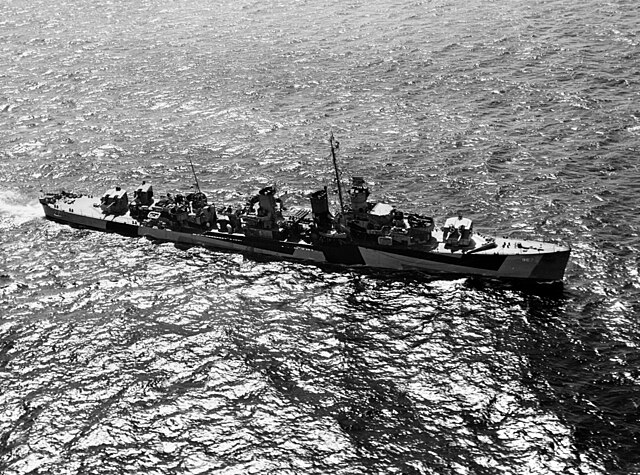 Photo: The U.S. Navy high-speed transport USS William M. Hobby (APD-95) underway off the Charleston Naval Shipyard, South Carolina (USA), on 19 April 1945. She is painted in Camouflage Measure 31, Design 5L Photo: The U.S. Navy high-speed transport USS William M. Hobby (APD-95) underway off the Charleston Naval Shipyard, South Carolina (USA), on 19 April 1945. She is painted in Camouflage Measure 31, Design 5L Pacific War Pacific WarCHINA (Fourteenth Air Force): In China, 12 B-24s bomb railway repair shops at Taiyuan; 3 others attack targets of opportunity in Bakli Bay on Hainan Island, 8 B-25s attack bridges and rail and road traffic N and NE of Anyang and NE of Taiku, damaging or destroying several locomotives and numerous boxcars; 100+ P-40s, P-51s, and P-47s attack town areas, troops, river, road, and rail traffic, and general targets of opportunity all over S and E China and hit a few targets of opportunity in N French Indochina. INDIA-BURMA (Tenth Air Force): In Burma, 14 P-38s hit supplies near Paklu, a fuel dump at Hainang, and bridges near Kunna; 1 bridge is knocked out; 6 other P-38s attack targets of opportunity along roads behind enemy lines; air supply operations continue as 800 tons of supplies are landed or dropped in forward areas. BURMA In the south, along the Irrawaddy River, Magwe is taken by British 20th Indian Division advancing southwest from Meiktila. In the Sittang Valley, Pyinmana falls to the British 5th Indian Division, which now leads the advance of British 4th Corps. Farther north between Meiktila and the Irrawaddy River, British 33rd Corps completes the clearance of the Mount Popo area and capture Chauk. GUAM Seventh Air Force: 17 B-24s from Guam hit Dublon, Fefan and Eten in Truk Atoll. 25 B-24s, based in the Palau islands, bomb nearby Arakabesan and Koror Islands. VII Fighter Command: 8 P-51s from Iwo Jima bomb and strafe Futamiko in the Bonin Islands. During the night of 19/20 Apr, 6 P-61s from Iwo Jima, operating singly and at intervals, bomb and strafe Chichi, Haha, and Muko Jima. Very Long Range Mission 4: 104 P-51s fly a fighter sweep to Atsugi and Yokusuka Airfields in Japan; they claim 23-0-7 aircraft in the air and 14-0-23 on the ground; 2 P-51s are lost. SOUTHWEST PACIFIC AREA B-24s bomb Tainan Airfield and Shinchiku town. Tarakan is hit by a light B-25 strike while B-24s returning from a French Indochina coastal sweep bomb Sandakan. B-25s, with P-51 cover, hit Haimi. ADMIRALTY ISLANDS Photo: U.S. Navy liberty section personnel returns from Rara Island (off Pitylieu Island, Manus, Admiralty Islands), aboard an LCM to the escort carrier USS Casablanca (CVE-55) on 19 April 1945 PHILIPPINE CAMPAIGN (1945) In the advance by US 1st Corps units, on the northwest coast of Luzon, Vigan is taken. Photo: Veteran Artillery men of the "C" Btry., 90th F.A., lay down a murderous barrage on troublesome Jap artillery positions in Balete Pass, Luzon, P.I. April 19, 1945 Photo: Veteran infantrymen of "K" Co., 3rd Bn., 161st RCT, 25th Div., cover a Jap cave with their rifles, should the Japs decide to come out because of the phosphorous grenade thrown into the cave, 19 April 1945 Photo: Veteran infantrymen of "K" Co., 3rd Bn., 161st RCT, 25th Div., cover a Jap cave with their rifles, should the Japs decide to come out because of the phosphorous grenade thrown into the cave, 19 April 1945 Unit moves on Luzon: HQ 3d Air Commando Group and the 3d Fighter Squadron (Commando) from Mangaldan to Laoag with P-51s; HQ 35th FG from Lingayen Airfield to Clark Field; HQ 312th BG from Mangaldan to Floridablanca; the 431st, 432d and 433d Fighter Squadrons, 475th FG, from Clark Field to Lingayen Airfield with P-38s. The 25th Liaison Squadron, 13 AF, moves from Dulag to Malabang with UC-78s and L-5s. Numerous missions are flown in support of ground forces on Luzon, Cebu, and Negros. On Mindanao, other B-24s bomb personnel areas at Kabacan, Cagayan, and along the Davao River. VOLCANO AND RYUKYU ISLANDS CAMPAIGN An enormous bombardment precedes attacks on the Shuri Line, but the 7th, 27th and 96th Infantry Divisions make small gains and suffer severe losses. The 1st and 6th Marine divisions complete occupation of north and central Okinawa. Photo: Machine gun crew of the 1st Bn., 381st Infantry, keep on the alert for enemy movement on Okinawa. 19 April, 1945 ALASKA (Eleventh Air Force): 8 B-25s off to bomb Kurile Island targets abort due to weather. UNITED STATES NAVY DEPARTMENT COMMUNIQUES, CINCPOA COMMUNIQUÉ NO. 337, APRIL 19, 1945 The Twenty‑Fourth Army Corps launched an offensive of substantial force against enemy defense lines in the southern sector of Okinawa on April 19 (East Longitude Date). In the early morning hours, powerful concentrations of Army and Marine artillery joined with battleships, cruisers, and lighter units of the Pacific Fleet to deliver one of the largest bombardments ever made in support of amphibious troops. Under cover of this fire and supported by great flights of carrier aircraft, Army Infantrymen of the Seventh, Twenty‑Seventh and Ninety‑Sixth Infantry Divisions moved off to the attack between 0600 and 0800. By noon the left and right flanks of our lines were reported to have moved forward from 500 to 800 yards and our forces captured the village of Machinato. The enemy was resisting our advance stubbornly with artillery, mortars, and light weapons. Our troops are now striking at a fortified line which is organized in great depth and developed to exploit the defensive value of the terrain which is dissected by ravines and terraced by escarpments. These fortifications whose northern perimeter follows an uneven line across the island at a point where it is about 8,000 yards wide are about four and a half miles north of Naha on the west coast and three and a half miles north of Yonabaru on the east coast. They include interlocking trench and pillbox systems, blockhouses, caves and the conventional Japanese dug‑in positions. During the forenoon, U. S. Army Infantrymen were engaged in knocking out strong points and penetrating and destroying segments of the outer lines. Tenth Army troops in Ie Shima continued to advance on April 19 moving their lines forward south of the Iegusugu Peak. The enemy continued to resist from concealed fixed positions. Some of our observation planes have landed on the island airstrip. Marines of the Third Amphibious Corps continued to extend their control over the northern areas of Okinawa. On Motobu Peninsula, mopping up operations were still in progress. Army Mustangs of the Seventh Fighter Command, Strategic Air Force, Pacific Ocean Areas, on April 19 attacked Atsugi airfield, in the area of Tokyo. Preliminary reports show that the following damage was inflicted on the enemy: Twenty‑one aircraft shot out of the air Two aircraft probably shot down Twenty‑six aircraft destroyed or probably destroyed on the ground Thirty‑five aircraft damaged in the air and on the ground A large cargo ship was seen sinking off the coast and a medium cargo ship was observed burning south of Tokyo. Our aircraft strafed the ground targets at low level through moderate to intense antiaircraft fire. A search plane of Fleet Air Wing One sank a small coastal cargo ship in the area of the northern Ryukyus on April 19. On the same date, Corsair and Hellcat fighters of the Fourth Marine Aircraft Wing attacked buildings and installations in the Palaus and Helldiver bombers of the same force struck the airstrip on Yap in the Western Carolines. PACIFIC Submarine Cero (SS-225) sinks Japanese guardboat No.3 Isuzu Maru south of Japan, 30°42'N, 136°42'E. Submarine Pogy (SS-266) is mistakenly attacked by PB4Y (VPB 102) as Pogy approaches a Japanese convoy southeast of Honshu, 32°59'E, 139°58'E. Fortunately, the submarine escapes the encounter undamaged and remains on patrol. Submarine Sennet (SS-408), attacking Japanese convoy in Kii Suido off the south coast of Kyushu, sinks auxiliary submarine chaser Cha 97, 33°32'N, 135°23'E, and merchant cargo ship Hagane Maru, 33°35'N, 135°23'E. Submarine Silversides (SS-236) sinks Japanese guardboat Kairyu Maru, 32°57'N, 145°03'E. Submarine Sunfish (SS-281) attacks Japanese convoy TSO-201 off Hokkaido, sinking gunboat Kaiho Maru, 42°22'N, 142°16'E, and merchant cargo ship Taisei Maru, 42°22'N,142°13'E. Submarine Trutta (SS-421) sinks Japanese merchant vessel Kaiyo Maru, 37°52'N, 122°24'E, and merchant fishing boats Kinshu Maru and Mitsuyama Maru, 37°52'N, 122°24'E. USAAF B-24s bomb Japanese shipping at Saigon, adding further damage to merchant cargo ships Kenei Maru and Chefoo Maru (previously damaged in TF 58's 12 January 1945 strike). Japanese tanker Shonan Maru sinks after running aground off Belawan, Sumatra, 03°55'N, 98°49'E.
|
|
lordroel
Administrator
Posts: 68,007 
Likes: 49,410
|
Post by lordroel on Apr 20, 2024 14:16:40 GMT
Day 2049 of World War II, April 20th 1945YouTube (300,000 Germans Surrender in the Ruhr)Eastern FrontIn northern Germany, forces of the Soviet 2nd Belorussian Front join in the advance from the Oder River line, on a 30-mile frontage southwest of Stettin. To the south, German resistance on the Oder and Neisse river lines has been eliminated. Troops of the 1st Belorussian Front capture Protzel and units of 1st Ukrainian Fronts cross over the Spree River. Western Front (1945) - Western Allied invasion of GermanyMap: HQ Twelfth Army Group situation map, April 20th 1945 In the Stuttgart area, the French 1st Army is advancing rapidly along the Neckar Valley, trapping German forces in the the Black Forest in Bavaria. Photo: A camouflaged Sherman Firefly of the Irish Guards and infantry guard a section of the Bremen-Hamburg autobahn, 20 April 1945 Photo: A Cromwell tank of 7th Armoured Division (the Desert Rats) on the Bremen-Hamburg autobahn, 20 April 1945 Photo: A Cromwell tank of 7th Armoured Division (the Desert Rats) on the Bremen-Hamburg autobahn, 20 April 1945 Photo: A Comet tank of the 2nd Fife and Forfar Yeomanry, 11th Armoured Division, and infantry of the 1st Herefordshire Regiment on the banks of the River Elbe at Hoopte near Winsen, 20 April 1945 Photo: A Comet tank of the 2nd Fife and Forfar Yeomanry, 11th Armoured Division, and infantry of the 1st Herefordshire Regiment on the banks of the River Elbe at Hoopte near Winsen, 20 April 1945 Photo: Cromwell artillery OP tank of 5th Regiment Royal Horse Artillery passing through the smouldering remains of Hollenstadt, 20 April 1945 Photo: Cromwell artillery OP tank of 5th Regiment Royal Horse Artillery passing through the smouldering remains of Hollenstadt, 20 April 1945 In Nuremberg, the American flag is raised over the rostrum of the Nuremberg Stadium - scene of Nazi Party rallies. Photo: Infantrymen of "G" Co., 7th Regiment, 3rd Infantry Division, 7th U.S. Army, take cover behind a wall as they move on to the Old City of Nuremburg, 20 April 1945 Air War over Europe Air War over Europe The Eighth Air Force flies Mission 962: 837 bombers and 890 fighters are dispatched to hit rail targets north-northwest to south-southwest of Berlin, Bavaria and Czechoslovakia; they claim 7-0-4 Luftwaffe aircraft; 1 B-17 is lost: 82 B-17s are sent to hit the rail industry at Nauen and 77 bomb the marshalling yards at Wustermark, 57 hit Neuruppin and 82 Oranienburg; 1 hits Neuruppin Airfield, a target of opportunity. Escorting are 258 P-51s; 1 is lost. Marshalling yards are the target of 289 B-17s as 137 bomb Brandenburg, 66 hit Seddin (66) and 82 attack Treuenbrietzen; 1 B-17 is lost. The escort is 227 P-51s. 56 B-24s hit a rail bridge and junction at Zwiesel, 53 hit a marshalling yard and rail junction at Muhldorf while 56 bomb the railroad and rail junction at Irrenlohe and 54 attack Klatovy; 1 hits the secondary target, the marshalling yard at Straubing. 228 P-47s and P-51s escort. 564 Ninth Air Force A-20s, A-26 Invaders and B-26s strike oil storage at Deggendorf and Annaburg, marshalling yards at Memmingen and Wittenberg, ordnance depots at Nordlingen and Straubing, and other targets including flak positions; fighters escort the bombers, fly patrols, sweeps, and armed reconnaissance, attack special targets, and cooperate with US ground forces including the VII Corps west of Dessau, the VIII Corps between Plauen and Chemnitz, the XII Corps in the Grafenwohr area, the XX Corps attacking toward the Danube River and Regensburg, and the XIX Corps in the Magdeburg-Barby area. 100 RAF Lancasters of No 3 Group bombed the fuel-storage depot at Regensburg accurately. 1 Lancaster lost. This was the last raid in the current campaign against German oil targets which had been waged since June 1944. Much of Bomber Command's effort during this period, sometimes at considerable loss, had been devoted to these oil operations, which had helped not only the Allied ground forces on the Western Front but also those fighting in Italy and on the Eastern Front. 76 RAF Mosquitos made 6 separate attacks on Berlin. This was the last RAF raid of the war on Berlin; the Russians were about to enter the city. Mosquito XVI ML929, of No 109 Squadron, claimed the last bombs - 4 500-pounders - at 02.14 British Time. The crew were Flying Officer AC Austin, pilot, and Flying Officer P Moorhead, navigator. All aircraft returned safely. 36 RAF Mosquitos to Schleissheim airfield, 3 RCM sorties, 2 Mosquito patrols. No aircraft lost. Italian campaign The US Fifth Army fights its way out of the Apennines and onto the Po River plain. Without Hitler's authorization, General Heinrich Von Vietinghoff orders his army to retreat across the Po. Photo: Sherman and Churchill tanks in the main square of Portomaggiore, 20 April 1945 Photo: T 5 John Pitts, Cleveland, Ohio, a motion picture cameraman with the Army Pictorial Service, photographs the first South African tank to cross the Reno River on its way to Bologna. 20 April, 1945 Photo: T 5 John Pitts, Cleveland, Ohio, a motion picture cameraman with the Army Pictorial Service, photographs the first South African tank to cross the Reno River on its way to Bologna. 20 April, 1945 Allied air forces commence Operation CORNCOB today. This is a three-day attack on the bridges over the rivers Adige and Brenta to cut off German lines of retreat on the peninsula. During the night of 19/29 April, Twelfth Air Force A-20s and A-26s on night intruder missions continue to pound Po River crossings and vehicle movement throughout the Valley; B-25s and B-26s considerably damage 4 of 6 railroad bridges and fills attached on the Brenner line, and also hit HQ in the battle area and 2 Reno River bridges north of Bologna. Fifteenth Air Force bombers again pound railway systems and road bridges in an effort to hinder the supply or withdrawal of enemy forces in northern Italy; 700+ B-24s and B-17s hit railroad bridges at Campodazzo, Ponte Gardena, and Campo di Trens, a viaduct at Avisio, marshalling yards at Vipiteno, Fortezza, and Brennero, and road bridges at Lusia, la Carrare, and Boara Pisani, and in Austria, the Mariahof viaduct and Innsbruck marshalling yard. 115 P-38s divebomb the Innsbruck, Austria-Rattenberg, Austria-Rosenheim, Germany railroad line, hitting marshalling yards at Hall, Schwaz, Jenbach, Kundl, and Worgl, Austria and Kiefersfelden, Germany, 4 rail bridges, and several box cars, and cut rail lines at 42 places between Innsbruck and Rosenheim. GermanyAt his 56th birthday party, Hitler is stooped and trembling, his uniform stained with food. The cheerless luncheon is attended by Göring and Himmler, who then flee the city, after giving the Führer their birthday congratulations. After an air-raid interruption by marauding RAF Mosquitos, Hitler, accompanied by one-armed Reich Youth Leader Artur Axmann, decorates a group of Hitler-Jugend with the Iron Cross for bravery against the Russians. The occasion is filmed by the propaganda cameras for the weekly 'Wochenschau', and will be the last photographic sequence taken of Hitler, his hands shaking and palsied by Parkinson's disease. After the ceremony, the Hitler-Jugend boys aged 10-16, are sent back into defence of the city where most will perish. United KingdomThe first production de Havilland Vampire F. 1 jet fighter (TG 274) makes its maiden flight at Samlesbury, Lancashire. Pacific WarCHINA (Fourteenth Air Force): In China, 7 B-25s hit the town of Neihsiang and attack railroad targets of opportunity from Saiping to Lohochai and from Linying, Burma to Hsuchang; 9 B-25s bomb Loyang and Luchou; 100+ P-51s, P-40s, and P-47s concentrate attacks against town areas throughout S and E China, also hitting troops, gun positions, river traffic, and other targets of opportunity. INDIA-BURMA (Tenth Air Force): 32 P-38s knock out 3 bridges and damage 5 others in C Burma behind the enemy lines; 12 P-47s hit a troop concentration and ration dump at Tonglau, 18 attack a troop concentration around a monastery at Kengkawmanhaung, and 12 attack troops along a stream near Wan Nahpeit; 497 transport sorties land or drop 784 tons of supplies in forward areas. Unit moves: 1st Troop Carrier Squadron, 443d Troop Carrier Group, from Sookerating, India to Warazup, Burma with C-47s; 20th Tactical Reconnaissance Squadron, 8th Photographic Reconnaissance Group, from Myitkyina, Burma to Nagaghuli with F-6s and P-40s (a flight is operating from Akyab, Burma); 164th Liaison Squadron (Commando), 1st Air Commando Group, from Asansol, India to Sinthe, Burma with UC-64s and L-5s. BURMA Photo: Men of the 2nd Dorset Regiment pass a knocked-out Lee tank as they make their way to the foot of Mount Popa, 20 April 1945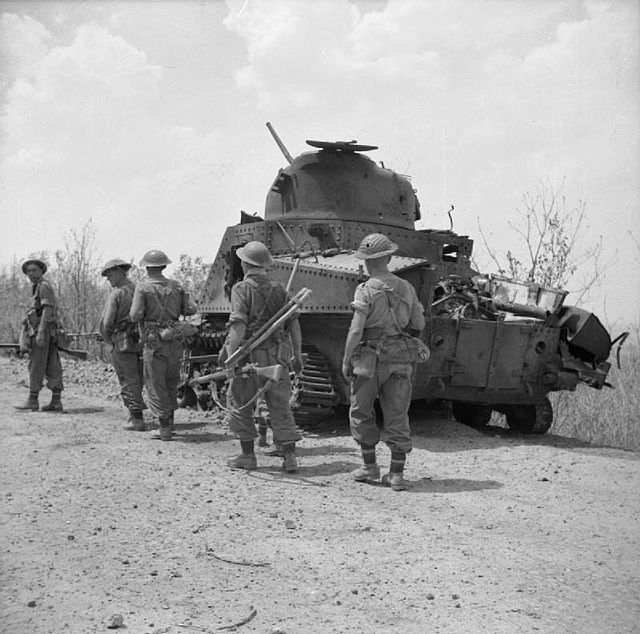 Photo: A Royal Engineers sapper using a detector to search for mines on the road to Mount Popa, as the Japanese begin to retreat, 20 April 1945 Photo: A Royal Engineers sapper using a detector to search for mines on the road to Mount Popa, as the Japanese begin to retreat, 20 April 1945 Photo: Infantry supported by Lee tanks approach Mount Popa as the Japanese begin to retreat, 20 April 1945 Photo: Infantry supported by Lee tanks approach Mount Popa as the Japanese begin to retreat, 20 April 1945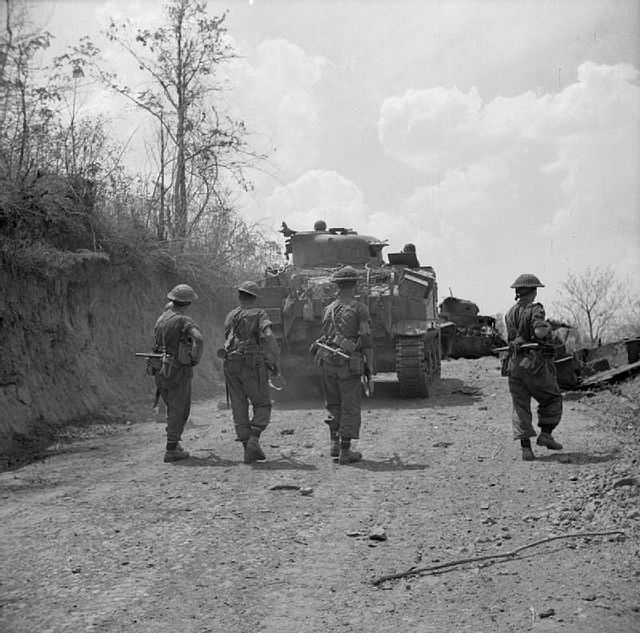 Photo: Infantry and a Lee tank wait while sappers clear mines on the road to Mount Popa, 20 April 1945 Photo: Infantry and a Lee tank wait while sappers clear mines on the road to Mount Popa, 20 April 1945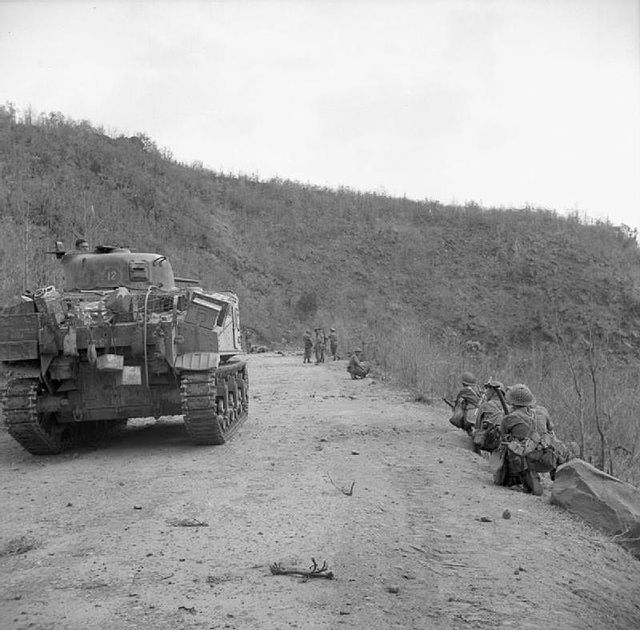 JAPANESE OCCUPIED NETHERLANDS EAST INDIES Submarine USS Guitarro lays mines in Berhala Strait off the northeast coast of Sumatra. Thirteenth Air Force B-24s bomb Sepinggang and Labuan Island Airfields on Borneo while USN PV Ventura attack various targets. P-38s and B-25s hit Tarakan Island. FORMOSA Fifth Air Force B-24s bomb Tainan Airfield while P-51s attack Koshun Airfield. JAPAN B-29 bombers destroy Musashi aircraft assembly plants stopping production of the Nakajima Hayate Ki84-Ia fighter planes. IWO JIMA (VII Fighter Command): 11 P-51s from Iwo Jima bomb Haha Jima. PHILIPPINE CAMPAIGN (1945) Army troops supported by naval vessels and USAAF aircraft land on Catanduanes Island, P.I. Large-scale FEAF support of ground forces on Luzon, Cebu, and Negros Islands continues. USMC F4Us and SBDs attack targets on Mindanao and SBDs attack Japanese infantry positions on Jolo Island's Mount Daho. Unit moves on Luzon: HQ 475th FG from Clark Field to Lingayen Airfield; 386th, 388th and 389th Bombardment Squadrons, 312th BG from Mangaldan to Floridablanca with A-20s. VOLCANO AND RYUKYU ISLANDS CAMPAIGN On Okinawa, US 3rd Amphibious Corps completes the capture of the Motobu Peninsula and the whole of the main northern part of the island. The US 24th Corps, on the Shuri Line, continue to attack but the limited gains made cannot be held against the Japanese counterattacks. Battleship Colorado (BB-45) is damaged by on-board explosion off Okinawa, 26°10'N, 127°20'E. UNITED STATES NAVY DEPARTMENT COMMUNIQUES, CINCPOA COMMUNIQUÉ NO. 338, APRIL 20, 1945 After a day of heavy attacks on the enemy's fortified positions in the Southern Okinawa Sector, the Twenty Fourth Army Corps had advanced about 1,000 yards generally by the morning of April 20 (East Longitude Date). The Seventh Infantry Division penetrated enemy defenses up to 1,400 yards in its zone of action near the east coast. Heavy Naval guns continued to bombard enemy strong points and Marine and Army artillery supported the advancing infantry with carrier aircraft delivering close support. Most of Yonabaru Town was destroyed. The enemy resisted our attacks bitterly in all sectors of the fighting in the south. On Ie Shima, Tenth Army troops continued to drive eastward against strong resistance from isolated enemy positions on April 20. Simultaneously, operations were began to destroy enemy forces holding Iegusugu Peak. At the end of April 18, 736 of the enemy had been killed on the island. Patrols of the Marine Third Amphibious Corps continued to cover the rugged country in Northern Okinawa on April 20 while operations against small groups of the enemy in Motobu Peninsula were continued. In the early morning hours of April 20 several small groups of enemy aircraft approached our forces in the Okinawa Area and retired without causing damage. The following is the complete list of ships sunk by enemy action in the Okinawa operation and the associated attacks on Japan from March 18 to April 18: Destroyers. Halligan Bush Colhoun Mannert L. Abele Pringle Minecraft. Emmons Skylark Destroyer Transport. Dickerson Gunboat. PGM 18 LST 477 (later removed from Communiqué). LCI 82 (complete designation LCI (G) 82) LCS 33 (complete designation LOS (L) (3) 30) LCT 876 (complete designation LCT (6) 876) Ammunition Ships: Hobbs Victory Logan Victory During the same period the following Japanese ships and aircraft were destroyed by our forces participating in the same operations: 2,569 Aircraft destroyed One Yamato class battleship Two light cruisers Five destroyers Five destroyer escorts Four large cargo ships One medium cargo ship 28 small cargo ships 54 small craft Numerous enemy torpedo boats, speed boats and other types of small craft. Liberators of the Seventh Army Air Force on April 19 bombed installations on Truk in the Carolines. On the following day, a search plane of Fleet Air Wing One sank a small sailing vessel in Truk Lagoon. Army bombers of the Seventh Air Force also struck Arakabesan and Koror in the Palaus scoring hits on antiaircraft emplacements on April 19. Corsair and Hellcat fighters of the Fourth Marine Aircraft Wing bombed miscellaneous targets in the Palaus and on Yap in the Western Carolines on the following day. PACIFIC Escort carrier Corregidor (CVE-58), while operating east of the Marianas on antisubmarine patrol in TG 12.3, is damaged in typhoon. Submarine Guitarro (SS-363) lays mines in Berhala Strait off northeast coast of Sumatra, N.E.I. Submarine chaser SC-737 is damaged by grounding, Sulu Sea, 09°45'N, 118°44'E. Mines laid by USAAF B-29s (20th Air Force) sink Japanese cargo vessels Yamamitsu Maru off Nojima, 34°32'N, 128°44'E, and Sanko Maru at 33°48'N, 131°00'E, and damage cargo ship Kitsurin Maru at western entrance of Shimonoseki Strait. USAAF P-38s and P-51s attack Japanese shipping off Rangoon, Burma, sinking motor torpedo boat Gyoraitei No.412.
|
|
lordroel
Administrator
Posts: 68,007 
Likes: 49,410
|
Post by lordroel on Apr 21, 2024 7:16:26 GMT
Day 2050 of World War II, April 21st 1945Eastern FrontLeading elements of the 1st Belorussian Front reach the eastern suburbs of Berlin. Meanwhile, the 1st Ukrainian Front attacks northward from Dresden and captures Bautzen and Cottbus 70 miles (113 km) southeast of Berlin while Soviet forces fighting south of Berlin, at Zossen, assault the headquarters of the German High Command. The only remaining opposing "force" to the Russian invasion of Berlin are the "battle groups" of Hitler Youth, teenagers with anti-tank guns, strategically placed in parks and suburban streets. In a battle at Eggersdorf, 70 of these Hitler teens strove to fight off a Russian assault with a mere three anti-tank guns. They were bulldozed by Russian tanks and infantry. Hitler announces he will remain in Berlin. Goering, Himmler and other top Nazis flee so they can surrender to the Americans or British. Fw 200B-2 DLH Condor "Hessen" crashes while trying to leave Berlin overloaded with Nazi party leaders trying to escape the encircled city. The town of Treuenbrietzen is occupied by the Russians. In East Prussia, remnants of AOK Ostpreussen (von Saucken) are still resisting in the port of Pillau, the Frische Nehrung and the Vistula delta between Danzig and Marienburg. Western Front (1945) - Western Allied invasion of GermanyMap: HQ Twelfth Army Group situation map, April 21st 1945 Now the Battle of the Ruhr has ended, with 325,000 prisoners in Allied hands; these include 30 generals and an admiral. Eisenhower, in an order of the day, says that "21 enemy divisions, including three Panzer, one Panzergrenadier and three Parachute divisions" have been smashed. Stuttgart is overrun by De Lattre de Tassigny's 1st French Army while there is continued German resistance around Elbingerode in the Harz Mountains. Air War over Europe The Eighth Air Force flies Mission 963: 532 bombers and 444 fighters are dispatched to attack jet fighter airfields and rail targets in south-eastern Germany; 2 bombers and 2 fighters are lost: 111 B-17s hit the marshalling yard at Munich, a target of last resort, with H2X radar. Escorting are 90 P-51s. 186 B-24s are sent to hit the Salzburg marshalling yard and rail bridge but abort the mission due to 10/10 cloud cover; 1 B-24 is lost. The escort is 99 P-51s. 6 B-17s hit the secondary target, the Amlech Airfield at Landsberg; 212 hit a target of last resort, the town of Ingolstadt; 1 B-17 is lost. 144 P-51s escort; 2 are lost. The lost B-24 was the last American bomber shot down over Germany during World War II. The 'Black Cat' was hit at 22,000 feet and broke into pieces. One of the crewmembers was Howard Goodner. Twenty-one year old Goodner had no parachute. He came down in freefall alongside bombs and oxygen tanks, spinning toward the Bavarian village of Scharmassing. He landed in a field outside the town, his body striking the earth so hard that it left a crater nearly six inches deep. Maria Wittig, then 19, saw him there. He was athletic looking, fair-skinned, handsome. Long fingers. "I can see him before me," she told an interviewer, a half century later, so clear was her memory. Shown a picture of the entire crew, she picked out Goodner immediately. "That's him," she said, her voice breaking. The Ninth Air Force dispatches 121 B-26 Marauders to hit the Attnang-Puchheim marshalling yard; fighters fly escort, patrols, armed reconnaissance and cooperate with the US VIII Corps as elements of the 6th Cavalry Group cross the Czechoslovakian border to reach Hranice and Trojmezi, the XII Corps in the Grafenwohr-Weiden area, and the XX Corps east of Nurnberg. Fifteenth Air Force bombers bomb the marshalling yard at Rosenheim while 138 P-38s bomb railroad lines and facilities in the Munich and Rosenheim, Germany-Rattenberg, Austria areas Weather curtails daytime operations but Twelfth Air Force B-25s score hits on the Matrei am Brenner bridge on the Brenner rail line. About 200 Fifteenth Air Force bombers, with P-51 escort, bomb marshalling yards at Attnang-Puchheim, Spittal an der Drau, and Vocklabruck. 107 RAF Mosquitos to Kiel. 2 aircraft lost. 16 RAF Mosquitos to Eggebek airfield near Flensburg, 3 RCM sorties, 16 Mosquito patrols, 20 Lancasters of No 6 Group minelaying in the Kattegat. No aircraft lost. Italian campaign Bologna is captured by the Polish II Corps. It was 5.50am when the last of the German garrison motored out of this university city. Bologna slept. Fifteen minutes later, advance units of the Polish II Corps drove in from the east and hoisted their national flag on the town hall, just a few minutes before American tanks rumbled in from the north, soon to be joined by Italian troops of the Eighth Army, their British steel helmets adorned with flowers and feathers. Only then did Bologna awake to go noisily, crazily, mad with joy and relief. A stiff street-by-street battle had been expected. The German commander had received the now almost rubber-stamped order to fight to the last man. Instead, it seems that he made a deal with the city's archbishop and the Fascist mayor. If partisans did not molest his retreating troops, he would not demolish Bologna's public services. As the Poles advanced along the Via Emilia, a coded signal had to be sent to the partisans to rise up. Anticipating this, the Germans arrested and shot two of their leaders. Today, as Bologna went wild, the partisans shot two leading Fascists in revenge. Units of US 2nd Corps (part of US 5th Army) enter the town a few hours later. Photo: Entry of Polish troops of the 2nd Polish Corps into Bologna. Soldiers of the Carpathian Uhlan Regiment in the T17 (Staghound) armored car welcomed by the population, 21 April 1945 Photo: Entry of Polish troops of the 2nd Polish Corps into Bologna. M4 Sherman tanks from the 1st Krechowiecki Uhlan Regiment leave the city, 21 April 1945 Photo: Entry of Polish troops of the 2nd Polish Corps into Bologna. M4 Sherman tanks from the 1st Krechowiecki Uhlan Regiment leave the city, 21 April 1945 Photo: Entry of Polish troops of the 2nd Polish Corps into Bologna. M4 Sherman tank from the 1st Krechowiecki Lancers Regiment on the city streets, 21 April 1945 Photo: Entry of Polish troops of the 2nd Polish Corps into Bologna. M4 Sherman tank from the 1st Krechowiecki Lancers Regiment on the city streets, 21 April 1945 Photo: American soldiers being greeted by civilians in Genoa, 21 April 1945 Photo: American soldiers being greeted by civilians in Genoa, 21 April 1945 US 5th Army forces have now cleared the Appenines and advancing rapidly on the Lombard Plain. East of Bologna, British 8th Army is advancing rapidly. Map: Map of US IV and II Corps breakthrough into the Po valley, April 1945 (this map shows operations in the Bologna region, 14–21 April 1945, but does not seem to show any operations of non-US troops in the region)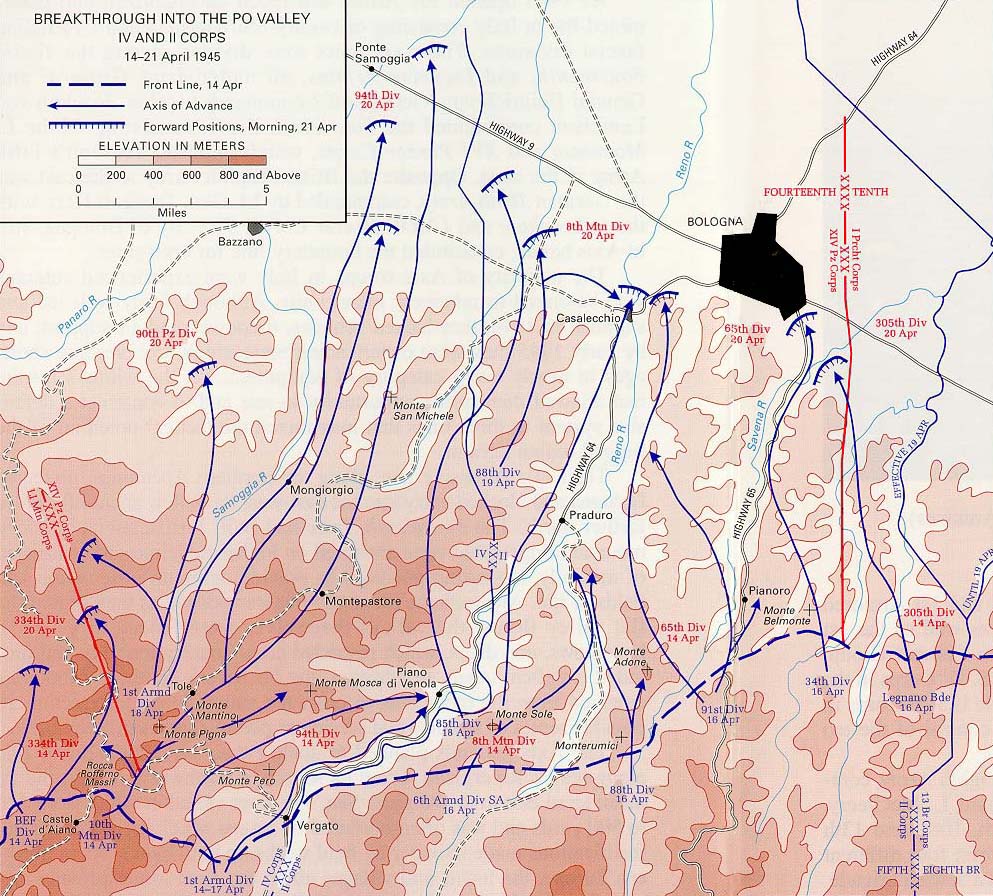 Photo: T 5 Clifford Thompson, 3 Terrace Ave., New London, Conn., of the 752nd Tank Bn., taking a few minutes out to sleep after having made the long, hard push to Bologna. 21 April, 1945 Photo: T 5 Clifford Thompson, 3 Terrace Ave., New London, Conn., of the 752nd Tank Bn., taking a few minutes out to sleep after having made the long, hard push to Bologna. 21 April, 1945 During the night of 20/21 April, Twelfth Air Force A-20s and A-26 Invaders bomb Po River crossings with good results and in the late afternoon hit Po River crossings; XXII Tactical Air Command fighters and fighter bombers, grounded most of the day, fly close support to the US Fifth Army which drives into Bologna (a longstanding objective) and begins to push rapidly across the plain toward the Po River. Arctic naval operationsIn the Arctic Sea, an Allied U-boat hunter group attacked 'U-997' with depth charges. Due to some damage to the periscope, the boat had to return to base. Battle of the Atlantic'U-636' sunk in the North Atlantic west of Ireland, in position 55.50N, 10.31W, by depth charges from frigates HMS 'Bazely', 'Drury' and 'Bentinck'. 42 dead (all hands lost). GermanyGöring takes his last trip by his personal train 'ASIEN'. From Karinhall he travels to Berchtesgaden to his lodge on the Obersalzberg. Himmler meets Norbert Masur of the World Jewish Congress and refuses to free the Jews under his control. Soviet UnionA mutual assistance treaty is concluded between the Soviet government and the Provisional Government of Poland, based on the Lublin Committee. The further recognition bestowed on the communist Poles, at a time when the London based Polish government in exile continues to receive western recognition, becomes an issue in postwar period. United StatesPhoto: The U.S. Navy escort carrier USS Vella Gulf (CVE-111) in Puget Sound, Washington (USA), on 21 April 1945 Pacific War Pacific WarCHINA (Fourteenth Air Force): In China, 5 B-25s bomb Loyang; a single B-24 hits targets of opportunity in Bakli Bay on Hainan; 30 P-51s and P-47s attack railroad and road targets, barracks area, buildings, and bridges at or near Paoching, Chihsien, Taiku, Hsihhsiassuchi, Shaho, Linfen, Luan, Yutze, and Shanhsien. INDIA-BURMA (Tenth Air Force): Bad weather over Burma causes canceling or aborting of all combat missions however, transports complete 464 sorties, landing or dropping 682 tons of supplies to forward areas. The 81st Bombardment Squadron (Medium), 12th BG (Medium), based at Fenny, India with B-25s, sends a detachment to operate from Meiktila, Burma. GUAM (Seventh Air Force): 18 Guam Island-based B-24s bomb Marcus Island in the N Pacific. (Twentieth Air Force): Missions 82 to 90: The XXI Bomber Command continues to hit airfields in Japan; 217 B-29s blast airfields at Oita, 2 at Kanoya, Usa, Kokubu, Kushira, Tachiarai, Izumi, and Nittagahara; 21 other B-29s hit targets of opportunity including the city of Kagoshima. JAPANESE OCCUPIED NETHERLANDS EAST INDIES On Borneo, Thirteenth Air Force B-24s bomb Miri, Kudat, Manggar, and Sepinggang Airfields and P-38s hit Tarakan Island and Sandakan, Miri Airfield, oil storage near Lutong, and, with B-24s, attack targets of opportunity along the southwest Celebes coast. USN PV Venturas also attack various targets on Borneo. BURMA The British 4th Corps advance in the Sittang Valley is beginning to pull ahead of the parallel efforts in the Irrawaddy Valley. Yedashe is taken by the British 5th Indian Division, while in the rear the airfields around Pyinmana are being cleared to be put into Allied service. In the Irrawaddy Valley, Yenangyaung falls to British 33rd Corps units mopping up in the rear of the main advance. PHILIPPINE CAMPAIGN (1945) The heavy fighting near Baguio is continuing, with the attacks of the US 37th Division making some gains near the Irisan River and the 33rd Division advancing to the west of the city. Photo: Infantrymen of the 17th Regt., 7th Div., keep down and and carefully probe the the ample vegetation for the enemy. Okinawa. 21 April, 1945 The Fifth and Thirteenth Air Force continue large scale support of ground forces on Luzon, Cebu, Negros, and Jolo Islands. USMC F4Us and SBDs attack highways and roads supporting the US X Corps on Mindanao. USMC SBDs also attack Japanese positions on Mount Daho on Jolo Island. The 39th Fighter Squadron, 35th FG, moves from Lingayen Airfield to Clark Field, Luzon with P-47s. VOLCANO AND RYUKYU ISLANDS CAMPAIGN The US 77th Infantry Division completes the occupation of Ie Shima. The island and its airfield have been secured after six days of heavy fighting during which about 5000 Japanese troops have been killed. The division is ferried to Okinawa to join in the battle in the south. Photo: Men of 27th Division, U.S. Tenth Army, cross ponton bridge on Okinawa to assault heavily fortified Jap position, 21 April 1945 Photo: This craggy Japanese stroingpoint, called Hill 178 by U.S. Tenth Army assaulting troops, is being reduced in an offensive to wipe out enemy resistance on the island. Infantrymen of the Army's 7th Division watch as a flame-throwing tank licks at cave defenders on the battered hillside on Okinawa. 21 April, 1945 Photo: This craggy Japanese stroingpoint, called Hill 178 by U.S. Tenth Army assaulting troops, is being reduced in an offensive to wipe out enemy resistance on the island. Infantrymen of the Army's 7th Division watch as a flame-throwing tank licks at cave defenders on the battered hillside on Okinawa. 21 April, 1945 Off Okinawa, the destroyer USS Ammen is damaged by bomb that misses. Organized Japanese resistance on Ie Shima ends. Nearly 5,000 Japanese have been killed, 149 captured. The Americans have suffered 1,000 casualties. UNITED STATES NAVY DEPARTMENT COMMUNIQUES, CINCPOA COMMUNIQUÉ NO. 339, APRIL 21, 1945 The Twenty‑Fourth Army Corps pressed its attack against the enemy in the southern sector of Okinawa on April 20 and 21 (East Longitude Dates) making small gains through heavily defended areas. On the approaches to Hill 178, the high ground changed hands several times on April 21 in the bitterest kind of fighting. Small gains were made by our forces in other segments of the lines. Naval guns and Army and Marine artillery continued to bombard enemy emplacements with heavy fire and carrier aircraft attacked troop concentrations in the southern part of the island. Marines of the Third Amphibious Corps reduced the remaining pockets of enemy resistance on Motobu Peninsula on the afternoon of April 20 and brought the entire area under their control. Tenth Army troops placed the United States Flag on the summit of Iegusugu Peak on Ie Shima on the morning of April 21 after overcoming bitter resistance from caves, pillboxes and other strong points. Our forces are engaged in mopping up operations on the island which is now in our possession. On the night of April 20‑21, enemy aircraft attacked Yontan and Kadena airfields causing minor damage. Carrier aircraft from the U. S. Pacific Fleet attacked air installations in the Sakishima group on April 19 and 21, shooting down one plane and strafing several others on the ground. Hellcat and Corsair fighters of Fourth Marine Aircraft Wing bombed targets in the Palaus on April 21. PACIFIC Japanese guardboat Zenyo Maru is sunk by U.S. aircraft off Shionomisaki, 31°30'N, 135°40'E. Japanese cargo vessel No.2 Toshi Maru is damaged by mine off Singapore.
|
|
lordroel
Administrator
Posts: 68,007 
Likes: 49,410
|
Post by lordroel on Apr 22, 2024 4:07:36 GMT
Day 2051 of World War II, April 22nd 1945Eastern Front Zhukov and Konev, having overcome the fanatical resistance of the defence zone before Berlin, are moving rapidly to put a ring of tanks round the capital. Zhukov's 47th Army and Konev's Fourth Guards Tank Army, are both west of the city, and only 25 miles separate them. Rokossovsky, after being held up crossing the Oder marshes, is preventing the 3rd Panzer Army from coming to Berlin's aid from the north. Units of the Soviet 1st Byelorussian Front have penetrated into the northern and eastern suburbs of Berlin. The attacking Soviet armies have now completely surrounded the city and are systematically decimating the motley ranks, consisting of various Wehrmacht and Waffen-SS units (including numbers of Dutch, Danish, Norwegian, Swedish, Latvian and French volunteers) as well as Volkssturm and Hitler Youth, of the exhausted and badly outmanned and outgunned defenders who are now under the command of General Weidling, CO of LVI. Panzerkorps. Map: Map of the Battle of Bautzen Photo: Soviet artillery outside Berlin, 22 April 1945 Photo: Soviet artillery outside Berlin, 22 April 1945 Western Front (1945) - Western Allied invasion of GermanyMap: HQ Twelfth Army Group situation map, April 22nd 1945 Western Front (1945) - Western Allied invasion of GermanyMap: HQ Twelfth Army Group situation map, April 22nd 1945 The final American offensive in Europe begins with Patton's Third Army and Patch's Seventh Army driving toward southern Germany and Austria. The Allies believe that some German troops, notably SS Storm troopers, may plan to retreat to the Alps for a deadly last stand in a "National Redoubt." Eisenhower wants to overrun the region before the diehard Nazis organize. Photo: Soldiers of the 55th Armored Infantry Battalion and tank of the 22nd Tank Battalion, move through smoke filled street. Wernberg, Germany, 22 April 1945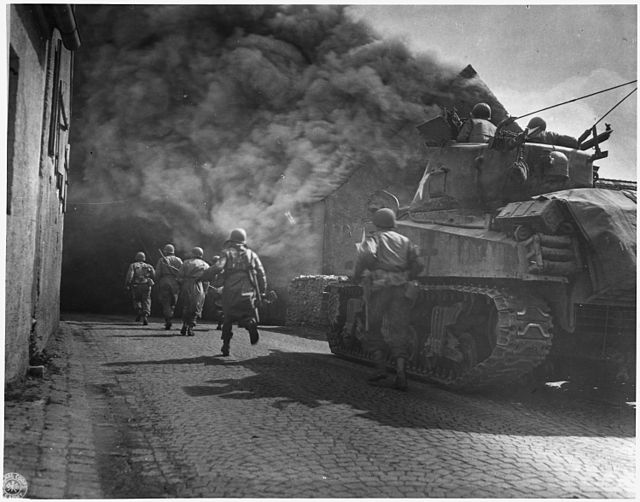 The US 7th Army crosses the Danube at Dillingen and Baldingen. Map: Advance on the Northern Front 23 March - 22 April 1945 The USAAF combines technical and post-hostilities intelligence objectives under the Exploitation Division with the code name Lusty. Operation Lusty begins with the aim of exploiting captured German scientific documents, research facilities and aircraft. The operation has two teams. One, under the leadership of Col. Harold E. Watson, a former Wright Field test pilot, collected enemy aircraft and weapons for further examination in the United States. The other team recruited scientists, collected documents and investigated facilities. Air War over Europe Bremen: 767 RAF aircraft - 651 Lancasters, 100 Halifaxes, 16 Mosquitos - of Nos 1, 3, 6 and 8 Groups. 2 Lancasters lost. This raid was part of the preparation for the attack by the British XXX Corps on Bremen. The bombing was on the south-eastern suburbs of the city, where the ground troops would attack 2 days later. The raid was hampered by cloud and by smoke and dust from bombing as the raid progressed. The Master Bomber ordered the raid to stop after 195 Lancasters had bombed. The whole of Nos 1 and 4 Groups returned home without attacking. 40 RAF Mosquitos to Bremen and 11 to Kiel, 56 RCM sorties, 39 Mosquito patrols. No aircraft lost. Italian campaignUnits of 2nd and 4th US Corps (parts of US 5th Army) reach the Penaro River in their advance to the Po River. On the left flank Modena is taken. General Heinrich von Vietinghoff, German commander in Italy, decides to surrender. His armies have lost most of their tanks and guns during a chaotic retreat across the Po. Photo: Men of the 2nd Lancashire Fusiliers are carried forward on Sherman tanks near Ferrara, 22 April 1945
 Photo: "Men of the 2nd Lancashire Fusiliers, supported by Achilles 17pdr tank destroyers, wait to go forward near Ferrara, 22 April 1945" Photo: "Men of the 2nd Lancashire Fusiliers, supported by Achilles 17pdr tank destroyers, wait to go forward near Ferrara, 22 April 1945" The entire night and day effort by the Twelfth Air Force is concentrated against German forces retreating north across the Po River in face of Allied forces which send advance elements racing to the south bank; B-25s fly 16 missions against ferries and pontoon bridge sites on the Po between Casalmaggiore and Polesella; XXII Tactical Air Command A-20s and A-26 Invaders, fighter-bombers, and fighters maintain night and day attacks on Po crossings and enemy movement; the command claims 900+ motor and horse-drawn vehicles destroyed. 258 Fifteenth Air Force P-51s and P-38s fly armed reconnaissance over northeastern Italy, bombing marshalling yards, bridges, railroads, highways, and several buildings and strafing an airfield, rail and road traffic, and numerous other targets of opportunity; other P-38s fly reconnaissance while P-51s escort reconnaissance and supply missions. (US Eighth Air Force): Mission 965: During the night of 22/23 Apr, 10 B-24s drop leaflets in France, the Netherlands and Germany. 4 of 12 B-24s fly CARPETBAGGER missions to Norway. The 27th Photographic Reconnaissance Squadron, 7th Photographic Group (Reconnaissance), moves from Prouvy Airfield, Denain, France to Chalgrove, England with F-5s. (US Ninth Air Force): Weather prevents combat operations by the 9th Bombardment Division and IX Tactical Air Command. The XIX Tactical Air Command flies armed reconnaissance over E Germany and W Czechoslovakia, flies area cover over the Wurzburg-Bayreuth areas, patrols the Third Army front (the Bayreuth-Nurnberg areas), and the XII Corps in the German-Czech border area near Weiden. Unit moves in Germany: HQ XIX Tactical Air Command from Luxembourg; operational HQ of the XXIX Tactical Air Command (Provisional) to Brunswick; HQ 84th and HQ 303d Fighter Wings from Haltern to Gutersloh; HQ 363d Tactical Reconnaissance Group from Gutersloh to Brunswick; HQ 474th Fighter Group and 428th, 429th and 430th Fighter Squadrons from Strassfeld to Langensalza with P-38s; 14th Liaison Squadron, XIX Tactical Air Command (attached to Twelfth Army Group) from Hersfeld to Erlangen with L-5s; 402d and 485th Fighter Squadrons, 370th Fighter Group, from Zwartberg, Belgium to Gutersloh with P-51s. Arctic naval operationsAt 0450, 'U-997' fired Gnats on two destroyers and claimed one destroyer sunk, but only end-of-run detonations were observed by the USSR 'Karl Libknecht' and patrol craft USSR BO-225. At 0508, the U-boat torpedoed and damaged the 'Idefjord' and eight minutes later sank the 'Onega'. 'Idefjord' was struck by one torpedo on the port side in the bow. One British gunner was lost and the crew abandoned ship in the lifeboats, but most of them returned after the Norwegian M/S-trawlers KNM 'Tromøy' and 'Karmøy' had investigated the damages. The ship was taken in tow stern-first, arriving in Murmansk at 0400 on 23 April for temporary repairs. Five crewmembers from the 'Onega' were lost. Patrol craft USSR BO-220 and BO-228 picked up 37 survivors. Battle of the Atlantic The German submarine 'U-518' is sunk in the North Atlantic northwest of the Azores, in position by depth charges from the US destroyer escorts USS 'Carter' (DE-112) and USS 'Neal A. Scott' (DE-769). All 56 men on the sub are lost. U.S. freighter Benjamin H. Bristow, en route to Southend, England with convoy ATM 123, is mined off Flushing, Holland 51°24'30"N, 03°22'E. There are no fatalities among the ship's complement (42 merchant sailors, the 26-man Armed Guard and a pilot), and the ship is towed to Terneuzen, Holland for repairs. GermanyHimmler meets Count Bernadotte of the Swedish Red Cross and gives him a message to pass to the western Allies, offering a German surrender to the British and Americans but not to the Soviets. The message is passed to the Allies on the 24th. During a three hour military conference in the bunker where his generals inform him that no German defence was offered to the Russian assault at Eberswalde, Hitler let loose a hysterical, shrieking denunciation of the Army and the 'universal treason, corruption, lies and failures' of all those who had deserted him. The end had come, Hitler exclaimed, his Reich was a failure and now there was nothing left for him to do but stay in Berlin and fight to the very end. His staff attempted without success to convince him to escape to the mountains around Berchtesgaden and direct remaining troops and thus prolong the Reich. But Hitler told them his decision was final. He even insisted a public announcement be made. Propaganda Minister Joseph Goebbels then brought his entire family, including six young children, to live with Hitler in the bunker. Hitler began sorting through his own papers and selected documents to be burned. Personnel in the bunker were given permission by Hitler to leave. Most did leave and headed south for the area around Berchtesgaden via a convoy of trucks and planes. Only a handful of Hitler's personal staff remained, including his top aide Martin Bormann, the Goebbels family, SS and military aides, two of Hitler's secretaries, and longtime mistress and companion Eva Braun. United States Soviet Foreign Minister V.M. Molotov arrives in Washington for talks with Secretary of State Edward R. Stettinius, Jr. Pacific WarCHINA (Fourteenth Air Force): In China, 2 B-24s bomb targets of opportunity at Canton and in Bakli Bay on Hainan; 5 B-25s bomb Hsuchang and hit the area to the NW; 19 P-51s and P-47s attack trains, trucks, troops, horses, and town areas at or near Linfen, Luan, Sincheng, Fentingtukou, Taiku, Chenghsien, Sinsiang, and Kaifeng. INDIA-BURMA (Tenth Air Force): In Burma, bad weather again cancels scheduled air strikes; 464 transport sorties fly 664 tons of supplies to forward areas. IWO JIMA (VII Fighter Command): 99 effective sorties are flown during fighter attack from Iwo Jima against Akenogahara and Suzuko Airfields in Japan; they claim 10 aircraft downed and 15 destroyed on the ground. (Twentieth Air Force): Missions 91 to 95: Strikes against airfields continue; 87 B-29s bomb airfields at Izumi, Kushira, Miyazaki, Tomitaka, and Kanoya and 6 others hit targets of opportunity; 1 B-29 is lost. SOUTHWEST PACIFIC AREA [Far East Air Force]: In Borneo, B-24s bomb Manggar and Jesselton airfields and P-38s hit Kuching. B-24s hit shipping and harbor installations at Saigon, French Indochina. BURMA General Hyotaro Kimura evacuates Rangoon and prepares to make a last stand against the British 14th Army near the Burmese-Thai border. Toungoo in the Sittang Valley falls to the British 5th Indian Division. PHILIPPINE CAMPAIGN (1945) The US 31st Infantry Division is landed at Moro Gulf. The US 24th Division is already advancing inland and has nearly reached Kabakan. Meanwhile, on Jolo, the last Japanese resistance comes to an end as their final strong-points fall to the US forces. Scattered individual Japanese soldiers remain at large. Photo: Infantry troops marching towards the Mindanao River in pursuit of Japs retreating near the Fort Pikit Ferry, Mindanao Island. 22 April, 1945
 VOLCANO AND RYUKYU ISLANDS CAMPAIGN Off Okinawa, support landing craft LCS-15 is sunk by aircraft, 27°20'N, 127°10'E; kamikazes sink minesweeper Swallow (AM-65), 26°10'N, 127°12'E, and damage destroyers Hudson (DD-475), 27°00'N, 127°00'E, and Wadsworth (DD-516), 26°10'N, 126°24'E; destroyer Isherwood (DD-520) and minesweeper Ransom (AM-283), 26°14'N, 127°28'E; and light minelayer Shea (DM-30), 26°00'N, 127°00'E; minesweeper Gladiator (AM-319) is damaged by strafing and near-miss of kamikaze, 26°21'N, 127°45'E. Photo: An infantryman of the 184th Regt. investigates the entrance to a small cave on Okinawa, typical of the terrain fought over to gain Rocky Crag, 22 April 1945 PACIFIC Submarine Cero (SS-225) sinks Japanese guardboat Aji Maru west of Tori Jima, 31°38'N, 139°00'E, and damages guardboat No.9 Takamiya Maru, 30°04'N, 136°43'E. Submarine Hardhead (SS-365) sinks Japanese cargo vessel Mankei Maru off Chimpon, 10°25'N, 99°06'E. Dutch submarine O 19 torpedoes Japanese heavy cruiser Ashigara as the latter proceeds in company with destroyer Kamikaze toward Batavia, 05°37'S, 106°55'E. Japanese guardboat Ariake Maru is sunk by U.S. aircraft in Ise Bay, 34°43'N, 136°43'E. USAAF P-51s sink Japanese auxiliary submarine chaser Chikuyu Maru south of Toshi Jima. Japanese Coast Defense Vessel No.81 is damaged by aircraft, 31°26'N, 123°30'E.
|
|
lordroel
Administrator
Posts: 68,007 
Likes: 49,410
|
Post by lordroel on Apr 23, 2024 2:47:12 GMT
Day 2052 of World War II, April 23rd 1945Eastern FrontThe Red Army has broken into Berlin from the north, east and south. Massed Russian artillery is shelling the central and western areas of the city. Buildings are collapsing piece by piece. Sturmovik aircraft dive over the rubble to silence German strongpoints. Latest reports say that Russian assault troops are smashing their way through the inner ring of SS resistance near the Stettiner railway station, one mile from the Unter den Linden. Frankfürt am der Oder: After 6 days of heavy defensive fighting, the defenders of the city, assisted by 11.SS-Armee Korps [Kleinheisterkamp], gave very little ground to Soviet 1st Byelorussian Front. Massive and continuous artillery bombardments on the town from 20 to 22 April, 1945, reduced vast parts of the city to a wasteland of burning rubble. Still, the defensive perimeter remained intact. Zhukov's 1st Byelorussian then sought to bypass and find a way around and behind the stubborn defenders. By 22 April the near breakup of 9th Armee into three isolated segments was dangerously close. Hitler, at the insistence of Gen.Heinrici, allowed 9th Army to remove itself from continued [suicidal] holding of the Oder line-position, which allowed the extrication of the beleaguered and nearly surrounded garrison of 'Festung-Frankfurt' aided by elements of 11.SS-Armee.Korps, at the very last moment. The Russians [actually a Polish Tank Brigade of the Red Army] took possession of the city on 23 April 1945. Detonations and fire in the city centre area went on for a number of days beyond this, and have been attributed to both unexploded Allied aerial ordnance [The RAF raided Frankfurt a.Oder in late March and early April 1945], as well as to last ditch Hitler-Jugend attacks by the so-called 'Werwolf' organisation. Western Front (1945) - Western Allied invasion of GermanyMap: HQ Twelfth Army Group situation map, April 23rd 1945 British Second Army reaches the Elbe River near Hamburg, Germany. A group of non-Jewish Flossenbürg Concentration Camp prisoners arrived at Dachau Concentration Camp in Germany after a six-day march. On the same day, elements of the 2nd US Cavalry Group, 90th and 97th US Infantry Divisions liberated the main camp of Flossenbürg, finding 1,527 prisoners still in the camp; about 300 of them would die despite receiving care from US Army medics. Meanwhile, several groups of prisoners who were marched out of Flossenbürg in the preceding days were found and liberated by US Army troops in the surrounding area. Photo: Flossenbürg concentration camp liberated by the US Army, 23 April 1945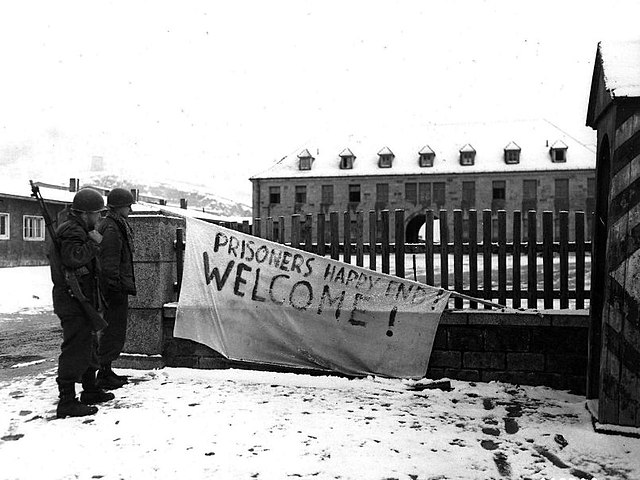 Air War over Europe Air War over EuropeFirst Tactical Air Force (Provisional): HQ 71st Fighter Wing moves from Vittel, France to Heidelberg, Germany. Ninth Air Force: Weather cancels combat operations by the 9th Bombardment Division. In Germany, fighters patrol the Magdeburg area and the US Third Army front (E of the Bayreuth-Nurnberg area), fly armed reconnaissance over E Germany and W Czechoslovakia, and operate in conjunction with the XII Corps as it presses forward N of Regensburg between the Danube River and Czech Border. P-47 unit moves in Germany: 411th and 412th Fighter Squadrons, 373d Fighter Group, from Venlo, the Netherlands to Lippstadt; 509th, 510th and 511th Fighter Squadrons, 405th Fighter Group, from Ophoven, Belgium to Kitzingen. 148 RAF Lancasters of No 5 Group set out to attack the railway yards and port area at Flensburg but the operation was abandoned because of cloud which covered the target on the bomb run. All aircraft returned safely. 60 RAF Mosquitos dispatached to Kiel; none lost. 38 RAF Mosquitos to Rendsburg, 32 to Travemünde and 8 to Schleissheim airfield, 45 RCM sorties, 35 Mosquito patrols. No aircraft lost. Italian campaign Advance units of both US 5th and British 8th Armies reach the Po River. US 5th Army units manage to cross the river south of Mantua. Photo: A Churchill tank halts near infantry of the 1st London Irish Rifles near Tanara during the advance to the River Po, Italy, 23 April 1945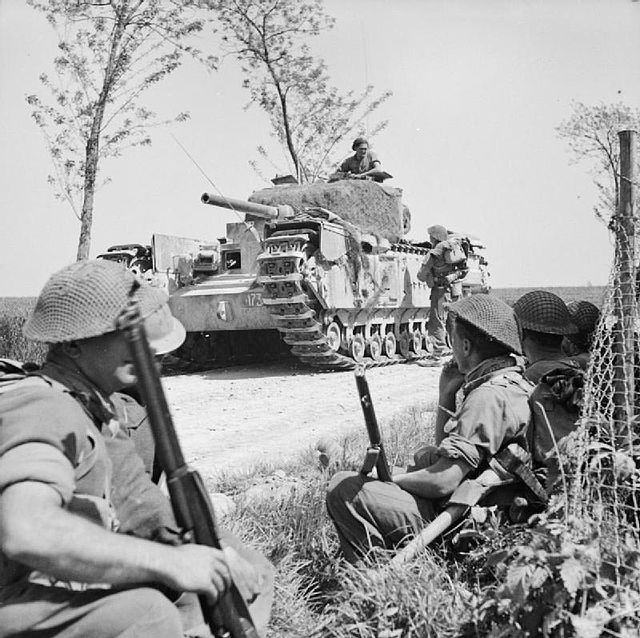 Photo: Three members of HQ, 2nd Bn., 85th Regt., 10th Mtn. Div., arrived at the Po River bank for reconnaissance, 23 April 1945 Photo: Three members of HQ, 2nd Bn., 85th Regt., 10th Mtn. Div., arrived at the Po River bank for reconnaissance, 23 April 1945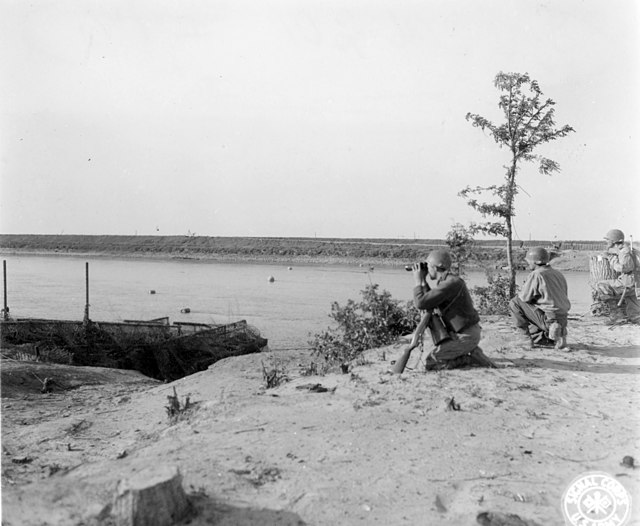 Battle of the Atlantic Battle of the Atlantic At 1535, 'U-1023' fired a spread of two LUT torpedoes at Convoy TBC-135 and heard one detonation and sinking noises. In fact, the 'Riverton' was only damaged. The unescorted 'Katy' was torpedoed and damaged by 'U-857' east of Kitty Hawk. She was towed to Lynnhaven, Hampton Roads on 26 April and repaired. It is also possible that 'U-879' torpedoed this ship, but both U-boats were lost during April 1945 in that area and this success can not be definitely assigned to one of the boats. 'U-396' reported missing from weather-reporting duties. No explanation exists for its loss. 45 dead (all hands lost). 'U-1055' reported missing in the North Atlantic or the English Channel. No explanation exists for its loss. 49 dead (all hands lost). Minesweeper HMCS 'Vegreville' damaged by mines off French coast and headed for Devonport for repairs. The damage to her port engine was considered to be beyond economical repair and was declared a constructive total loss 6 Jun 45. 'U-716' depth charged in the Arctic by a hunter-killer group. Due to the damage incurred the boat had to return to base. GermanyIn Berlin, Germany, Adolf Hitler noted that, when Germany would have lost the war, Reichsmarschall Hermann Göring would be the better person to negotiate peace terms. Göring, who was in Berchtesgaden in southern Germany, was made aware of this fact. After consulting Hans Lammers and other senior government officials, Göring carefully noted that, according to Hitler's decree of 29 Jun 1941, Göring would take power over Germany if Hitler could not respond by midnight. This message would be distorted by Martin Bormann as a sign of Göring's thirst for power. Hitler originally ordered Göring to surrender all of his positions, but Bormann would convince Hitler to issue an arrest order. After sundown, Albert Speer bid his final farewell to Adolf Hitler. He admitted to Hitler that he had sabotaged Hitler's scorched earth policies, and Hitler forgave him for disobeying the order. Speer toured the Chancellery in Berlin, Germany for the last time before leaving for Hamburg, Germany. Reichsjugendführer Artur Axmann gives a personal order that battalions of Hitler Youth be raised to defend the Pichelsdorf bridges across the River Havel in Berlin to keep the way open for Wenck's phantom army. Folke Bernadotte met Heinrich Himmler at the SS Hohenlychen sanatorium in Lychen, Germany for the last time. During this meeting, Bernadotte secured the release of some Scandinavian Jews, but refused to help seek a separate peace between Germany and the Western Allies. German occupied Netherlands George Marshall authorized Dwight Eisenhower to negotiate with the Germans in the Netherlands for a limited ceasefire in order to bring relief to the starving civilians. United StatesPhoto: The U.S. Navy light cruiser USS Dayton (CL-105) underway in the Delaware River, near the Philadelphia Naval Shipyard, Pennsylvania (USA), 23 April 1945 Photo: Amidships view of the Fletcher-class destroyer USS David W. Taylor (DD-551) at Hunters Point Naval Shipyard, California (USA), on 23 April 1945 Photo: Amidships view of the Fletcher-class destroyer USS David W. Taylor (DD-551) at Hunters Point Naval Shipyard, California (USA), on 23 April 1945 Photo: The U.S. Navy attack cargo ship USS Montague (AKA-98) underway off New York City (USA) on 23 April 1945 Photo: The U.S. Navy attack cargo ship USS Montague (AKA-98) underway off New York City (USA) on 23 April 1945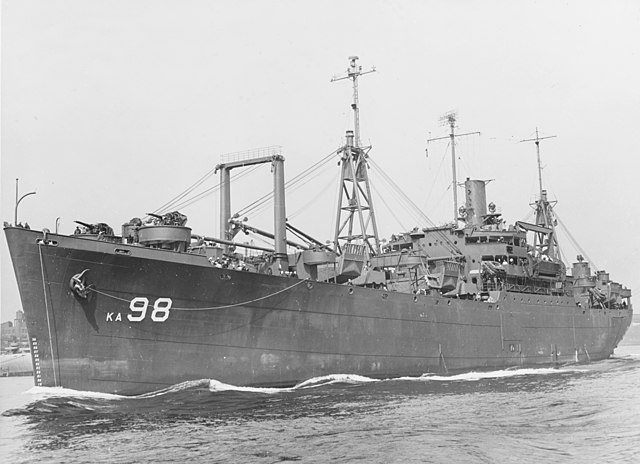 Pacific War Pacific WarCHINA (Fourteenth Air Force): In China, 5 B-25s blast the Hsuchang railroad yards, completely demolishing a locomotive repair shop; 2 B-24s attack targets of opportunity in the S China Sea; 39 P-47s and P-51s attack troops, horses, trains, and rivercraft at or near Nanyang, Burma and Taiku, Shanhsien, Hsihhsiassuchi, Loning, Sinyang, Chenghsien, Sichuan, Lushan, and along the Pinghan railroad, and render a railroad tunnel near Sinyang unusable. INDIA-BURMA (Tenth Air Force): In Burma, 7 P-61s attack with napalm, rockets, and cannon several targets during sweeps from Laihka to Loilem to Hopong to Wan Yin; Laihka Airfields, a bridge S of Wan Yin, trucks, and other targets are successfully pounded; 40+ fighter-bombers attack troop concentrations along and behind the lines at several points including Loilem, Nawng Leng, Mong Pawn, and Naungtaw; a bridge at Namhkok is temporarily out due to bomb damage to approaches; 570 transport sorties are flown to forward areas throughout the day. BURMA The 150 officers and 3,000 men of the 1st Division of the Indian National Army, an anti-British resistance group aided by the Japanese, surrendered to the Allies at Pyu, Burma. Meanwhile, Lieutenant General Heitaro Kimura, despite having been given orders of defend Rangoon, Burma to the death, ignominiously abandoned the city without issuing any orders to the Burma Area army. GUAM (Seventh Air Force): 13 B-24s from Guam Island pound positions on Marcus Island. The 28th Photographic Reconnaissance Squadron, Seventh AF, based on Kualoa Airfield with F-5Es, sends a detachment to operate from Okinawa, the first Seventh AF unit to arrive (another detachment is operating from Saipan Island). JAPANESE OCCUPIED NETHERLANDS EAST INDIES The US Navy's Patrol Bombing Squadron One Hundred Nine (VPB-109) based at Puerto Princessa, Palawan, Philippine Islands, launches the Special Weapons Ordnance Device (SWOD) Mk. 9 for the first time against an enemy target. The SWOD Mk. 9, or "Bat" missile, is a glide bomb consisting of a 1,000 pound (453.6 kg) bomb casing equipped with wings, twin tail and internal radar to guide it. Two Bats are launched by a VPB-109 Consolidated PB4Y-2 Privateer against Japanese shipping in Balikpapan harbor in Borneo but both are defective and do not hit any targets. In Borneo, other B-24s bomb airfields at Sepinggang and Jesselton and P-38s drop napalm on Tarakan. Other B-24s fly a shipping sweep over the Makassar Strait and damage several small vessels. SOUTHWEST PACIFIC AREA [Far East Air Force]: On Formosa, B-25s hit the Shinei railroad yards, P-51s hit Karenko Airfield and P-38s attack various targets of opportunity. In China, B-24s bomb a military depot at Shanghai and shipping in Yulin harbor on Hainan. B-24s bomb the naval base at Saigon, French Indochina. PHILIPPINE CAMPAIGN (1945) Units of the US 37th Division reach the outskirts of Baguio, Luzon, PI. Fighter bombers continue to support ground forces in the N and S parts of Luzon Island pounding numerous artillery positions, supply areas, and general targets of opportunity. VOLCANO AND RYUKYU ISLANDS CAMPAIGN On Okinawa, the attacks of US 24th Corps begin to achieve some gains, notably by US 96th Division. UNITED STATES NAVY DEPARTMENT COMMUNIQUES, CINCPOA COMMUNIQUÉ NO. 341, APRIL 23, 1945 Naval guns and carrier aircraft continued to support troops of the Twenty-Fourth Army Corps attacking the enemy's fortified line in the southern sector of Okinawa on April 23 (East Longitude Date). Planes from carriers of the U. S. Pacific Fleet attacked 25 enemy aircraft about to take off from an airfield on Miyako in the Sakishima group on the evening of April 22 destroying 15 on the ground and shot down five more in the air. Four planes were shot down over Ishigaki in the same group. On April 23, three aircraft were destroyed on the ground at Kume Island in the Okinawa group by our fighters and a single enemy plane was shot down north of Okinawa by a Marine plane. No further information is available on the progress of the fighting in southern Okinawa. Carrier aircraft of the British Pacific Fleet bombed and strafed air Installations in the Sakishima group on April 16 and 17. Four enemy planes were shot down and one was destroyed on the ground. Fighters of the Fourth Marine Aircraft Wing bombed targets in the Palaus on April 23. On April 22, Marine Corsairs continued neutralizing raids on enemy bases in the Marshalls. PACIFIC Submarine Besugo (SS-321) sinks German submarine U-183 in Java Sea, 04°57'S, 112°52'E. PB4Ys (VPB 109) employ "Bat" missiles against Japanese shipping off Balikpapan, Borneo, in the first combat use of the only automatic homing missile to be used in World War II. Japanese merchant cargo ship Tamae Maru is sunk by accidental ammunition explosion in Sakai harbor.
|
|
lordroel
Administrator
Posts: 68,007 
Likes: 49,410
|
Post by lordroel on Apr 24, 2024 2:47:46 GMT
Day 2053 of World War II, April 24th 1945Eastern FrontIn the battle for Berlin, Soviet troops of the 1st Ukrainian Front (Konev) penetrate into the suburbs of Berlin from the south while the forces of the 1st Belorussian Front (Zhukov) continue attacking into the city from the east. Other Soviet units of the two fronts are moving around the city to the north and south to complete the encirclement of the city. Large parts of the German 9th Army and 4th Panzer Army, both part of German Army Group Vistula (Heinrici) are cut off to the east of Berlin as a result of the northwest advance of the Soviet 1st Ukrainian Front. The RAF joined in the final battle of Berlin with fighter-bombers of Bomber Command pouncing on General Wenck's Twelfth Army as it moves east after being switched from the western front to Berlin. The pilots report that the entire eastern half of the city is on fire. On the ground Konev's men are crossing the heavily-defended Tetlow canal on bridges built by assault sappers under fire. Western Front (1945) - Western Allied invasion of GermanyMap: HQ Twelfth Army Group situation map, April 24th 1945 The British 2nd Army launches attacks near Bremen. Dessau on the Elbe River is taken by US 1st Army. To the south, on the Danube River, Ulm is captured and in the Black Forest area the French 1st Army continues its advance. Photo: A 5.5-inch field gun of 64th Medium Regiment, Royal Artillery, firing on Bremen, 24 April 1945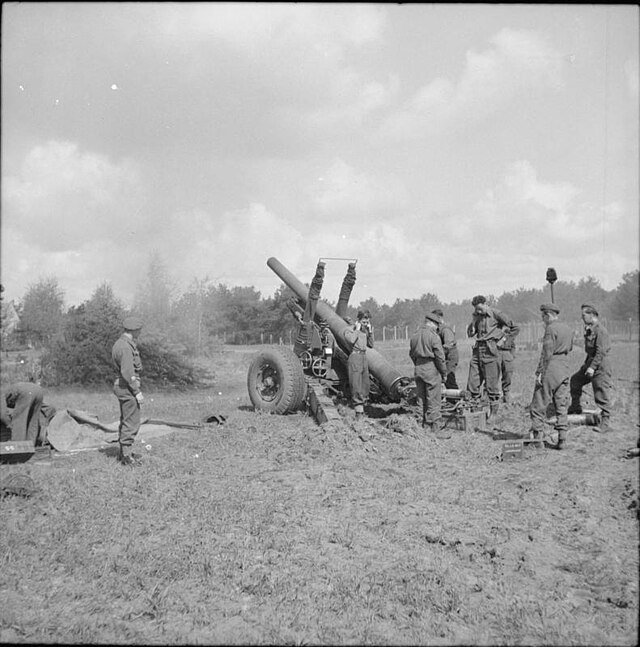 Photo: German civilians stand around as men of the 35th Division, 9th U.S. Army, line up for coffee and doughnuts at Sandbeindorf, Germany. 24 April, 1945 Photo: German civilians stand around as men of the 35th Division, 9th U.S. Army, line up for coffee and doughnuts at Sandbeindorf, Germany. 24 April, 1945 Air War over Europe Air War over Europe 417th Night Fighter Squadron, 64th Fighter Wing [attached to First Tactical AF (P)], moves from St Dizier, France to Giebelstadt, Germany with Beaufighters. 15th Tactical Reconnaissance Squadron, 10th Photographic Group (Reconnaissance), from Erfurt to Furth with F-6s; 125th Liaison Squadron, IX Fighter Command (attached to Twelfth Army Group), from Gutersloh to Brunswick with L-5s; 153d Liaison Squadron, IX Tactical Air Command (attached to Twelfth Army Group), from Bad Wildungen to Weimar with L-5s; 422d Night Fighter Squadron, IX Tactical Air Command, from Strassfeld to Langensalza with P-61s. 30 RAF Mosquitos and 7 Lancasters dropped leaflets on 8 POW camps in which British prisoners-of-war were waiting to be liberated. Medical supplies were also dropped at the Neubrandenburg camp, north of Berlin. No aircraft were lost. 40 RAF Mosquitos to Schleissheim airfield, 38 to Pasing airfield and 17 to Kiel, 27 RCM sorties, 19 Mosquito patrols. 1 Mosquito from the Schleissheim raid crashed in Belgium. Italian campaignUnits of both US 5th Army and British 8th Army begin to cross the Po River at several points near Ferrara and to the west. Ferrara is captured. On the west coast, La Spezia falls to the US 92nd Division. German forces are incapable of stopping the Allied advance. Photo: US soldiers in Vallalta, Concordia sulla Secchia, 24 April 1945 Battle of the Atlantic Battle of the Atlantic German submarine U-363 was attacked by a hunter-killer group. During the depth charge attack the periscope was damaged so badly that the boat had to return to base. German submarine U-1107 is sunk by naval land-based aircraft (VPB 103) in English Channel, 48°12'N, 05°42'W. USS 'Frederick C. Davis' was participating in the operation Teardrop, a hunt for snorkel-equipped U-boats in the Western Atlantic and was part of the 4th Escort Division, which screened escort carrier USS 'Bogue' in the Southern Surface Barrier. On 24 April 1945, 'U-546' discovered the USS 'Bogue' about 570 miles east of Cape Race, Newfoundland and tried to attack on periscope depth, but the USS 'Frederick C. Davis' discovered the U-boat and prepared herself for an attack. At this moment a Gnat struck forward on the portside. The ship broke in two and sank. The crew abandoned ship and were picked up within three hours by the other escort destroyers of the Division, after they had sunk 'U-546'. Photo: A liferaft carrying survivors from German submarine U-546 in the midst of a group of U.S. Navy destroyer escorts, 24 April 1945 German U-boats sink 5 Allied supply ships in the English Channel. At 1414, the unescorted 'Monmouth Coast' was torpedoed and sunk by 'U-1305' about 80 miles from Sligo. The master, 13 crewmembers and two gunners were lost. Irish fishermen rescued the sole survivor, messroom boy Derek Cragg. GermanyPhoto: The Kölner Dom (Cologne Cathedral) stands seemingly undamaged (although having been directly hit several times and damaged severely) while entire area surrounding it is completely devastated. The Hauptbahnhof (Köln Central Station) and Hohenzollern Bridge lie damaged to the north and east of the cathedral. Germany, 24 April 1945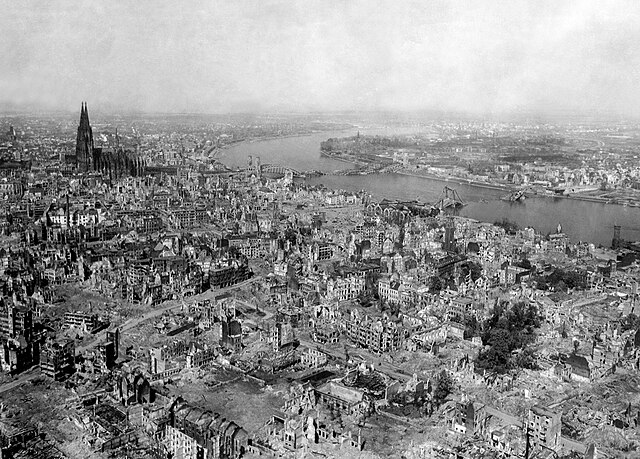 United Kingdom United Kingdom The United Kingdom abolished black-out with the exception of certain coastal areas. Pacific WarCHINA (Fourteenth Air Force): 2 B-24s bomb Hongay, French Indochina railroad yards and attack targets of opportunity in S China Sea. In China, 2 B-24s damage a vessel at Bakli Bay on Hainan; 4 B-25s hit railroad targets of opportunity from Siaokan to Sinyang while 2 damage a bridge at Kuanshuishih; 50+ P-51s, P-61s, and P-40s attack rivercraft, railroad targets, trucks, bridges, troops, horses, and other targets of opportunity at numerous S and E China locations as pressure by allied air and ground forces mounts against enemy movement and supply routes. INDIA-BURMA (Tenth Air Force): In Burma, about 40 P-47s and P-38s attack troop concentrations, storage areas, vehicles, and targets of opportunity in the Mong Nawng vicinity, W of Mong Kung-Laihka road, S of Loilem, and at Wan Hsan; transports land or drop 747 tons of supplies at advance bases and in frontline areas. The 71st and 115th Liaison Squadrons, Tenth AF [attached to 1st Liaison Group (Provisional)], move from Myityina, Burma to Dinjan, India (air echelons remain at Myitkyina with UC-64s, L-1s, L-4s and L-5s until May). TINIAN AAFPOA (VII Fighter Command): HQ 506th FG and the 457th, 458th and 462d Fighter Squadrons arrive at North Field from the US with P-51s. (Twentieth Air Force): Mission 96: 101 B-29s strike the Hitahi aircraft plant at Tachikawa; 21 others hit alternates and targets of opportunity; they claim 16 Japanese aircraft; 5 B-29s are lost. SOUTHWEST PACIFIC AREA [Far East Air Force)]:On Formosa, A-20s hit sugar refineries at Mizukami and Shinei while B-24s bomb Tainan and Hokko. Other B-24s bomb Tabanio and Miri. PHILIPPINE CAMPAIGN (1945) A-20s and fighter bombers continue to strike in support of ground forces on Luzon. Photo: General view of Forward CP of "D" Co., 1st Bn., 511th P.I., 11th Airborne Div. Mt. Malapuno area, Luzon, P.I. 24 April, 1945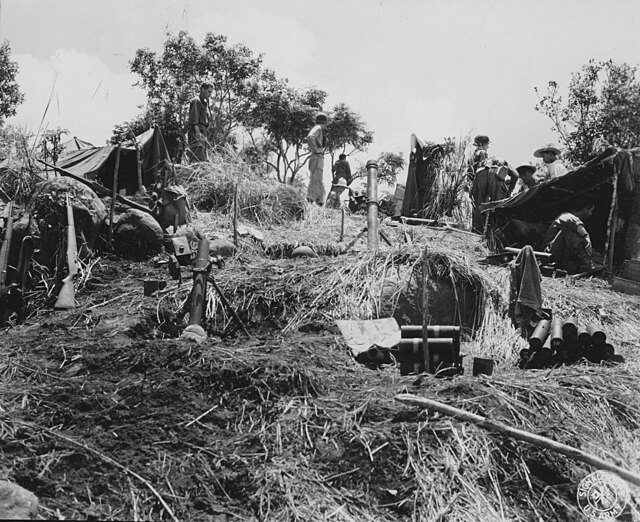 VOLCANO AND RYUKYU ISLANDS CAMPAIGN On Okinawa, Japanese forces defending the Shuri Line, in the south, begin tactical withdrawals. Photo: Framed by the silhouette of an alert soldier, tons of water and coral are blown skyward by the force of a charge set to deepen a channel through a reef offshore, Okinawa, 24 April, 1945 UNITED STATES NAVY DEPARTMENT COMMUNIQUES, CINCPOA COMMUNIQUÉ NO. 342, APRIL 24, 1945 The Twenty‑Fourth Army Corps continued the attack against enemy lines in the southern sector of Okinawa on April 23 (East Longitude Date). Elements of the Seventh Infantry Division captured an important enemy position on high ground west of Ishin Village. Enemy opposition was heavy along the entire front. Marines of the Third Amphibious Corps were engaged in mopping up remnants of the enemy on Yagachi Island north of Motobu Peninsula on April 23. On the same date, Third Corps troops occupied Heanza Island east of Katchin Peninsula and Kouri Island, north of Motobu Peninsula, finding no opposition. On April 24, ships of the U. S. Pacific Fleet delivered heavy gunfire in support of the attacking troops in the Twenty‑Fourth Corps sector. Numerous caves were closed and blockhouses, pillboxes, trenches and gun emplacements were destroyed. Adverse weather reduced air operations and there was no enemy aircraft activity over the area during the day. Search aircraft of Fleet Air Wing One sank two small cargo ships and one motor torpedo boat and damaged two torpedo boats east of the Ryukyus on April 23. On the following day search planes of the same Wing strafed building and radio installations in the northern Ryukyus and damaged a number of small craft. Carrier aircraft from units of the British Pacific Fleet strafed and bombed runways, airfield structures, barracks and other installations on islands of the Sakishima group on April 20 encountering no enemy air opposition. On April 23, Liberators of the Strategic Air Force bombed installations on Marcus Island. Iwo based Mustangs of the same force bombed and strafed storage dumps on Chichi Jima in the Bonins on April 24. PACIFIC Carrier-based aircraft bomb enemy installations on Okino Daito Jima, Ryukyus. Off Okinawa, escort carrier Steamer Bay (CVE-87) and destroyer Hale (DD-642) are damaged in collision, 24°48'N, 131°58'E. High speed transport Horace A. Bass (APD-124) sinks Japanese submarine RO 109, 280 miles south-southeast of Okinawa, 21°58'N, 129°35'E. Submarine Cod (SS-224) sinks Japanese minesweeper W.41 north of Keelung, Formosa, 26°10'N, 121°30'E. USAAF B-24s bomb Japanese shipping at Saigon, French Indochina, sinking transport Kaiko Maru. USAAF B-24s on anti-shipping sweep of Makassar Strait sink Japanese Shuttle Boat No.302 off Salinguigan Island 02°19'S, 117°14'E. Japanese cargo vessel Sano Maru is damaged by mine in Yangtze River near Nanking.
|
|
























































































































































































